
- Expeditions
- Conservation

Emperor Penguins of the Bellingshausen Sea
Onboard le commandant charcot.
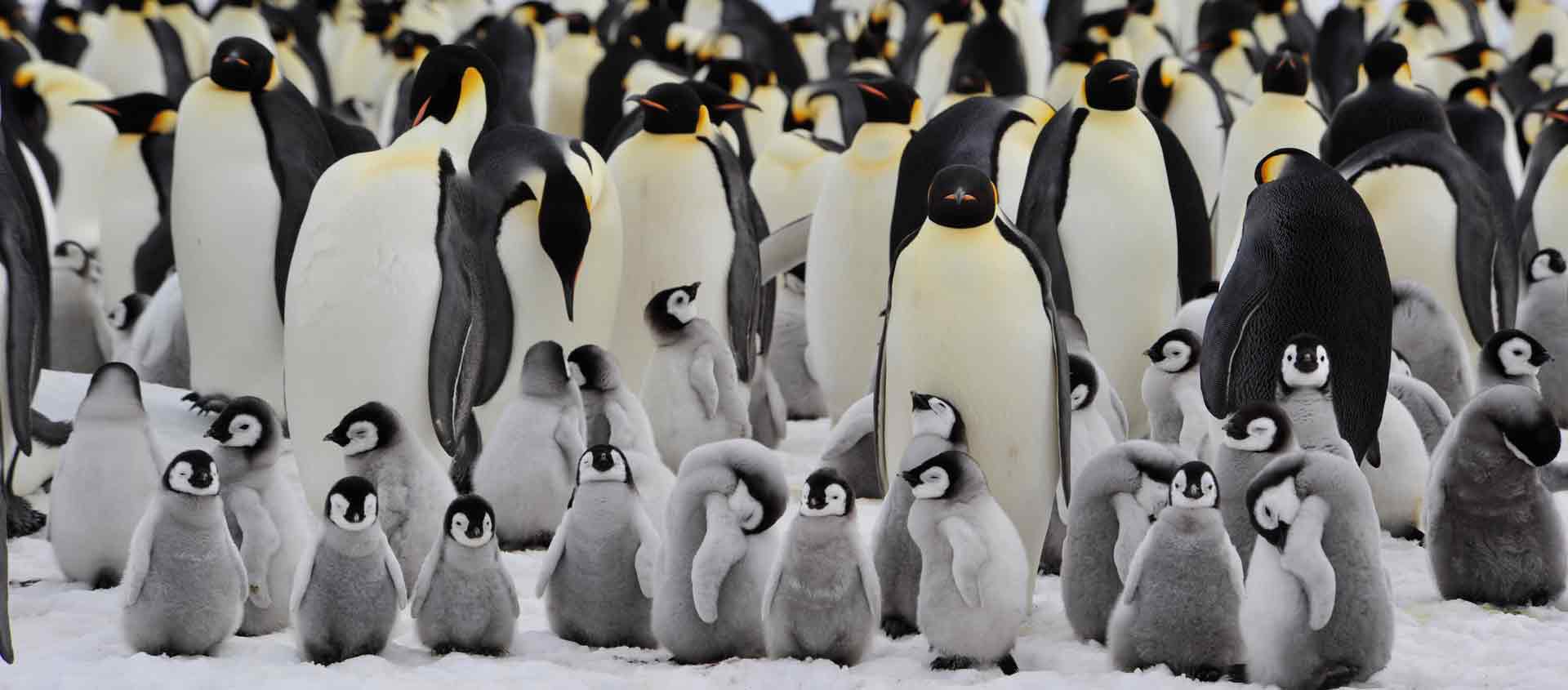
Emperor Penguins survive the harsh winters in Antarctica equipped with four layers of scale-like feathers that protect them from icy winds and provide a waterproof coat.
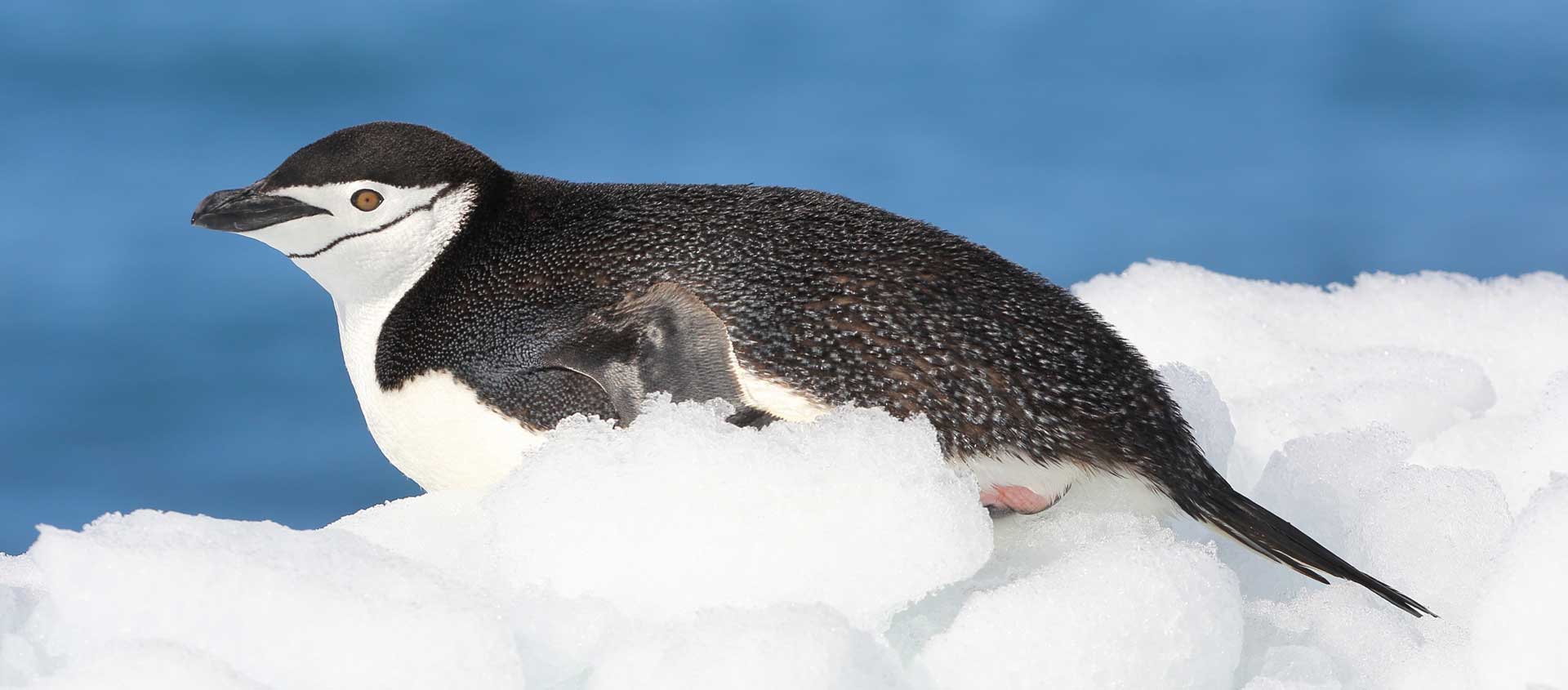
Chinstrap Penguins, identified by the black stripe under their chin, may be the most abundant penguin, with a population estimated at 7.5 million breeding pairs. © Jonathan Rossouw
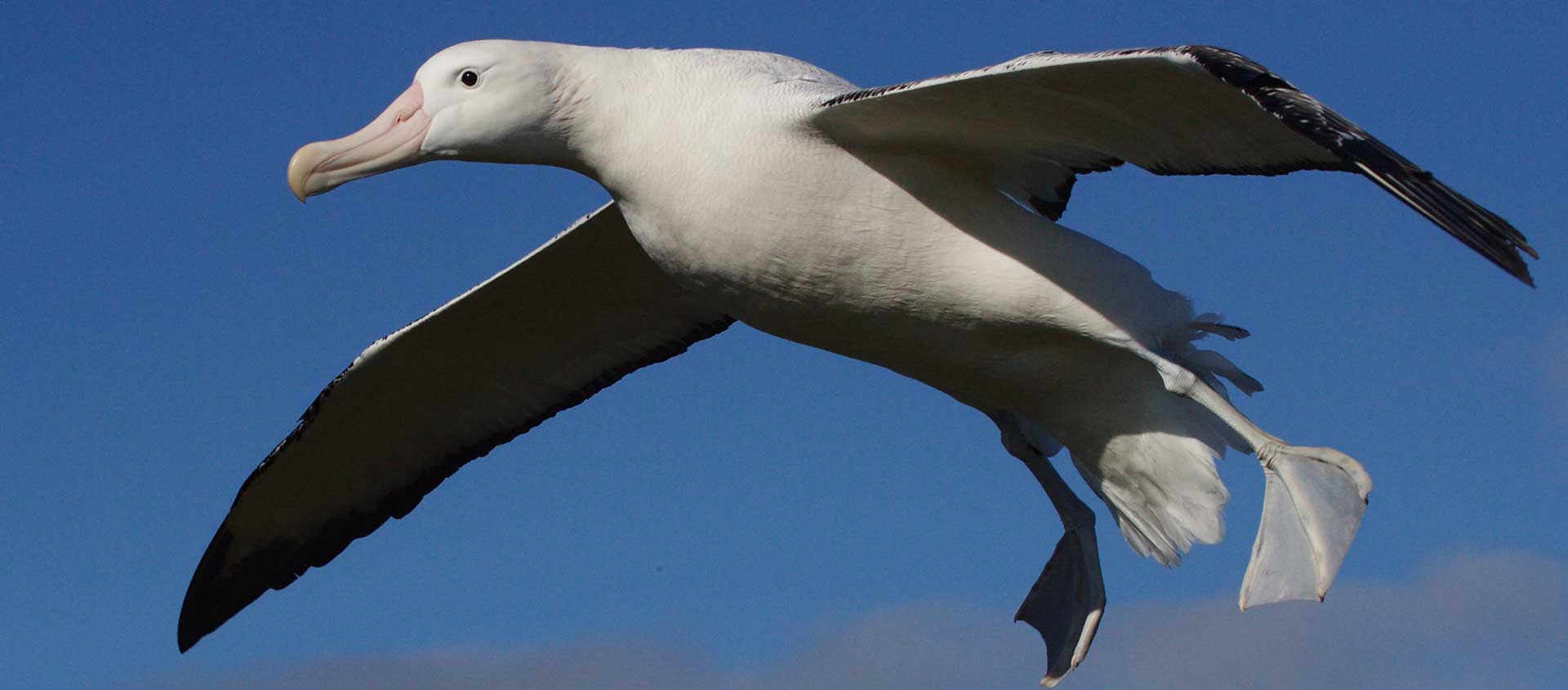
With the largest wingspan of any bird, the Wandering Albatross can soar through the sky without flapping its wings for hours at a time. © Peter Harrison
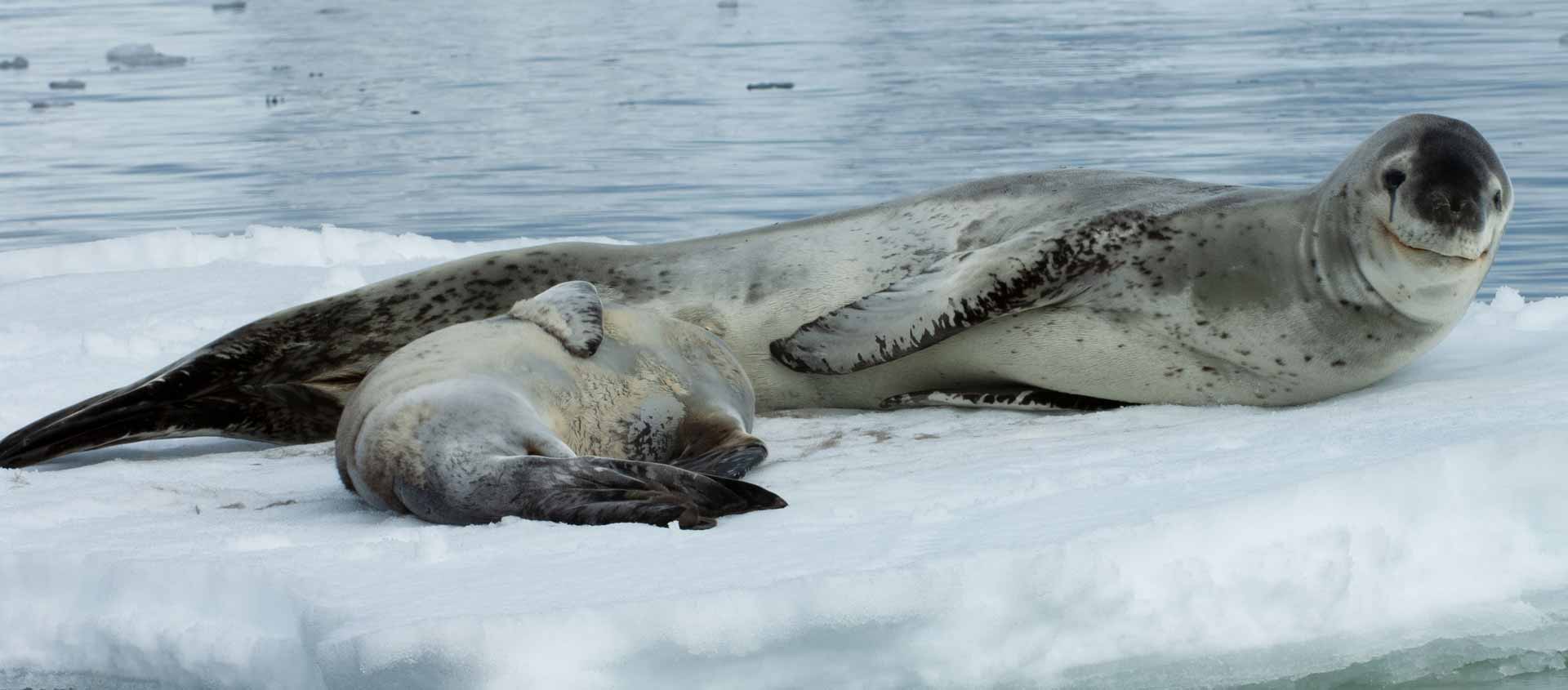
Named for the pattern of black spots on their bodies, Leopard Seals are the only member of the seal family that eats other types of seals. © Shirley Metz
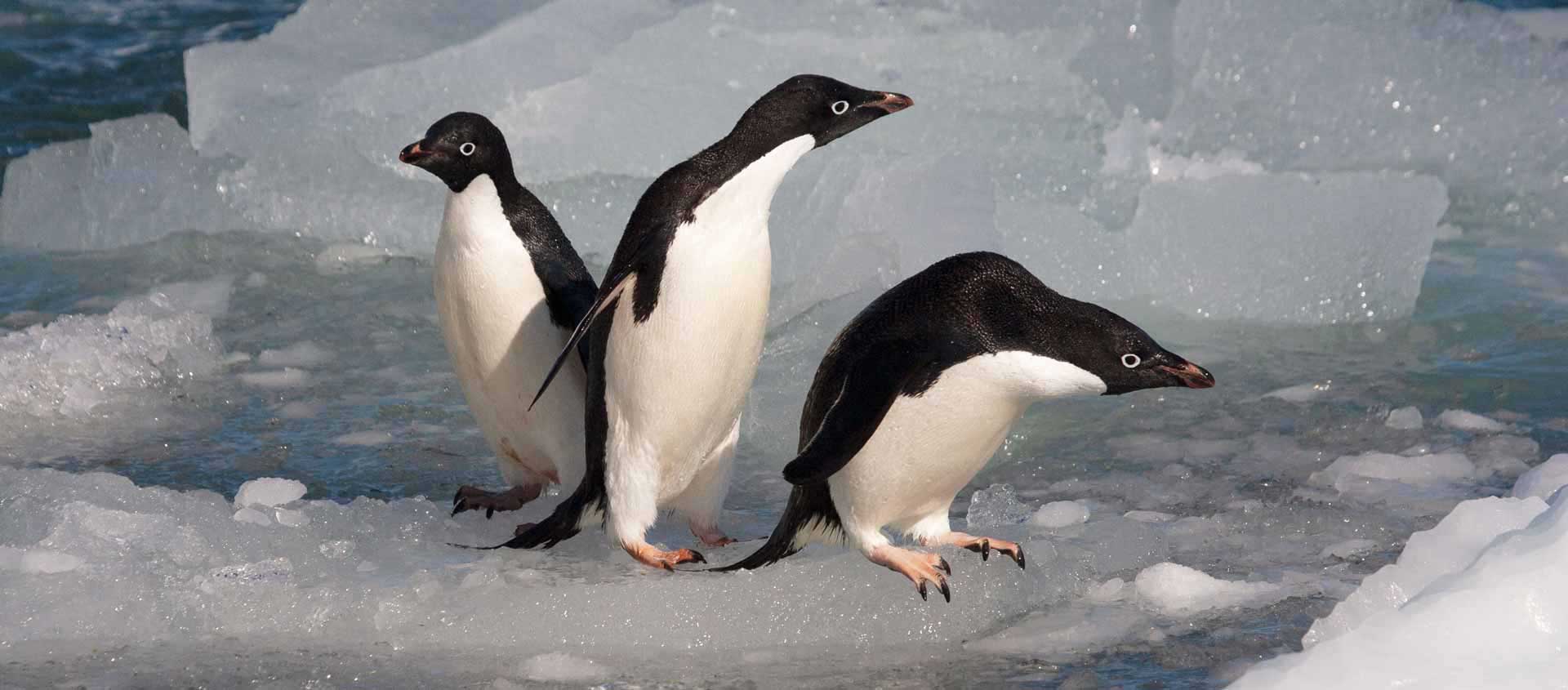
Adélie Penguins are the smallest of the Antarctic penguins. They have a black head and will develop white eye rings during their breeding season. © Peter Harrison
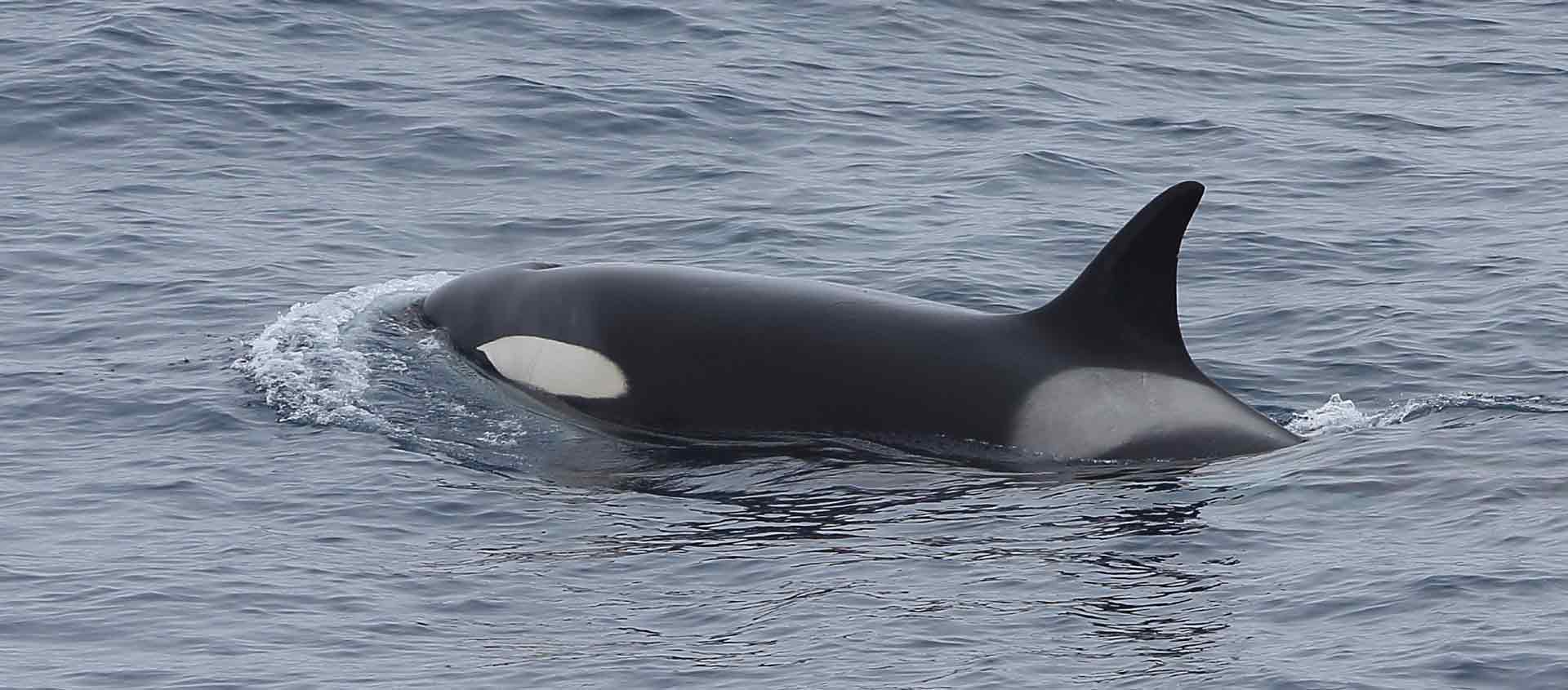
The Orca, also known as Killer Whale, is the largest member of the dolphin family. Considered an apex predator, they often use a coordinated hunting strategy to catch prey. © Jonathan Rossouw
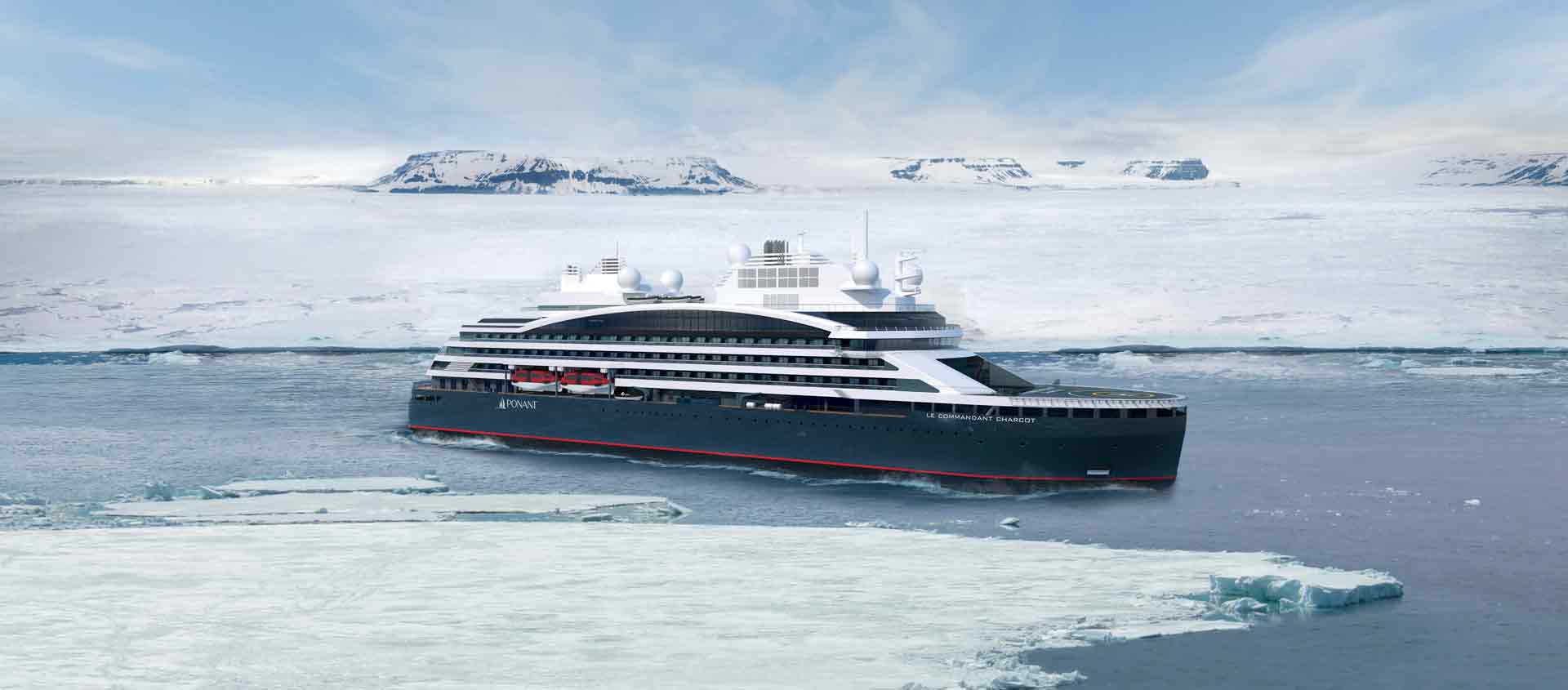
Le Commandant Charcot is a brand-new hybrid electric icebreaker, the world’s first luxury polar exploration vessel, and first PC2-class polar cruise ship. © Stirling Design International
Emperor Penguin Cruise South of the Antarctic Circle
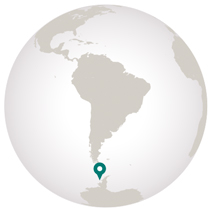
Destinations
- Travel by Air
- Travel by Road
- Travel by Boat
- Travel by Bullet Train
- Travel by Rail
- Travel by Dog Sled
- Days 18 & 19
Sunday, October 31: Arrive Santiago, Chile
Upon arrival in Santiago you will be met and transferred to your hotel. Explore this stately capital city at your leisure, taking in the museums, grand architecture and pedestrian malls of the Centro, and the gorgeous hillside parks that dot the urban landscape. Enjoy a drink and snack at one of the many sidewalk eateries and cafés of Barrios Brasil, Lastarria and Bellavista. This evening, meet your fellow travelers and expedition team over drinks and a welcome dinner at your hotel.
Monday, November 1: Santiago / Puerto Montt / Embark Le Commandant Charcot
After breakfast, head to the airport for a charter flight due south, to the capital of Chile’s Lake District, Puerto Montt, perched on the northern end of Reloncaví Sound. Tour the town, seeing relics of its German colonial past at the Plaza de Armas and neoclassical cathedral. Enjoy lunch at one of Puerto Montt’s many world-class restaurants, before embarking your home away from home for the next 18 nights, Le Commandant Charcot. Settle into your cabin and be sure to be on deck as you set out into the sound and toast to the voyage ahead. Natural history buffs will be on the lookout for Blue Whales, Magellanic Penguins, and the enigmatic Pincoya Storm-Petrel, a species discovered by Peter Harrison as recently as 2011. Dinner and overnight aboard Le Commandant Charcot.
Tuesday–Thursday, November 2–4: At Sea
Le Commandant Charcot is the world’s first luxury polar exploration vessel and the first PC2-class polar cruise ship, capable of sailing into the very heart of the ice, on frozen waters that are usually inaccessible to ordinary ships. Become acquainted with this agile 500-foot hybrid electric ice breaker as you navigate toward the Southern Ocean. Attend lectures that will introduce you to the Antarctic, its explorers and the wildlife, with a special emphasis on the Bellingshausen Sea.
As you head south into ever-higher latitudes, your daily wildlife sightings will be constantly changing. Off the South American mainland, expect a plethora of albatrosses ranging from Wandering and Royal Albatrosses to Buller’s and Black-browed. Further south Pintado Petrels and Southern Fulmars will be your constant companions. Be on deck with your naturalists to learn their fascinating life histories—many live to be 30 or more years of age and never leave Antarctica.
Friday, November 5: Crossing the Antarctic Circle
Most ship visits to Antarctica are well north of the Antarctic Circle; on this voyage, however, “the Crossing of the Circle” is of paramount importance. Weather permitting, you will cross the renowned Antarctic Polar Circle today, located along 66°33’ south of the Equator. This iconic line demarcates the point from which it is possible to view the midnight sun during the December solstice. Within this circle, the sun remains above the horizon for 24 consecutive hours at least once a year.
Saturday, November 6: At Sea
Spend as much time on deck as possible; ice will be all around, from brash and floe ice to towering spires and monster superbergs, some literally miles long. This is the home of Snow and Antarctic Petrels, two species that are almost never seen away from Antarctica. As you press ever deeper into the ice, your eyes now search for the world’s most difficult-to-see bird species, the resplendent Emperor Penguin, largest of all penguins and heaviest of all seabirds.
Sunday–Monday, November 7-15: Bellingshausen Sea
NOTE: In the spirit of expedition travel, flexibility is key, and your expedition leader will determine the best course each day. Taking into account the weather, ice conditions and wildlife activity, we hope to spend time at the following locations:
Charcot Island In 1910, Jean-Baptiste Charcot set his sights on this small island, trying numerous times to approach it. He was never able to get closer than 40 miles due to the thick sea ice in the area. With its frequent low-pressure systems, regular cloud cover, and near-total ice covering, Charcot retains its mystery to this day. The ice lets up over a few miles in the far northwest of the island, giving way to rocky outcroppings, which are home to throngs of checkered Pintado Petrels and dashing Southern Fulmars. You’ll also keep watch for Chinstrap and Adélie Penguins, and your first South Polar Skuas, the only bird species to have reached the South Pole. Very few people have landed on the island due to ice coverage, but in recent years, the ice in the narrowest part of Wilkins Sound has been breaking up, thus officially detaching Charcot from its larger neighbor, Alexander Island, lying 30 miles away.
Peter I Island (Norwegian Territory) Due west of Charcot lies the legendary Peter I Island, discovered in 1821 by the Russian explorer Fabian Gottlieb von Bellingshausen, who named it in honor of Peter the Great. The island is a breeding ground for Southern Fulmars and Antarctic Terns. Adélie and Chinstrap Penguins have also been spotted here. With about 95% of its surface covered by ice, this volcanic island, whose highest peak reaches 5,300 feet, is protected by ice cliffs some 130 feet tall, making any approach difficult. Weather permitting, you may attempt to be one of the few hundred souls who have ever set foot here.
English Coast Located on the west coast of Palmer Land, which makes up the southern half of the Antarctic Peninsula, the English Coast is home to a large rookery of Emperor Penguins. The penguins are accessible by foot, one of the rare places they can be reached without a helicopter. Make the challenging (but relatively short) trek over a magnificent desert of pack ice, and you will find yourself among these famed and awe-inspiring creatures – the largest of all penguin species. This time of year, as winter gradually gives way to the austral spring, the weeks-old chicks are just beginning to find their independence and gather in immense “crèches.” Watch them huddle together, braving the harsh conditions. It is a rare, moving and intense experience, one you will not soon forget.
Marguerite Bay Named by Charcot in honor of his second wife, this bay is one of the most beautiful regions in Antarctica, with magnificent icebergs scattered as far as the eye can see. Minke and Humpback Whales and Orcas frequent its intense blue waters, and Weddell and Crabeater Seals are often found hauled out to rest, along with predatory Leopard Seals and the assertive Antarctic Fur Seal. Adélie Penguins can be spotted on the sea ice. Here, you can see mountainous Adelaide Island to the north, the Fallieres Coast to the east, and Alexander Island to the south.
Stonington Island Home to former US and British research bases, the small island of Stonington lies in the northeastern part of Marguerite Bay. Several dog sledge expeditions started here, enabling researchers to map a significant portion of the Antarctic Peninsula. Vestiges of their two-story steel-framed buildings are still visible. The island is now an important breeding ground for Antarctic Terns and South Polar Skuas.
Pourquoi Pas Island Named in the 1930s in honor of Jean-Baptiste Charcot’s ship, this small island in the north of Marguerite Bay is known for its tight fjords and lofty, glacier-crowded mountains. Conditions permitting, take a Zodiac ashore and observe an Adélie Penguin colony up close. Adélies are the earliest of Antarctica’s springtime-nesting species and early November is the perfect time for a visit. Neighbors will be stealing stones from each others’ nests, pairs will be reuniting after the long winter, young birds will be looking for mates—all resulting in a noisy bedlam of frenetic energy as the penguins begin yet another breeding season.
The Gullet Between Adelaide Island and Graham Land—the northern portion of the Antarctic Peninsula— this narrow channel leads north out of Marguerite Bay and offers jaw-droppingly beautiful scenery, reminiscent of an ice palace, with immaculate white walls on each side reflected in the mirror-like waters. This passage was first explored by Charcot in 1909, and it is here that some of the first subaquatic images of the Antarctic were shot during Philippe Cousteau’s four-month expedition to Antarctica in 1972. This is an excellent area to look for Emperor Penguins on ice and bands of Adélie Penguins, as they commute between colonies and feeding grounds.
Detaille Island Behold this tiny, sheltered island in Crystal Sound. There’s a small rookery of Adélie Penguins living here, but the real attraction of Detaille is its abandoned British station. Base W was operational between 1956 and 1959, after which it was hurriedly evacuated when its supply ship became blocked by ice. The personnel had to leave on foot across the pack ice, abandoning most of their gear. Base W is now an official Antarctic Historic Site, open for visitors. The living quarters stand exactly as they were left—scientific equipment, books, clothing, even tins of food still lie about. The station is a veritable time capsule of mid-century life at an Antarctic research station.
Tuesday, November 16: At Sea
This will be your last day with ice and those that call it home. Be on deck to search for Snow and Antarctic Petrels that use icebergs as loafing and roosting stations. Sharp-eyed observers will also see sparrow-sized Wilson’s Storm-Petrels, birds that can fit in the palm of your hand, yet are trans equatorial migrants capable of flying many thousands of miles each year. Over cocktails, your lecture team will recap the events of the past days and share images and stories of your Antarctic adventure.
Wednesday & Thursday, November 17 & 18: Drake Passage
Spend the next two days crossing the Drake Passage. Here lies the Antarctic Convergence Zone, formed by the confluence of north-flowing cold waters and warmer sub-Antarctic seas. Not only do sea conditions converge here, but avian life does too. Wandering, Grey-headed, Black-browed and Light-mantled Sooty Albatrosses, Cape Pigeons, Southern Fulmars, Wilson’s Storm-Petrels, Blue and Antarctic Petrels may all be seen floating playfully in the wind around the ship.
Friday, November 19: Ushuaia, Argentina / Disembark Le Commandant Charcot / Santiago / Depart
Nicknamed “El Fin del Mundo” by Argentinians, Ushuaia claims to be the southernmost city in the world, and is a true sight to behold, nestled in a crook where the Andes plunge into the sea. It is a fittingly dramatic place to end your Antarctic adventure. Disembark the ship and transfer to the airport for your charter flight to Santiago, then on to your international flights home.
Have a question? Call us at 206.669.9272 / 800.861.6425 . Prefer online?
A Year in the Life of an Emperor Penguin
Never miss an update! Subscribe today and be the first to know about new adventures.
- Apex Founders
- Expedition Gear
- Meet our Leaders
- Privacy Policy
- Terms & Conditions
Check out this great article on the joy of traveling from Expedition Leader, Peter Harrison
- Environment
- Road to Net Zero
- Art & Design
- Film & TV
- Music & On-stage
- Pop Culture
- Fashion & Beauty
- Home & Garden
- Things to do
- Combat Sports
- Horse Racing
- Beyond the Headlines
- Trending Middle East
- Business Extra
- Culture Bites
- Year of Elections
- Pocketful of Dirhams
- Books of My Life
- Iraq: 20 Years On
The seven best places in Antarctica to see penguins
'the attenborough effect' has sparked a flurry of expedition cruises to see the flightless birds.
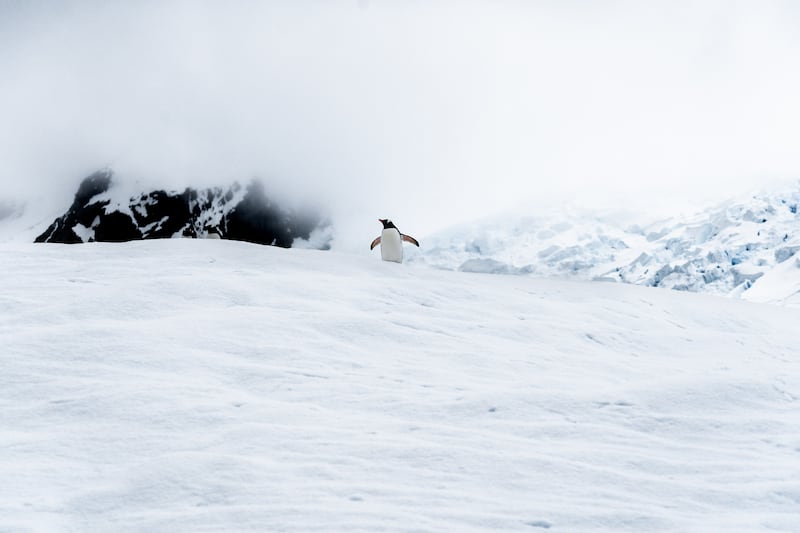
The Attenborough effect has sparked a flurry of Antartic cruise bookings says Panache Cruises. Photo: Unsplash / James Eades

Penguin-spotting in Antarctica is one of the highlights of an expedition cruise to the world's highest, driest and coldest continent.
Home to several species of the flightless birds, with half of the world's 18 species of penguin found on Antarctic coasts and sub-Antarctic islands, the region is gaining in popularity as travellers seek seeing animals in the wild.
Luxury cruise operator Panache Cruises says it has seen a boom in bookings for penguin spotting tours, a trend that it has called "the Sir David Attenborough effect".
“The popularity of David Attenborough’s TV programmes has brought the wonders of penguins to our living rooms and now thousands of us want to see them in their natural habitats," said James Cole, founder and managing director of Panache Cruises.
"Embarking on an expedition cruise to Antarctica is a great way for wildlife-lovers to see the nature in all its glory while enjoying a hassle-free organised tour."
Expedition cruising is one way that nature lovers can access some of the world's remotest areas, and Panache's small ships are designed to have minimal impact on the delicate environment in which they operate. For travellers keen to spot a penguin in the wild, the company has revealed the seven best places to catch a glimpse of the flightless birds.
1. Antarctic Peninsula
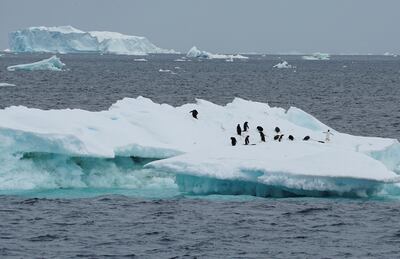
Stretching out more than 1,500km towards the tip of South America, the Antarctic Peninsula is the northernmost part of the continent. It's also one of the most popular and accessible destinations in the region, where travellers will find the greatest variety of wildlife species and the most breathtaking scenery. One of The Peninsula's main attractions is its abundance of penguins, seals and seabirds. It's also the warmest region of the continent, so its where many research stations set up base.
2. Antarctic Sound
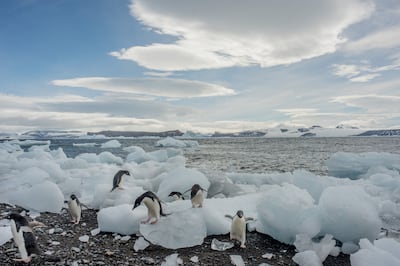
Only 15kms wide at its narrowest part, the Antarctic Sound is a channel at the north-eastern end of the Antarctic Peninsula. Also known as Iceberg Alley, it connects the Bransfield Strait to the Weddell Sea and is one of the best places in the region to see Adelie penguins as more than 135,000 breeding pairs live on Hope Bay. The Sound is also a good place to spot large Emperor penguins, seals and whales.
3. Penguin Island
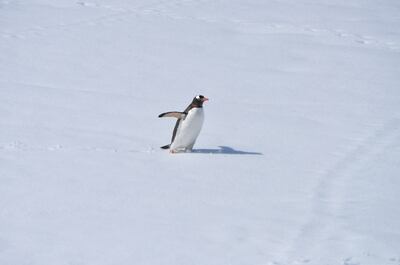
Given its name, it's no surprise this tiny isle is one of the best spots for penguin enthusiasts. Named during an 1820 British expedition because of the vast numbers of penguins that could be seen along its shoreline from the ship as it passed by, the 2km long island is also called Georges Island and is one of the smallest of Antarctic's South Shetland Islands.
It's a nesting and breeding place for Adelie penguins and the often gregarious chinstrap penguins. The animals are protected by a 100-person limit on the shore and visitors are not allowed to roam freely, but guided excursions are offered, including to the 170 metre cone of Deacon Peak, an inactive volcano.
4. Elephant Island
View this post on Instagram A post shared by Camille Seaman Photography (@camilleseaman)
Elephant Island gets its name from the large elephant seals that live there, but it's also home to colonies of gGentoo penguins and nesting chinstrap penguins. Entirely remote, ice-covered and mountainous, the island is one of the most desolate locations in the world, lying 250 kms off the tip of the Antarctic Peninsula. This place is a must-go for polar enthusiasts as this is where Ernest Shackleton and his Endurance expedition crew took refuge for several months in 1916.
5. Deception Island
View this post on Instagram A post shared by Hurtigruten (@hurtigruten)
Deception Island in the middle of the South Shetland Islands is one of the world's most unique tourist destinations. It is a ring-shaped island with a massive crater at its centre, formed by a volcanic eruption. Part of the crater has collapsed, leaving a natural harbour-like formation that's popular with marine life of all sorts.
It's also home to one of the world's largest colony of penguins, with more than 100,000 breeding pairs. The volcano on the island is still active and hot clouds of steam often rise above the shoreline of the black sandy beaches. Travellers can also go swimming here, as the water is warm despite the region's sub-zero temperatures.
6. South Georgia
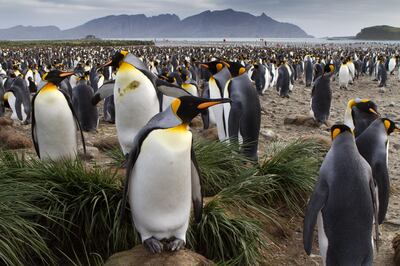
"The Attenborough effect" is perhaps at its strongest in South Georgia, where the British broadcaster narrates the region's visitors guide. Known as the "Gateway to Antarctic", South Georgia is located 2,000 kms off the tip of South America, surrounded entirely by the southern Atlantic Ocean.
The region is recognised for its biological importance, biodiversity and breeding populations of seabirds and marine mammals, including petrels, seals, whales, albatross and plenty of penguins. The region has featured in several documentary series, including Frozen Planet , Blue Planet and Planet Earth .
7. Drake Passage
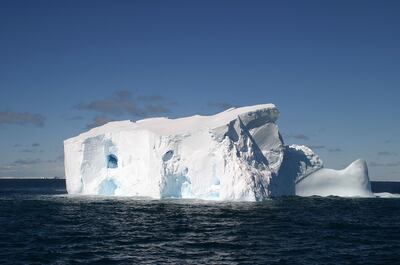
Named after English explorer Sir Francis Drake, despite the fact he never sailed through his namesake waters, the Drake Passage provides a connection between the Atlantic and Pacific Oceans. Known for its rough seas and one of the primary routes to Antarctica, it's also where travellers can spot a variety of marine life. Its waters are rich in plankton, which attracts whales, seals and ever-popular emperor penguins.

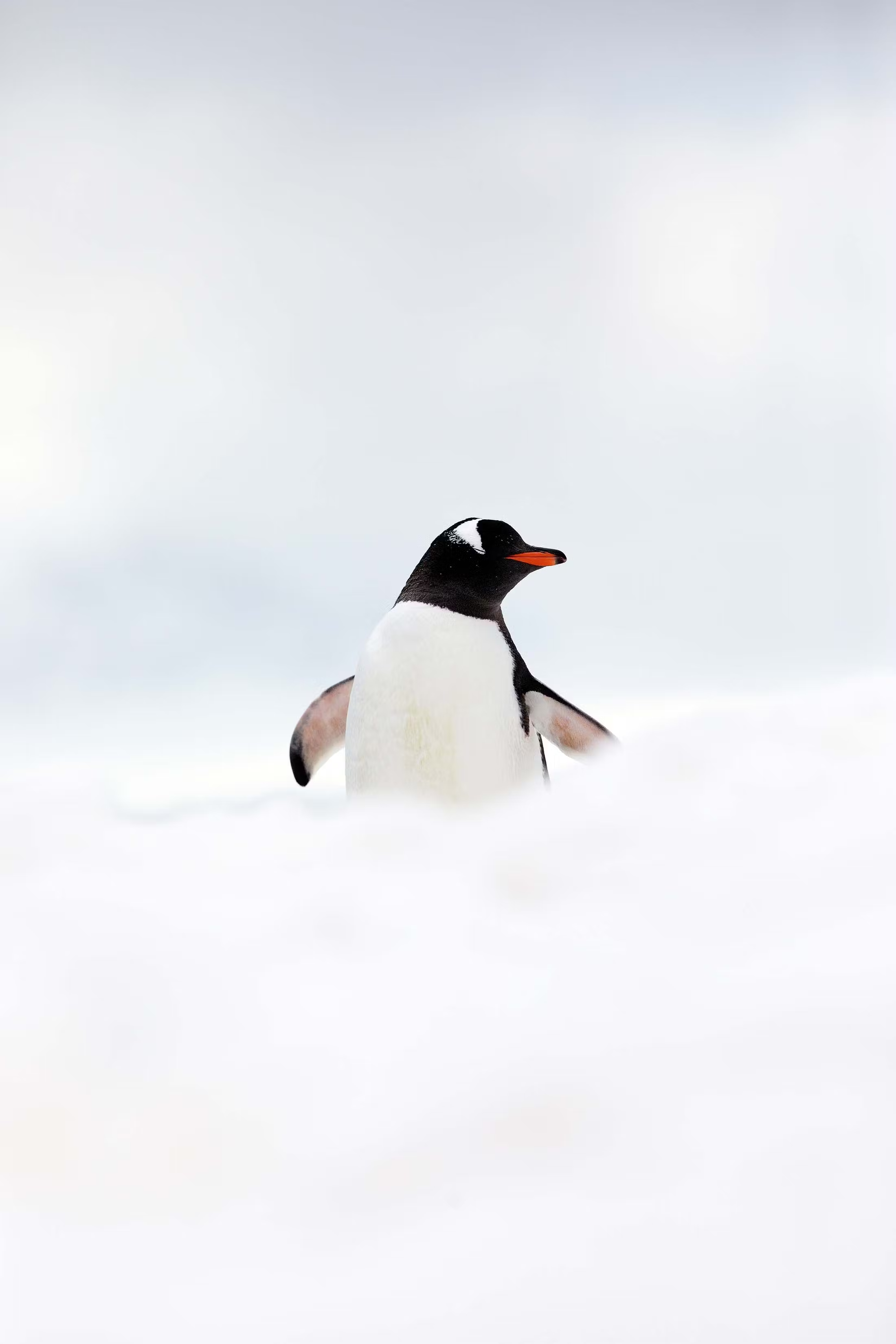
Penguins in Antarctica: Types, Facts and How to See Them
- Expedition cruise
- polar cruise
“In Antarctica, penguins breed out in the open,” says Dr. Martin Renner, expedition ornithologist for Silversea. “They don’t hide in burrows. They are approachable. We always adhere to the recommended safe distances to not disturb them. They are great to watch.”
This is Renner’s 10th expedition to Antarctica , and he is still as fascinated by penguins as the wide-eyed visitors around him. His primary role: to educate guests on the life, anatomy and breeding cycles of the birds. His passion isinfectious.
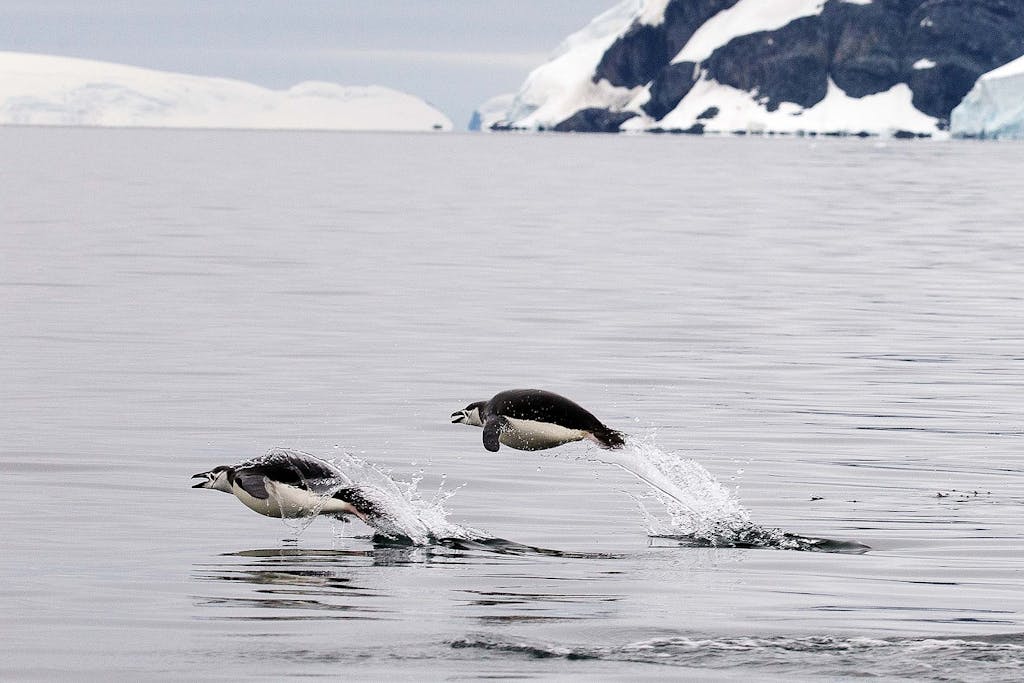
With this in mind, it is no wonder that I am standing with a beaming Renner at a Chinstrap breeding ground in the South Shetland Islands on the aptly named Half Moon Island. This ruggedly beautiful, crescent-shaped landscape is home to a colony of approximately a thousand Chinstraps.
It is February, which is late summer on the Antarctic Peninsula. Within the colony, penguin pairs —one male and one female— take turns looking after their chicks. Sharing these duties is standard behavior with all three species.
Chinstraps mainly lay two eggs per season, much like the Gentoos, so there are plenty of fluffy, gray mouths to feed here. Some chicks, around eight weeks old, are molting. It’s a frustrating period for them because while parents go out to sea foraging, the chicks stay behind. Molting is an uncomfortable and energy-extracting process.
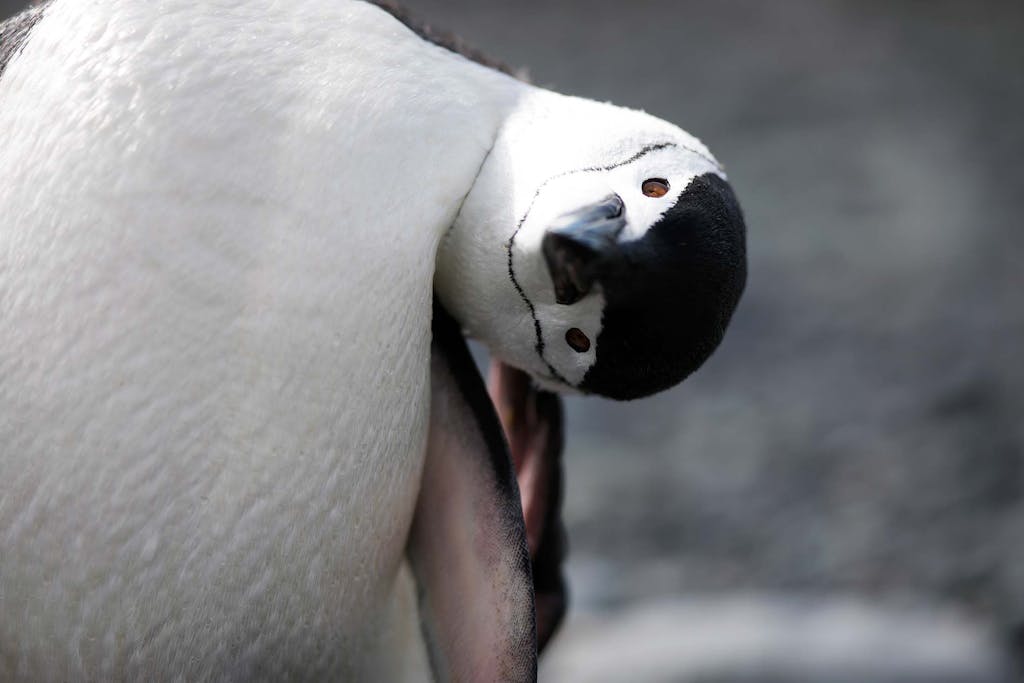
The regular expedition season runs from late November until early March. Throughout this time, you can see an essential part of the penguin lifecycle —from courtship to fledging— taking place. “Choosing when to travel is dependent on what one hopes to witness,” says Renner.
“The Antarctic penguins arrive early in spring, between September and October, to find their mate and establish a nest after spending the winter at sea. I like the early season. While eggs don’t look as cute as chicks, there are some birds still showing the full range of courtship behaviors like nest building, pebble stealing to build nests, and sometimes even mating.”
How many types of penguins are there in Antarctica?
You’ll find three main species of penguins in Antarctica: Adéle, Gentoo and Chinstrap penguins, collectively known as the brush-tails , or Pygoscelis. These three species are similar in size and body but differ in the coloration of the head.
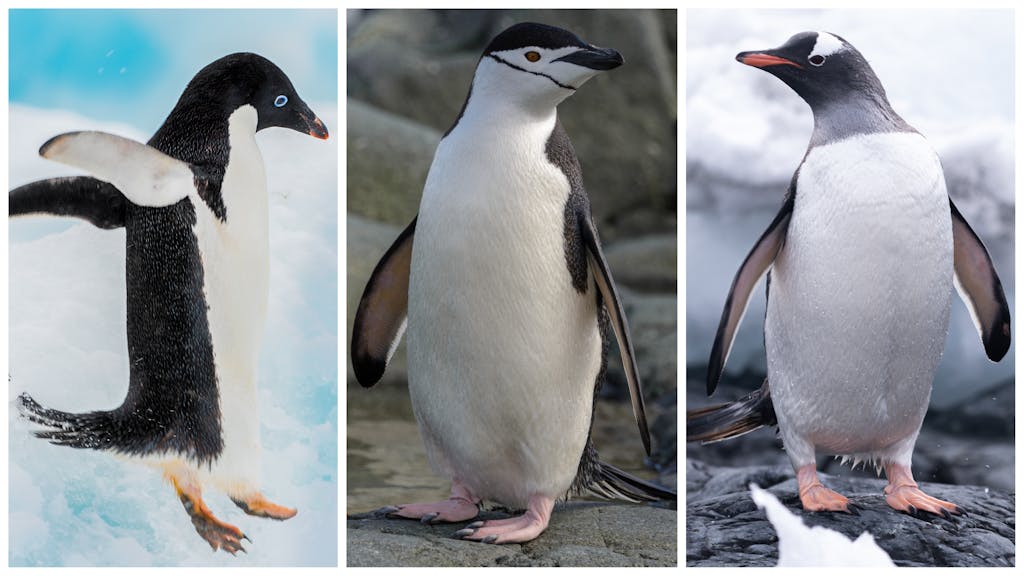
The Adéle penguin lives in coastal areas; the other two species live inland. Penguins are one of the world’s smallest birds, some weighing as little as 3 or 4 pounds. They also are known for their ability to dive deeply to catch fish. It breeds the farthest south of all brush-tailed penguins. There aren’t many accessible Adélie colonies along the Peninsula, but the few we can see are huge.
“Adélies are the quintessential penguin,” Renner says. “Their eye is accentuated by a white eye-ring, allowing for all sorts of fancy facial expressions.”
Renner confesses that his favorite is the Chinstrap “for their simple elegance.” A band of black feathers from one side of the head to the other gives the species its name, but the configuration adds a puckish look to this species. Its bill is black and its eyes are ringed by black.
Gentoos are easy to recognize by their orange bills and white eye-patch that runs over the head. They are the most widespread species along the Peninsula and, therefore, virtually guaranteed. The Chinstrap has a white face and stands out, thanks to the dark line under the chin that suggested its name. The species lives mainly on the islands of the Scotia Arc made up of South Georgia, South Orkney, South Sandwich and the South Shetland Islands. They also thrive in a few areas along the Antarctic Peninsula.
Where to see Adelie penguins in Antarctica
The best place to see penguins in Antarctica also is at Cape Royds Station. This station is near the Ross Ice Shelf, one of the largest ice shelves in the world. You also can see Adelie penguins at McMurdo Station, Scott Base and Amundsen–Scott South Pole Station.
Where to see Gentoo penguins in Antarctica
The best place to see Gentoo penguins in Antarctica is at Cape Royds Station, which is near Ross Island and also home to Emperor penguin colonies. You also may Gentoos in the South Shetland Islands and King George Island.
Where to see Chinstrap penguins in Antarctica
The best place to see chinstraps penguins is at Cape Royds, which is located near Ross Island. This is one of the most popular places for tourists to visit in Antarctica.
Other types of penguins you may see
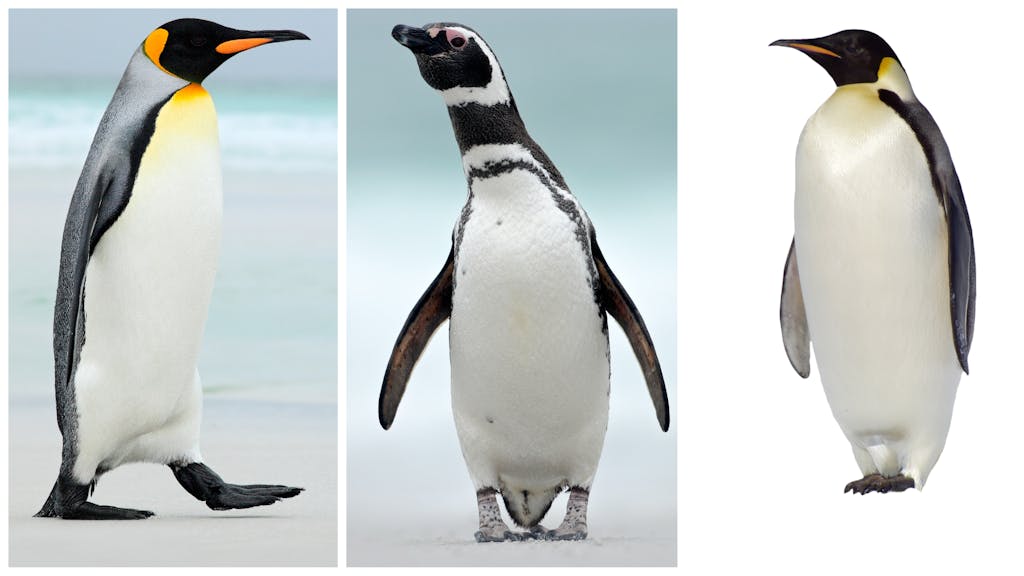
If you’re lucky, you may check off at least one more en route: the Magellanic penguin found in the waters of the Beagle Channel at the southern tip of South America. King Penguins , a species of the sub-Antarctic islands, live around the Falklands, South Georgia and Australia’s Macquarie Island. The Emperor, the largest of the penguins, typically breeds in the far south during winter. Although visitors are unlikely to encounter Emperor Penguins along the Peninsula during the summer, there is a colony at Snow Hill Island which is sometimes visited during a Silversea cruise.
When to see Antarctic penguins

The regular expedition season runs from late November until early March. Throughout this time, you can see an essential part of the penguin lifecycle — from courtship to fledging — taking place. “Choosing when to travel is dependent on what one hopes to witness,” says Renner.
How Chinstrap penguins chicks give chase
As we speak, quiet tapping begins in front of us. A Chinstrap chick asks for food from a parent while his fluffy gray sibling flops quietly on the ground next to the commotion. Renner has already briefed me that the constant tapping stimulates the regurgitation of food from the parent. The adult penguin ducks its head back and forth in avoidance before running away from the chick, who follows with pure determination.
“Feeding chases are unique and comical. They’re a joy to watch,” Renner says. One parent speedily pads around the muddy, guano-covered rookery. And, having spent several days at sea foraging food, the penguin returns to the colony, climbs the hill and looks for its hungry chicks. “But instead of feeding right away, it encourages its chick to chase it through the colony before finally regurgitating krill. It’s a bizarre behavior that helps reduce interference from the other chick and allows for fair food distribution.”
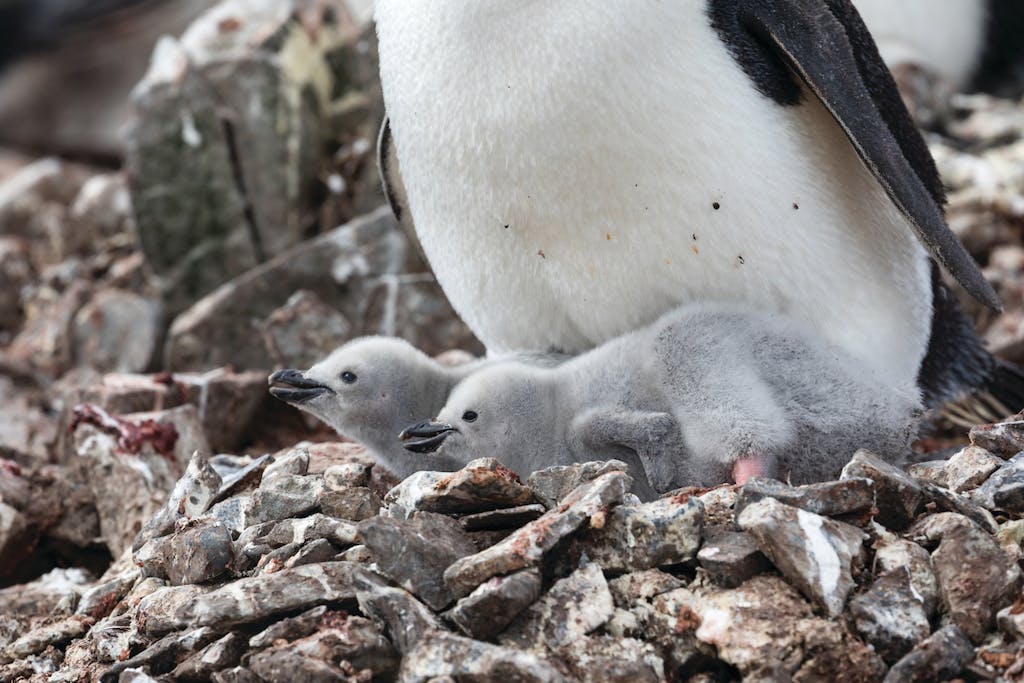
Eventually, the adult stops running to feed its baby. Both birds stand close, open-beaked as though embracing. I see the regurgitated pink krill passed from adult to chick. It is a beautiful moment.
“Good things happen for those who wait,” says Renner. “We are not going to see these behaviors every time. So stand or sit still for a while. Let the birds come up to you and check you out. When [you’re on land] there is human traffic around the colonies, spend extra time near the water and watch penguins jump ashore or head out to sea.”
How to capture penguins in a photograph
Although the International Association of Antarctic Tour Operator (IAATO) guidelines tell us to keep at least 5 meters to 10 meters (16 to 32 feet) from penguins and their colonies, the birds haven’t received the same briefing. For this reason, it is crucial to be aware of your surroundings.
“Give birds the right of way and avoid walking on their ‘highways,’ Renner says. “Move slowly, avoid sudden movements, don’t point at birds with walking poles, and follow the instructions of your expedition team. That’s the way to enjoy their natural behavior.”
Having spent years studying penguins, Renner has taken his fair share of photographs . He tells me it’s best to carry both a wide-angle lens for capturing the landscape of the whole colony and a telephoto lens between 200 and 600mm.
“Most important, whether using a smart-phone or digital SLR, is to get down low if the knees allow,” he adds. “Being eye-level with a penguin allows a deeper connection to the subject.”
Watching penguins in their natural environment and observing their natural behavior is lovely to watch. I hear other guests echoing the sentiment, vowing to come back with their children and grandchildren one day. That evening, as the Expedition Team and guests gather for our daily Recap and Briefing to review the day, Renner ends his presentation on penguin behavior with a touching thought towards the Expedition Leader.
“Thank you,” he says “for the best job in the world.”

On a roll? Learn how to film South Georgia’s king penguin colony .
Karen Edwardsi s an award-winning travel and lifestyle journalist and expedition guide from London. She is the sustainability editor at Wanderlust Travel Media . She specializes in indigenous culture, conservation, remote destinations, as well as ethical and responsible travel. She has contributed features to U.K. titles such as British Airways High Life, Grazia, Sunday Times Travel, In The Moment and more.
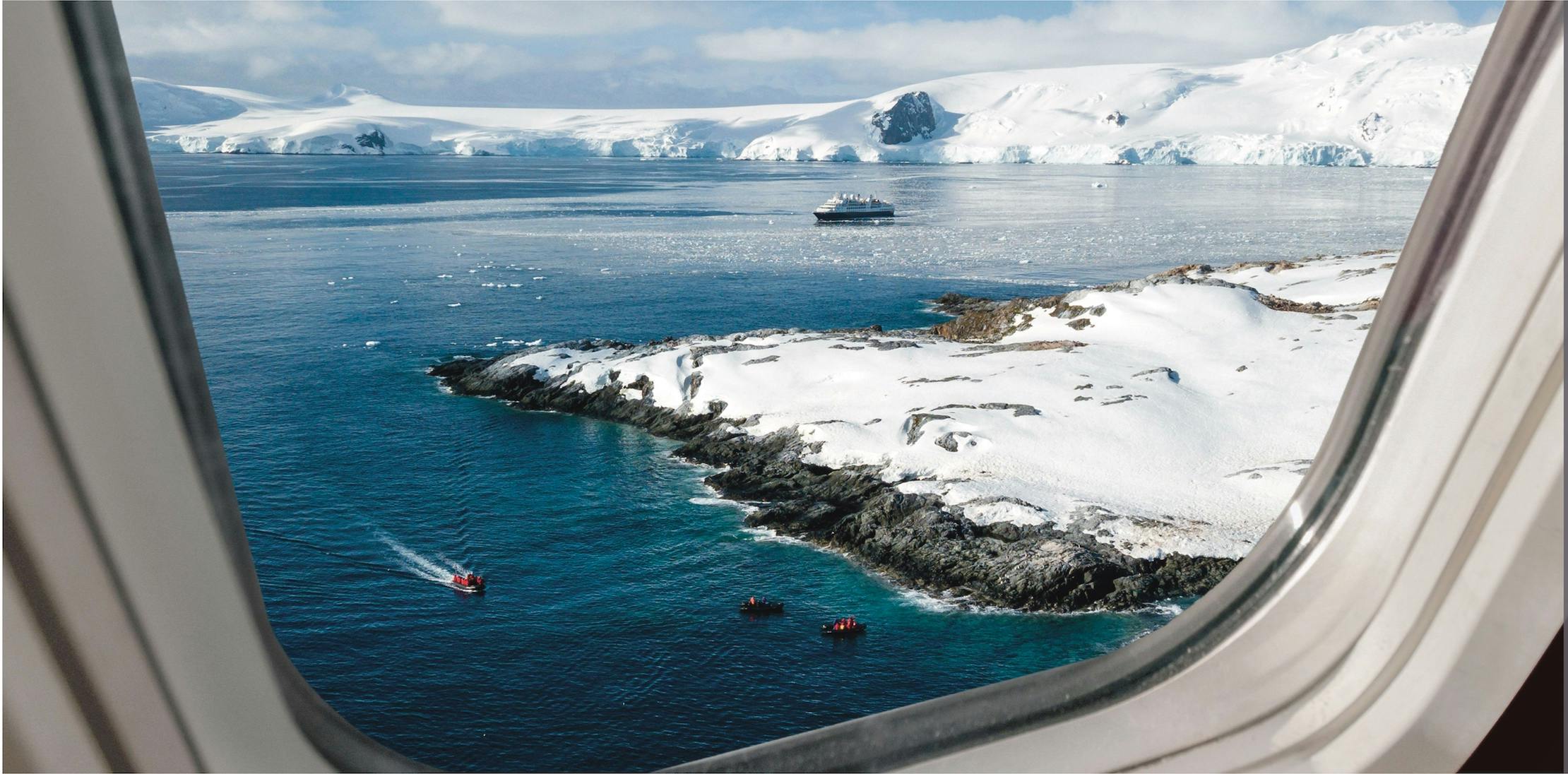
Antarctica Bridge cruises
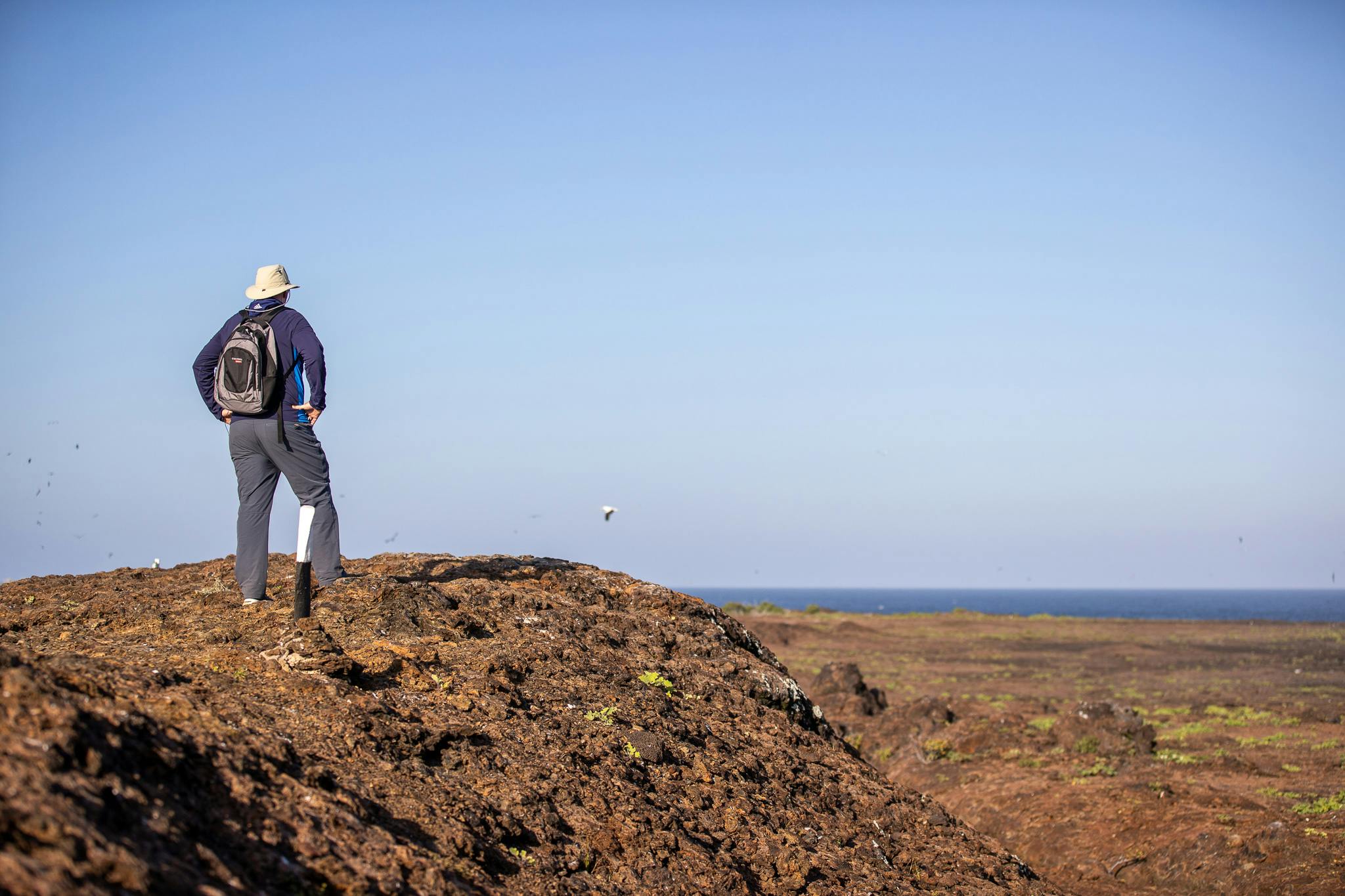
Just Back From…Galápagos Islands on Silver Origin
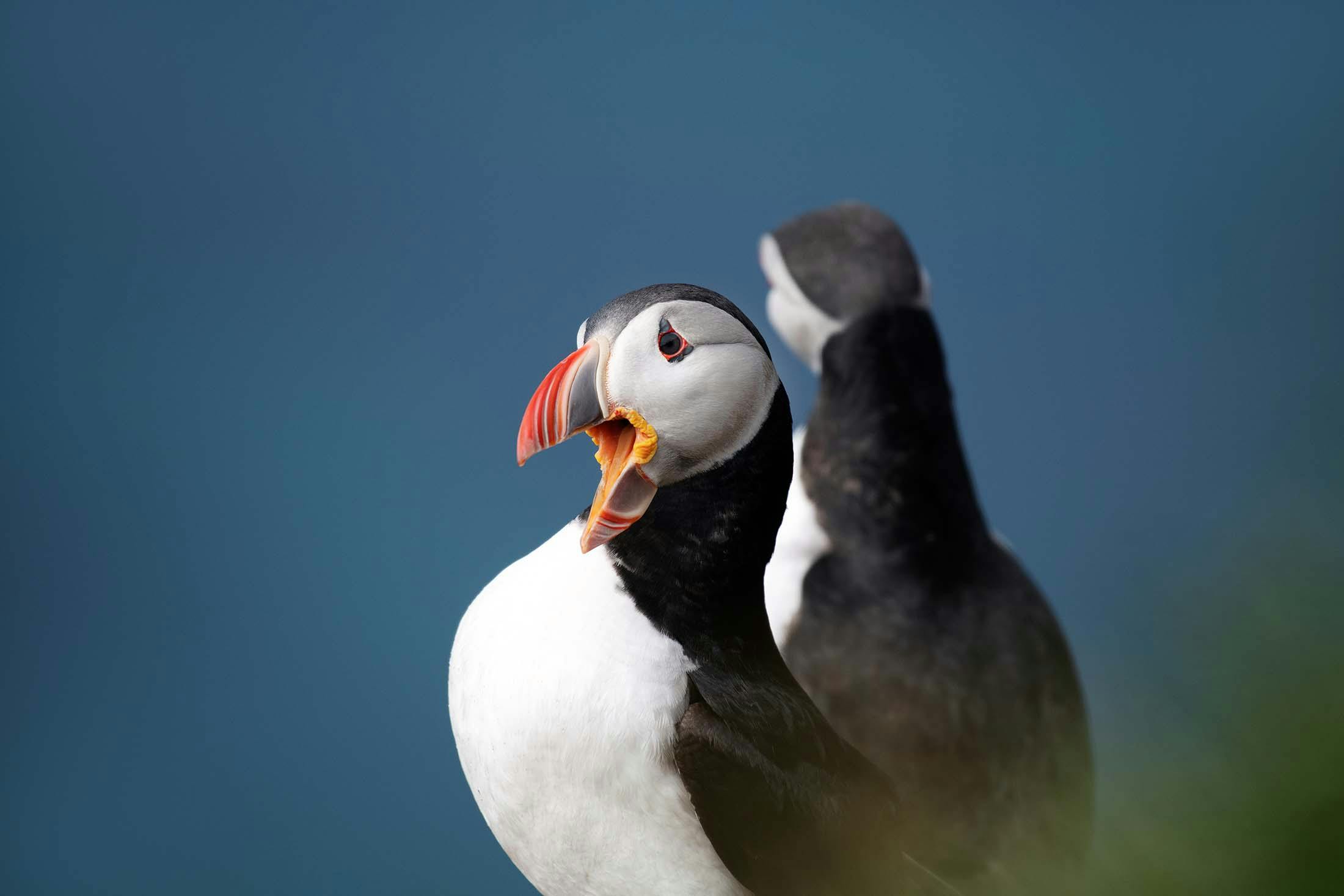
Lovable Puffins: A Spotter’s Guide
Never miss our stories: subscribe to our newsletter.
Penguin Watching Trips in Antarctica
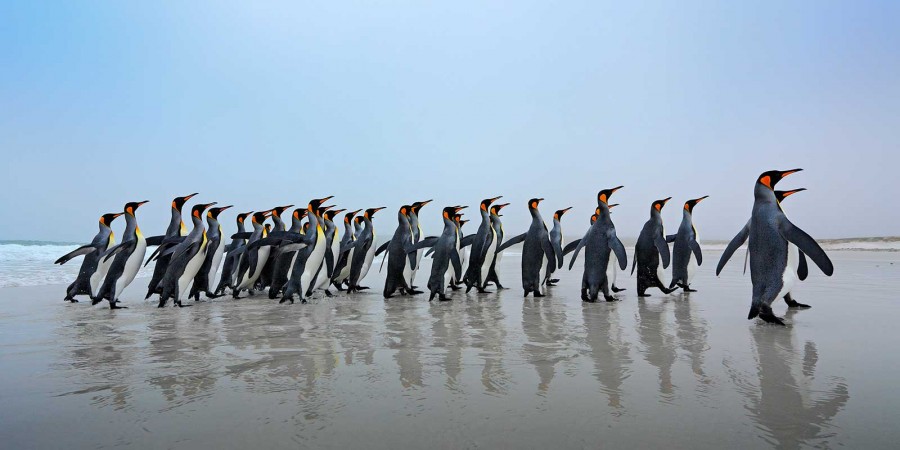
Classic Antarctica
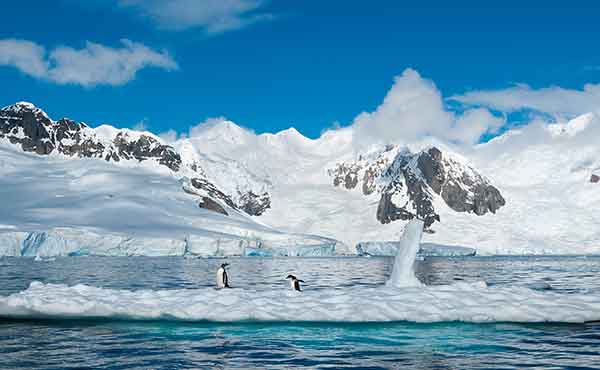
This voyage is a perfect introduction to the Antarctic, visiting prime wildlife sites along the Peninsula and in the nearby South Shetland islands. Encounter huge rookeries of gentoo, chinstrap and Adelie penguins, beaches adorned with wallowing elephant seals, and whales and dolphins along the way. Find out more about Classic Antarctica
- Price (exc. flights) : 11-13 days from £7,700
- Trip type : Voyage
Emperor Penguins of the Weddell Sea
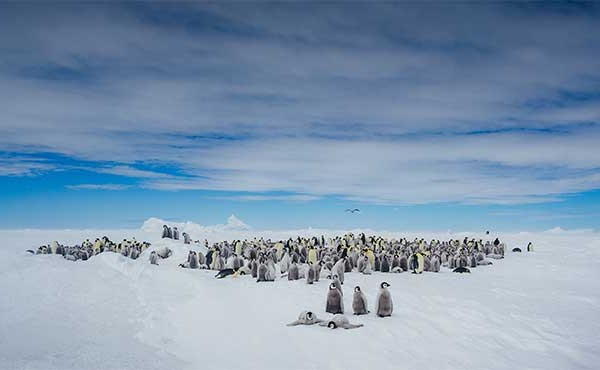
This voyage to the Weddell Sea offers a unique highlight - three days are reserved to visit, by helicopter, an emperor penguin colony, situated south of Snow Hill Island. Getting close to these magnificent creatures in their natural habitat is a unique and memorable once in a lifetime experience. Find out more about Emperor Penguins of the Weddell Sea
- Price (exc. flights) : 11-14 days from £11,285
Antarctica Penguin Safari
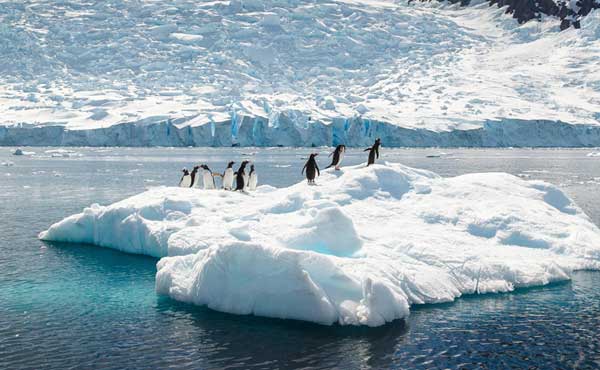
Set sail on this unique Penguin Safari, exploring the untamed beauty of South Georgia and Antarctica. Witness majestic albatross, playful seals, and up to five species of penguin amidst incredible scenery. With state-of-the-art facilities and superb excursions, prepare for an unforgettable adventure. Find out more about Antarctica Penguin Safari
- Price (exc. flights) : 18 days from £21,100
Festival of Wildlife Falklands & South Georgia
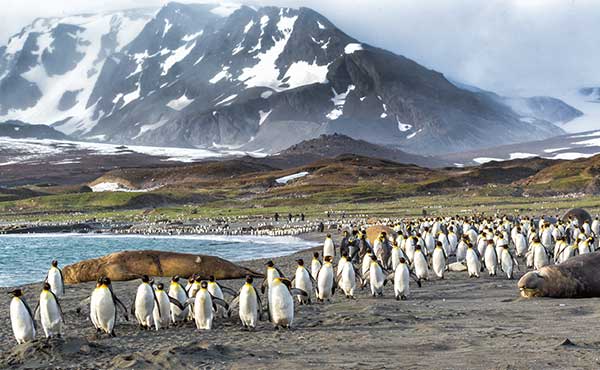
Our Festival of Wildlife 2025 takes us on an epic voyage to the Falkland Islands and South Georgia where one of the world’s most impressive wildlife spectacles awaits. Voyage on the Magellan Explorer with a leading team of naturalists, photographers, and artists as we watch penguins, whales and more. Find out more about Festival of Wildlife Falklands & South Georgia
- Price (exc. flights) : 17 days from £11,250
Great Antarctic Voyage
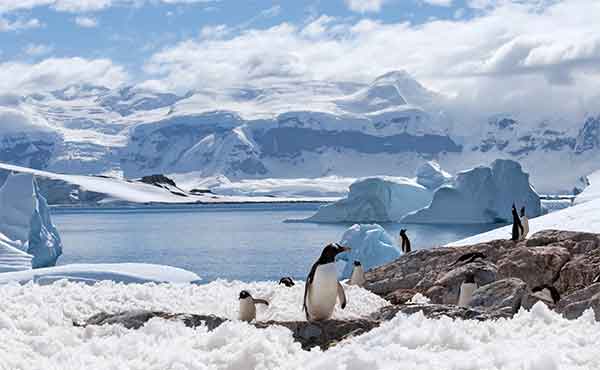
This ultimate Antarctic experience marries the phenomenal wildlife of the sub-Antarctic islands of the Falklands and South Georgia to the pristine beauty of the Antarctic Peninsula. Explore dramatic wilderness areas and visit huge penguin colonies, all amongst hauntingly beautiful polar scenery. Find out more about Great Antarctic Voyage
- Price (exc. flights) : 19-22 days from £12,095
Polar Circle Fly-Sail
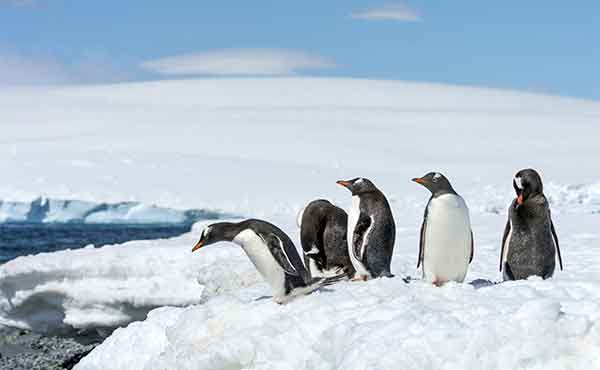
Flying to the South Shetlands over Cape Horn and avoiding the rough waters of the Drake Passage, this itinerary offers the easiest way to travel to Antarctica. Sailing down the western coast of the Antarctic Peninsula, the voyage passes spectacular icebergs in the company of sea birds, penguins, seals and whales. Find out more about Polar Circle Fly-Sail
- Price (exc. flights) : 9-11 days from £14,700
Antarctica Whale Safari
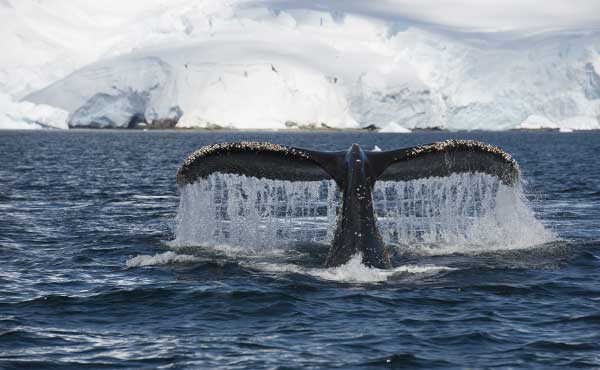
Embark on a once-in-a-lifetime adventure to the icy wilderness of Antarctica in search of cetaceans, pinnipeds, and seabirds, including numerous species of penguin. This whale watching voyage is perfectly timed during peak season, when the whales are most active and sightings are at their best. Find out more about Antarctica Whale Safari
- Price (exc. flights) : 11 days from £9,410
South Georgia Discovery
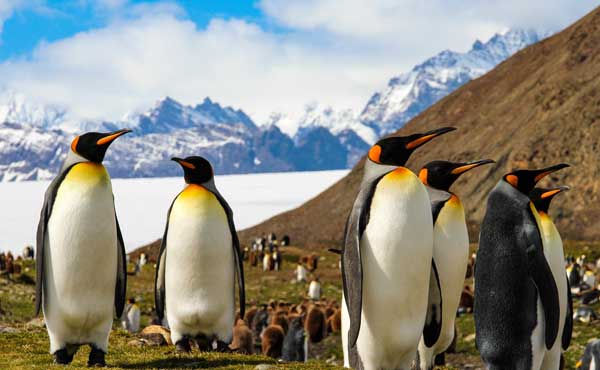
South Georgia offers unparalleled biodiversity and stunning landscapes. This bucket list wildlife expedition showcases penguins, wandering albatross, and elephant seals. Explore towering peaks, cascading glaciers, and pristine fjords guided by expert naturalists, on board a comfortable expedition vessel. Find out more about South Georgia Discovery
- Price (exc. flights) : 15 days from £10,445
Birding Expedition Down Under
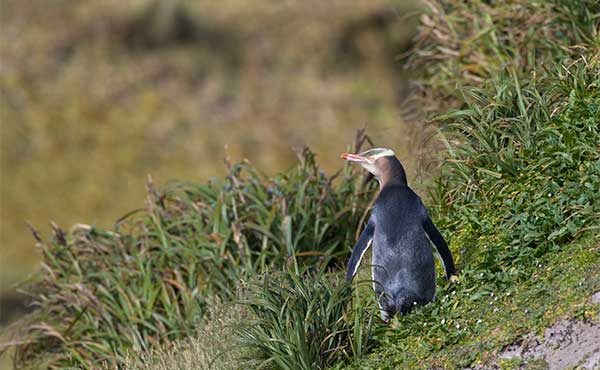
The Subantarctic Islands are tiny sanctuaries for some of the most abundant and unique wildlife on the planet. This epic expedition provides a rare opportunity to discover these wild islands, perfect for pelagic enthusiasts, penguin fanatics, and those interested in island endemics. Find out more about Birding Expedition Down Under
- Price (exc. flights) : 17 days from £13,500
South Georgia & Falklands Wildlife Extravaganza
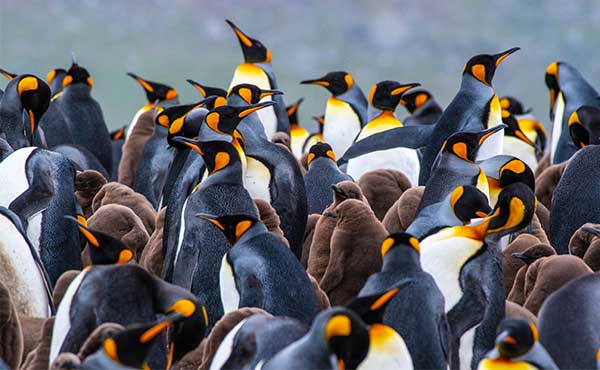
One of the greatest wildlife spectacles on Earth, South Georgia is overflowing with an abundance of wildlife. This incredible expedition combines wildlife-rich South Georgia with the remote Falkland Islands, home to vast numbers of seabirds and mammals, making this the ultimate wildlife extravaganza. Find out more about South Georgia & Falklands Wildlife Extravaganza
- Price (exc. flights) : 17 days from £8,060
Weddell Sea Explorer
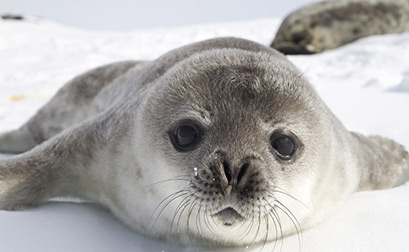
A land of icebergs, volcanic islands and year-round sea ice, the Weddell Sea has played a pivotal role in Polar exploration. A haven for birdlife and a feeding ground for migrating whales, this voyage offers the opportunity to discover the less-visited side of the Antarctic Peninsula and icy perimeter of the Weddell Sea. Find out more about Weddell Sea Explorer
- Price (exc. flights) : 12 days from £12,165
Ultimate Antarctica
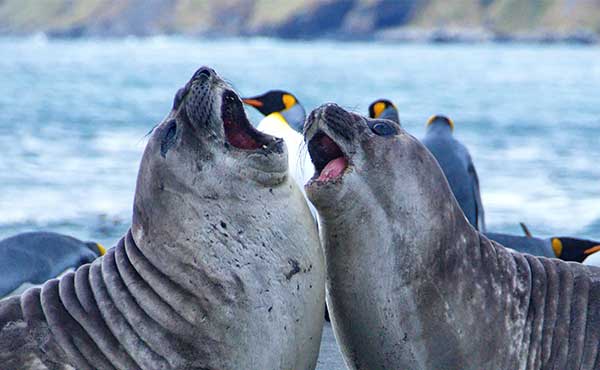
Set sail on the ultimate expedition through the pristine wilderness of Antarctica. Spanning 23 days, your adventure will take you from the Falkland Islands to South Georgia and onward to the Antarctic Peninsula, surpassing the Antarctic Circle – an achievement few have the privilege to experience. Find out more about Ultimate Antarctica
- Price (exc. flights) : 23 days from £27,665
Crossing the Polar Circle
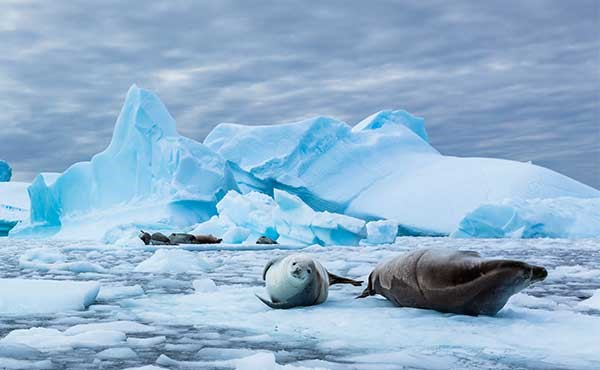
An extraordinary opportunity to cross the Antarctic Circle, a polar achievement few have the privilege to experience. Discover a rarely seen, isolated world, littered with gigantic icebergs, snow-clad mountains and swathes of pack-ice, whilst being followed by an array of seabirds and several whale species. Find out more about Crossing the Polar Circle
- Price (exc. flights) : 11-15 days from £7,215
Ross Sea Expedition Voyage
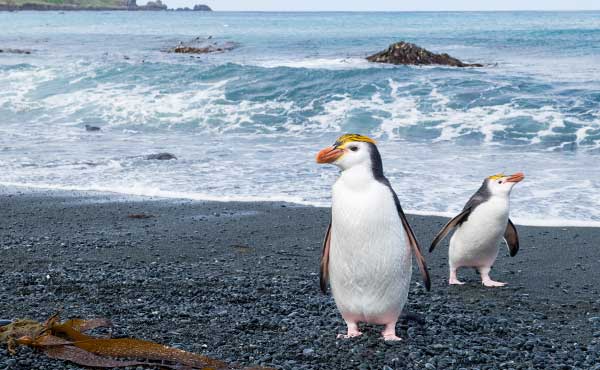
This voyage takes you further south than any other sea route to discover the remote Ross Sea. Locked under ice for most of the year, few people visit this unspoiled part of the world. Complimented with the little-known Subantarctic Islands south of New Zealand, this is a once-in-a-lifetime expedition. Find out more about Ross Sea Expedition Voyage
- Price (exc. flights) : 28 days from £25,500
Classic Antarctic Fly-Sail
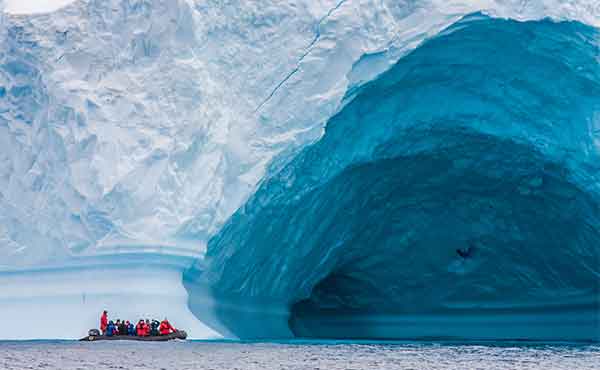
This trip takes the easiest way to Antarctica and flies from Punta Arenas in southern Chile, to save time and enjoy an aerial view of the Drake Passage. This active adventure involves daily landings by Zodiac inflatable, and with ever-changing ice and weather conditions, each voyage is unique. Find out more about Classic Antarctic Fly-Sail
- Price (exc. flights) : 8 days from £11,330
Sign Up For E-News
Sign up to get the latest on our holidays, offers and events. We generally send two to three e-newsletters per month.

Latest brochure
- Order a printed copy if you live in the UK.
- View or download it if you live outside the UK.
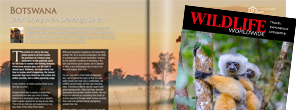
- Wildlife travel experts
- Tailor-made specialists
- Small group holidays
- 100% financial protection
- 100% independent
- 24 hour on-call support
- Finest wildlife destinations
- Personalised travel services
- Expert wildlife guides
- Finest wildlife accommodation
- Supporter of wildlife charities
- Leading our industry
- Investor in local communities
- The most responsible overseas partners
Discover our other holiday experiences
Wildlife Worldwide is a brand of The Natural Travel Collection Ltd , Long Barn South , Sutton Manor Farm , Bishop’s Sutton , Alresford , Hampshire , SO24 0AA , UK .
Your financial protection is guaranteed by ABTOT and ATOL (number 10544) when you book with us .
- ©2024 The Natural Travel Collection Ltd, all rights reserved
- Terms of use
- site navigation
- main content
- Tel: +31 (0) 858 771 583
- [email protected]
- © David Rootes
Emperor Penguins on Antarctica
Camp on the sea ice where thousands of Emperor Penguins come to raise and feed their young. One of the most unique wilderness experiences on earth.
Call us today on +31 (0) 858 771 583
- Expeditions
- Emperor Penguins Expedition

- Accommodation
- Sample Itinerary
Dates & Rates
Expedition to the Emperor Penguins
If you have ever seen ‘March of the Penguins’ then you will have a clear appreciation of how spectacular the Emperor penguins are. To visit a large remote colony of thousands of penguins and their young chicks is one of the greatest and most exclusive wildlife experiences on the planet. During this expedition to the Antarctic continent you will visit the Gould Bay Emperor penguin colony on the remote coast of the Weddell sea. A small camp is set up on the ice, only a short walk away from the colony. The 24-hour daylight offers plenty of time to visit and photograph the majestic penguins and their chicks against a spectacular backdrop of ice and snow. The Emperors are totally unafraid of humans and will sometimes come within a few meters of you. A very impressive encounter as they can easily reach 100 cm in length and weigh up to 45 kg. Your safety and the protection of wildlife are top priorities and we make every effort not to disturb the penguins. Immerse yourself in the noise, the smell, commotion and the sheer beauty of this special place. It will not disappoint you!
"I had high expectations of this trip, but never thought it would touch me as much as it did. Thank you for organizing such an amazing experience!" - Bill M.

We advise you to arrive in Punta Arenas (Chile) at least two full days prior to your scheduled Antarctic flight in order to fully prepare yourself for the upcoming expedition. These days also allow a buffer for flight and luggage delays, should your travels to Chile not go as scheduled.
Fly to Antarctica
After a few days in Punta Arenas it's time to take off! At the airport, you board the chartered jet for the 4¼ hour flight to Antarctica. The route crosses the Drake Passage, then follows the west side of the Antarctic peninsula and the spine of the Ellsworth mountains. You land on a naturally occurring blue-ice runway on Union Glacier where you will take your first steps on the Antarctic continent! Specially-adapted vans will take you and your luggage to the base camp where the expedition staff will provide a welcome tour and show you to your tent. On most expeditions you will get to enjoy a few days at Union Glacier before you fly to the Emperor Penguin colony. A typical day at Union Glacier starts with a briefing after breakfast where you’ll meet with your guide to discuss the day’s options and choose an activity tailored to the weather and the group’s interests.

Exploring Union Glacier
There's a wide range of excursions for you to enjoy at Union Glacier. Take a ride in one of the polar vehicles to the dramatic marble mountain 'Elephant’s Head', overlooking the blue-ice runway. You’ll have the opportunity to hike up to the base of Elephant’s Head or all the way to the top of Rhodes Bluff for panoramic views of Union Glacier. Another stunning location is Drake Icefall, this impressive icefall is shaped into huge blue-ice waves by the strong winds coming from the south pole. Another incredible piece of art by nature is Charles Peak Windscoop, a sparkling turquoise corridor which is also carved by the wind. It's is a prime place to try ice climbing. The Beach at Rossman Cove is yet another spectacular place for blue-ice photography and panoramic views! Take cross-country skis with you or a picnic lunch and enjoy Antarctica’s version of an afternoon at the beach. At the base camp you have a variety of activities for all abilities. Go for a tour on skis or take a fat-tire bike for a spin around the groomed 10km loop around camp. Or simply enjoy a cup of tea, an Antarctic book, or a fun game at the camp's library. In the evenings, there are regular lectures and films tailored to your experience.
Visit the Emperor Penguin Colony
As soon as weather conditions permit, you will fly to the Emperor Penguin colony. The flight takes about 4 hours, travelling north-eastward over the Ronne Ice Shelf and Berkner island. The plane lands on the sea ice where the staff has prepared a field camp 1-2 mi (2-3 km) from the colony. The field camp manager will give you a tour of the camp and review safety procedures for walking to and from the colony. This will be your home for the next few days! Immerse yourself in the sights, sounds, and rhythms of the Emperors. It's an experience only few people will ever get to have! Walk to the colony with the experienced field guides to photograph penguins, seals, and seabirds. Small sleds and walking poles are provided and can help transport your camera equipment between the field camp and the colony.

We make every effort not to disturb wildlife and strictly adhere to Emperor Penguin Colony Visitor Guidelines. These guidelines include maintaining a precautionary distance of 17 ft (5 m) away from all wildlife. Guides are on hand to answer any questions you may have about the wildlife and their unique adaptations to the Antarctic environment. The 24-hour daylight allows us to adapt our schedule to the best weather and lighting for photography. While our guides are happy to accommodate individual requests, keep in mind this is a group activity and we may not always be able to offer 1 on 1 guiding. Please discuss your wishes with the guides in advance so they can tailor the camp schedule to include meals and sleep for everyone.
Return to Union Glacier
Flight back to punta arenas.

Base Camp - Union Glacier

Field Camp - Gould Bay Camp

The field camp at Gould Bay is set up 1-2 mi (2-3 km) away from the colony. You will be sleeping in simple yet comfortable mountaineering tents. These tents are low to the ground and you will not be able to stand up in them. Insulated sleeping mats and a polar-rated sleeping bag will keep you nice and warm. There are field toilets in the camp but no showers.
Places on these exclusive Emperor Penguin Expeditions are very limited. Please contact us for more information and availability.
Related Trips
Classic antarctica cruise.
Prepare to be dazzled by the beautiful scenery and the abundance of wildlife of the Antarctic Peninsula. The White Continent creates life lasting memories.
South Georgia & Antarctic Peninsula
South georgia & antarctica cruise.
The combination of the Sub Antarctic Islands and the Antarctic Peninsula makes this voyage an expedition full of exciting highlights.
Crossing the Antarctic Circle Cruise
Travelling south at the west side of the Antarctic Peninsula.
North Pole Icebreaker Cruise

North Pole Ice Breaker Cruise
Your icebreaker will take you to one of the most inaccessible places in the world, the North Pole!
Ski to the South Pole

Ski to the South Pole - Expedition
Experience the challenges faced by early explorers as you ski to the Geographic South Pole.
Falkland Islands, South Georgia and Antarctica

Falklands, South Georgia & Antarctica Cruise
Explore the Falkland Islands, South Georgia and the Antarctic Peninsula. A dream come true for wildlife enthusiasts. During this voyage you will be able to see up to six penguin species.
Falkland Islands & Antarctic Peninsula

Falkland Islands & Antarctica Cruise
Enjoy the combination of the Falkland Islands and Antarctica and see 200 birds species, whales, seals and penguins!
Visit the Geographic South Pole

Visit the Geographic South Pole - Expedition
Stand at the bottom of the earth! The elusive place where every direction you look is north and the sun only rises and sets once a year.
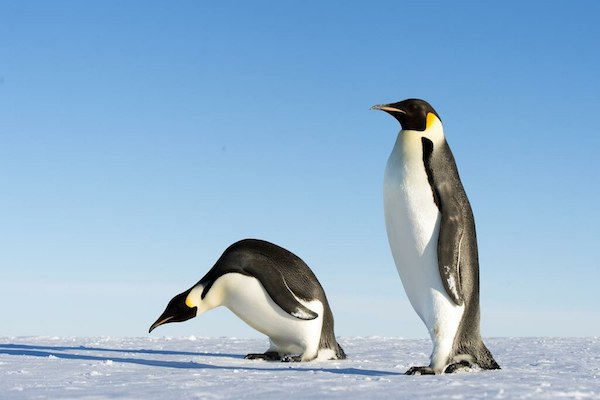
Where to see emperor penguins in Antarctica
October 8th, 2021 / Burnham Arlidge
Not only are emperor penguins the largest of the penguin species, but they are arguably the most interesting.
Emperor penguins are the only penguin species to stay out on the open ice during winter, often enduring hurricane-strength winds and freezing temperatures as low as -60 degrees celsius.
Unlike most species, emperor penguins are monogamous and the males do their equal share of raising the chicks. Huddled together through the long, dark winters, the male emperor penguins work together to keep the newly laid eggs warm whilst the mothers hunt for food at sea. Their strong sense of community literally keeps them alive.
Their impressive size and colour makes them extremely popular and many a traveller has spent a lot of time and money searching for these elusive birds.
So, where is the best place to see emperor penguins in Antarctica?
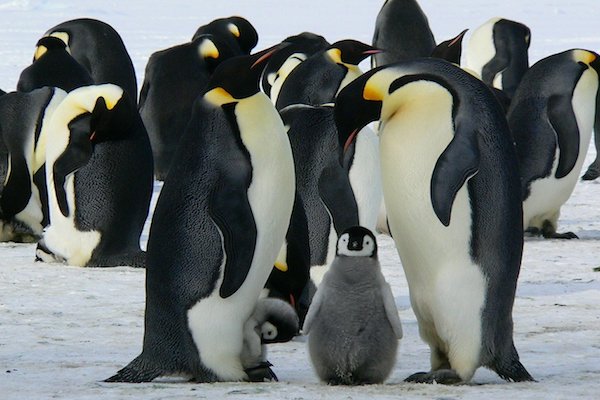
Snow Hill Island
Snow Hill Island is probably the most popular destination for people wanting to see emperor penguins. Located in the Weddell Sea, Snow Hill Island lies just off the east coast of the Antarctic Peninsula and is home to a colony of 8,000 emperor penguins.
Only a small number of ships make the journey to this inhospitable island each summer, with most operators favouring November due the ice conditions. This is also the best time to witness the newly-hatched penguin chicks in their cute and fluffy state.
Given its remote and ice-choked location, only the toughest of polar ice-breaker vessels can reach this area. Even with the icebreaker ships, you’ll not be able to reach the island directly, instead you’ll have to take a helicopter to the island and then hike on foot to the colony.
The Weddell Sea voyages generally start from around US$12,000 per person and take 10 days. Due to the unpredictable sea conditions and weather of Antarctica , there is only a 50/50 chance that you will see any emperor penguins on these voyages.
Whilst a 50/50 chance does not sound ideal when you are spending thousands of dollars, the other options we discuss below are significantly more expensive. Snow Hill is by far the most cost-effective way to see emperor penguins in the wild.
Even if you do not see emperor penguins on your voyage, the Weddell Sea region is a spectacular part of the world and you’ll see numerous other penguin and whale species on your trip.
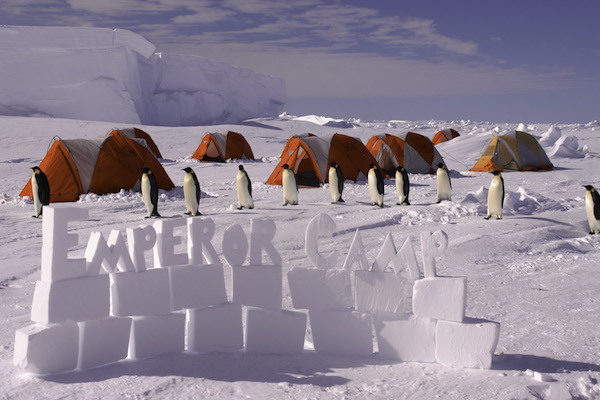
The second option to see Emperor penguins in the wild is to journey to Gould Bay. Situated on frozen sea ice, Gould Bay is located in the Weddell Sea, just in front of the Ronne Ice Shelf. Gould Bay is the only Antarctic tourist camp pitched on sea ice and is, without doubt, one of the most remote camps on the planet.
The trip is run by Antarctica Logistics and Expeditions who operate a small base at Union Glacier where guests first arrive by charted flight. From Union Glacier, guest are flown to Gould Bay Camp over 420 miles away.
The camp is set up just over a mile from the emperor penguin colony and is made up of numerous small tents and very little else. A flagged route marks the way between the camp and emperor penguin colony and guests have to make do with the ‘field toilets’, lack of showers, and basic amenities. The food though is first class and you can expect good-sized meals each day, along with tea, coffee, beer, and wine.
Each day is focused on viewing the emperor penguins and getting as safely close as possible to these beautiful creatures. Meal times are not fixed so that guests can photograph the penguins during the best light and weather. The knowledgeable guides will provide you with all the information you need regarding these amazing birds.
Because you’ll be sleeping in tents, there is every chance that you may come in close contact with other species of penguins and seals. Penguins frequently enter the camp and it’s a truly species experience being so close to the wildlife.
Gould Bay trips take 9 days and prices start from US$48,950 per person. Guess need to be prepared for changing and cold weather conditions. There will also be moderate hiking each day across snow and ice.
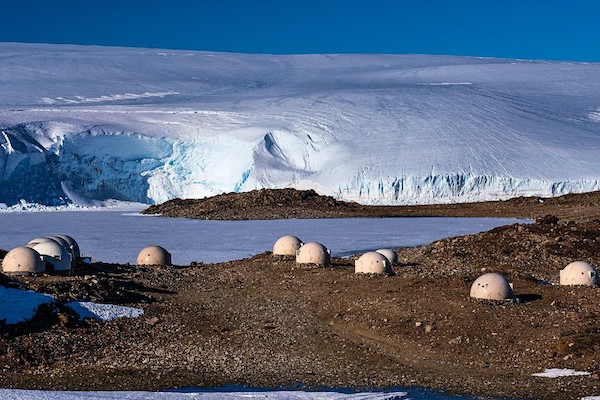
The Atka Bay trip run by White Desert is probably the most epic way to see emperor penguins in Antarctica. You travel from Cape Town to Wichaway Camp via a luxury private jet where you make camp for 6 days. The camp is located next to a 200-foot ice cliff and is compromised of 7 luxurious en-suite pods that employ aerospace technology and are heated from within.
Each day guests explore the surrounding area and can do activities such as hiking and exploring local ice tunnels. One full day is spent flying to Atka Bay where guests can see a large emperor penguin colony up close. You will also get the chance to fly over the colony for unrivalled aerial views.
Prices start from US$65,000 per person and this includes the private jet transfer to and from Cape Town to Antarctica. Trips depart in the spring time when the chicks are looking their best. For the more adventurous guests, there is also the option to try ice-climbing and abseiling.
Posted on Oct 08, 2021
About the Author Burnham Arlidge
Burnham started his career as a professional tennis player before retiring due to injury. Since then Burnham has thrown himself into adventure travel. He has visited some of the most iconic and obscure parts of the planet - his most memorable experience is Antarctica!
Get a cruise quote to your inbox, today!
Receive a price competitive quote from our trusted Antarctica cruise agent.
Related Posts
May 17th, 2024
March 28th, 2024
March 8th, 2024
August 4th, 2023
Previous Post
Will weather affect my Antarctic itinerary?
Popular Articles
Get a cruise quote, now.
* Fields are required. Expect a response within 48 hours. Check your spam / junk for your quote.
I agree that your recommended Antarctica specialist can contact me *
- Back to Articles
Where to See Antarctic Penguins?

Laura Pattara | 10 July 2018
Your Comprehensive Penguin-Spotting Guide
Antarctica ’s majestic beauty may be an overwhelming thing yet if truth be told, it’s the continent’s furry-dudes-in-tuxedos that rate highest on everyone’s wish-list . Penguin-spotting in Antarctica is the most coveted and rewarding highlight of any expedition to the frozen land on the south and, although your encounters are guaranteed, you may appreciate knowing where and when you’re likely to find the little guys waddling about.
Recent research findings unveiled excellent news: Antarctica is home to millions of more penguins than previously thought. Your guide to Where to See Antarctic Penguins details all you need to know, including the different species found in and around the White Continent and how to best approach an up-close-and-personal encounter, responsibly.
Click the links below to skip through the blog :
- Penguin species that live in Antarctica
- E ach penguin species
- Best places to see Penguins in Antarctica
- Best time to see Penguins in Antarctica
- Responsible tourism
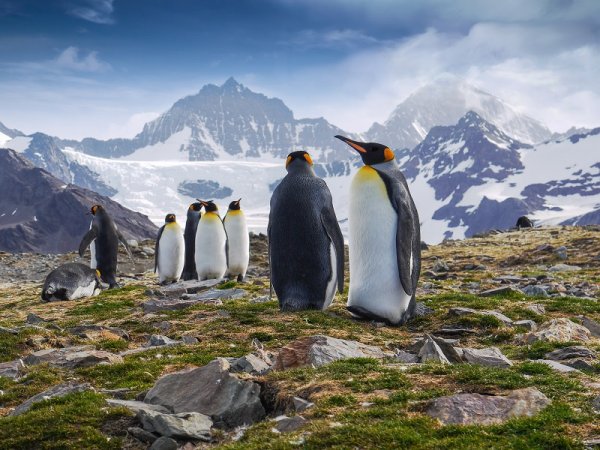
King penguins in South Georgia
Which species of penguins live in Antarctica?
All up, this wonderful planet of ours is home to between 17 and 19 different species of penguins, with the exact number still up for debate for reasons which we shall explain further on in the article.
Penguins are primarily inhabitants of the Southern Hemisphere although their wide roaming has seen them cross that invisible equatorial line, particularly in the Galapagos Islands of Ecuador .
Although we mostly think of penguins as hardy creatures adapt to super harsh environments, only a few species actually make it all the way to Antarctica. The Antarctic Peninsula itself is usually only home to 6 species of penguins whilst more species are found in the waters off its coast and its nearest islands, such as South Georgia or the Falklands. Most penguins, in fact, prefer to live in more temperate ‘in-between’ regions of South America, Africa, New Zealand and Australia. A lovely compromise we can all appreciate!
About Antartica's penguin species
Penguins can be found in the Antarctic Peninsula , the sub-Antarctic islands and all the nutrient-rich waters in between.
The largest penguin species in the world is the magnificent Emperor Penguin (of The March of the Penguins fame) which lives exclusively in Antarctica and can grow up to 1.1m in height and weigh up to 35kg! If their sheer size doesn’t give them away, the Emperors are easily spotted due to their glowing orange cheeks. When talking about penguin-spotting in Antarctica , it’s the mighty Emperor most people dream to see.
Emperor penguins
The Antarctic Emperor takes ‘hardy’ to all new levels: this is the only penguin species (and only warm-blooded animal) that lives, breeds and nests this far south, all year long. By and large, the bigger the penguin the more like it is to venture into colder climates (for as we all know, a few extra pounds make for excellent insulation) and that’s one of the many reasons Antarctica is such a precious spot for penguin-watching. Not only do you see a mind-boggling number of them but you’re likely to see the largest in the world, as well.
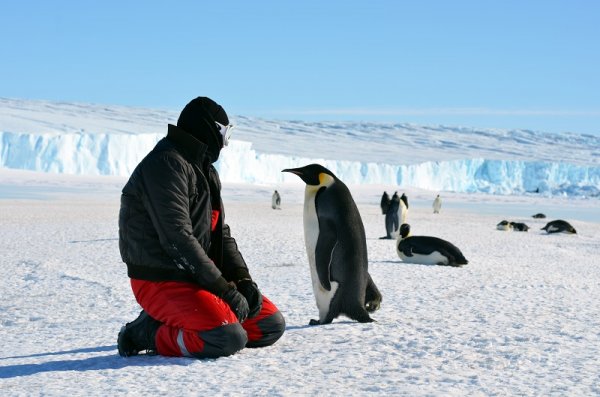
Emperor Penguin in Peninsula, Antarctica
Adélie penguins
The smallest penguin you’ll see in Antarctica is the wee lil’ Adélie, which grows to about 60cm in height and weighs about 3-4kg. Easily recognizable due to their very black head and white-ringed eyes, the Adélie is one of the most numerous you’ll come across with 6 million individuals believed to vacation here, every year.
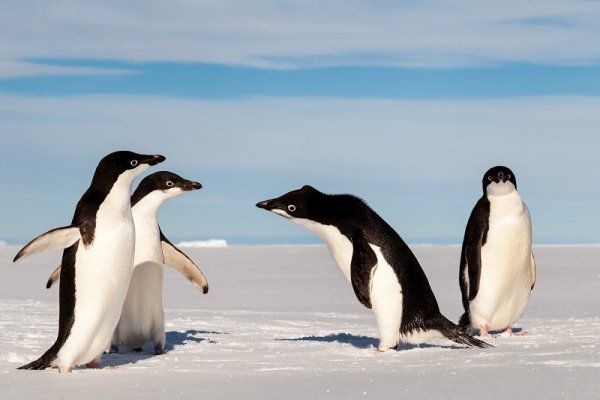
Smallest penguins Adelie, Peninsula
Chinstrap penguins
The most numerous of all Antarctic penguins is the Chinstrap, so named for the built-in helmet design on its head. There are an estimated 13 million of these cool riders in Antarctica, many of whom live on gigantic icebergs floating about Antarctic waters. The Chinstrap is only marginally bigger than the Adélie.
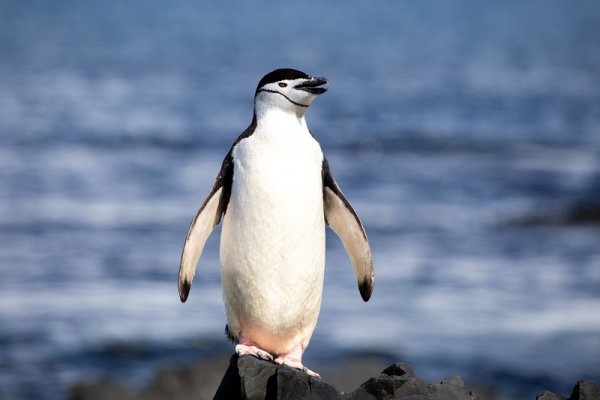
Chinstrap penguin in Peninsula, Antarctica
Gentoo penguins
The Gentoo penguin has a white stripe that runs from one eye to the other across the back of its head and is most numerous on the Falkland Islands , a stellar natural and historical addition to Antarctica expedition itineraries. The Gentoo is about 1/3 larger than the Adélie, larger than the Gentoo and, like both, builds its circular nest from rocks, which it fights fervently to collect and, sometimes, cunningly steal.
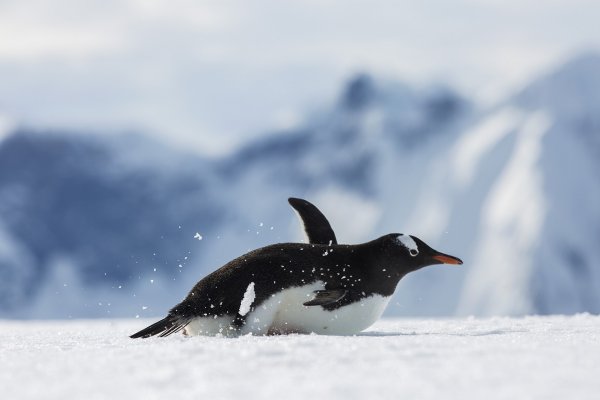
Gentoo penguin sliding on its belly
King penguins
The King penguin often gets confused for the Emperor although, in real life, is only about 2/3 of the size. It also has glowing orange spots although the Kings have them on their necks and ears rather than on their cheeks. South Georgia is home to a healthy colony of mighty Kings.
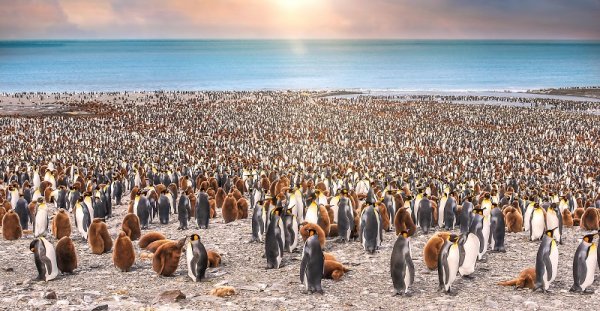
King penguin in South Georgia
Macaroni penguins
The funniest-looking penguin would have to be the Macaroni penguin, a creature whose name derives not from its love of pasta (contrary to popular belief) but, amusingly, from an early 19 th -century hat-style that was all the rage in Great Britain. With those glowing orange plumes, the Macaroni really can’t be mistaken for any other species.
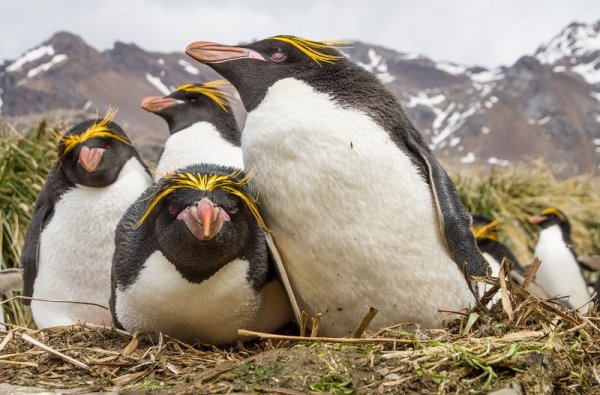
Macaroni penguin, Antarctica
Best places to see penguins in Antarctica
Peruse any of the itineraries of Antarctica expedition cruises and you’ll find an array of options for including a few stunning islands en-route to the frozen peninsula. Sub-Antarctic islands are prime breeding and nesting grounds for penguins due to their still very nutrient-rich waters yet considerably more manageable temperatures. Cruises which include such astonishing destinations as South Georgia and the Falklands are usually more expensive options yet if penguin spotting is an absolute life-dream of yours, dare we say these longer expeditions are worth their weight in gold.
See the map on our Where to Go in Antarctica blog to get a clearer idea of where all these stellar destinations are located.
South Georgia
Discover incredible wildlife and landscapes with tours to South Georgia .
The island of South Georgia is often dubbed the Galapagos of Antarctica due to the sheer concentration of wildlife that thrives here. Penguins, in particular, are absolutely prolific on South Georgia and this sensational spot boasts the world’s largest colony of Emperor Penguins, along with three other species. If penguins are a must-see for you then South Georgia is a definite must-visit.
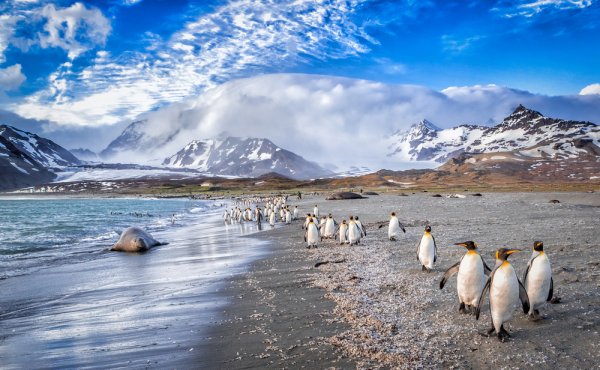
Penguins walking on shore, South Georgia
Macquarie Island
Visit UNESCO-protected ares of Antarctica. Click here and choose your tour.
Macquarie Island is part of the largest UNESCO-protected marine reserve in the world and claims the Royal penguin as its most numerous endemic species. Royal penguins are the largest crested species of all and classified as threatened. The debate as to whether or not the Royal is a distinct species or a larger version of the macaroni is still ongoing and that’s the reason why the penguin species number is not set in stone. Macquarie is a remote, dramatic and exceptionally beautiful island that receives very few visitors, as it’s only accessible to guests aboard Antarctica expeditions from New Zealand and Australia. The Royal only breed on Macquarie although can be found torpedoing in waters around nearby islands as well.
http://vimeo.com/279357275/eaf857f56b
The Falkland Islands
Explore the stunning beauty of Falklands on our tours .
Argentina’s Falkland Islands (Las Malvinas) host five species of penguins, including King, Gentoo, Magellanic, Macaroni and Rockhopper. The Magellanic penguin is the largest of the warm-climate species and, alongside the Falklands, can also be spotted along Peruvian, Argentinian and Chilean coastlines (especially around Chiloe Island) back on the South American mainland.
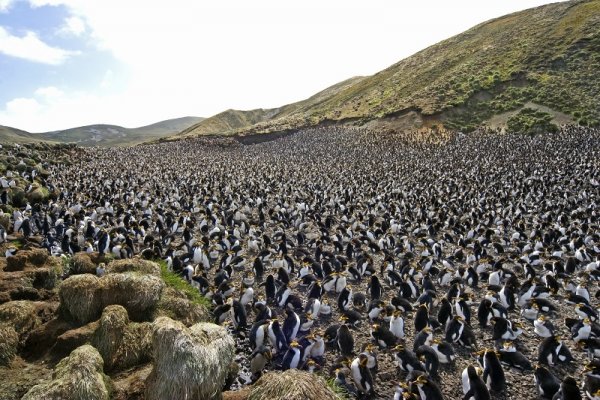
Penguin habitat, The Falkland Islands
Snow Hill Island
Experience the amazing whiteness of the icebergs in Antarctica. Find our tours here .
The Snow Hill Island Emperor penguins are the stuff Antarctic legends are made of, where remote location and arduous journey meets one of the most awe-inspiring wildlife species in the world. Normally ice-packed and impossible to reach if not by helicopter, the elusive island floats in the Weddell Sea and hosts the northernmost Emperor penguin colony on our planet. Covering an area of just under 400 square km, Snow Hill island is the northernmost Antarctic island off the southern coast of South America and visits are only possible as helicopter excursions on specific cruise liners.
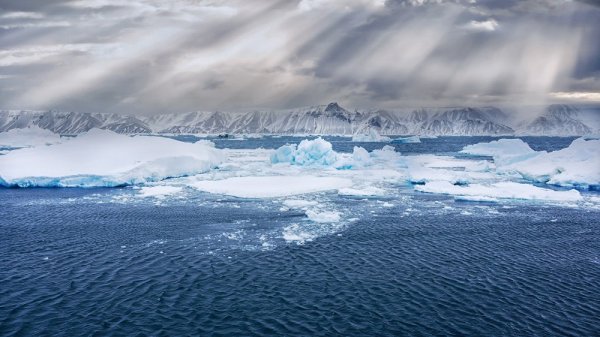
Home of Emperor Penguin, Snow Hill Island
Ross Sea Ice Shelf
Learn about wild animals on our tours to Antarctica .
Another brilliant plus of tackling an Antarctic expedition From New Zealand or Australia is that you get to visit the remote and spellbinding Ross Sea Ice Shelf, home to thousands of penguins scattered around skyrocketing glaciers. Over a million breeding pairs of Adélie penguins can now be spotted here, reputedly the highest number seen in over three decades. Adélies are considered by experts to be the epitome predictors of ice and sea environmental health and their numbers (whether they increase or decrease in a particular spot) are used to evaluate the state of both. Given the fact that Adélie relies primarily on krill, the base source of the Antarctic food chain, their prevalence tells scientists how well every other species is also doing.
South Orkney Archipelago
Experience Antarctica wildlife on one of our tours .
Few cruises add a stop-over on the South Orkney islands but those lucky enough to do can enjoy the spectacle of large colonies of penguins, including Adélie, Gentoo and Chinstrap.
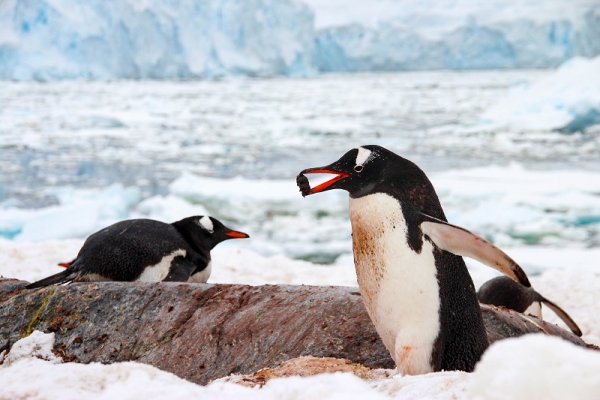
Penguins eating in Archipelago, Antarctica
Antarctic Peninsula
Visit Emperor and King penguins with our tour to South Georgia .
An ice and snow-covered extension of the stupendous Andes Mountains, the Antarctica Peninsula is the main destination for almost all Antarctic Expeditions . Leopard seals and whales are the top wildlife species to spot here with loads of penguins (almost all except Emperor and King) found in abundance in the best-protected coves along the rugged coast.
Antarctica is the renowned home of the penguin yet it’s important to remember that if penguin-spotting is a must – ESPECIALLY OF King and Emperor – then you’ll need to choose an itinerary that includes South Georgia, the Falklands or if coming from New Zealand/Australia, Macquarie Island.
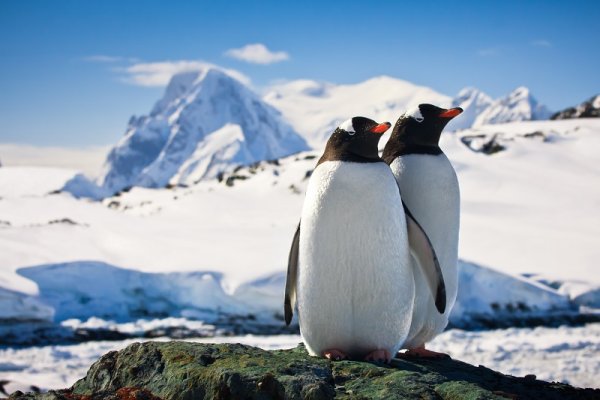
Penguins in Antarctic Peninsula
Best time to see penguins in Antarctica
The best time to see the highest concentration of penguins in Antarctica is during the Austral spring and summer, in the months between October and February. Penguins tend to split their time evenly between land and water yet it’s during the warmer months that they tend to waddle on land for longer periods. This is, through no coincidence, the best time to visit Antarctica.
Early spring is best for Emperor penguins which, despite their numbers, are considered ‘near endangered’ and actually pesky to find. That’s the main reason journeys to South Georgia are so popular. It seems almost unfathomable that one would venture this far south and not see the Emperor yet if you want the highest sighting chances then South Georgia – or indeed Snow Hill island – are your best bets
Emperor penguins, Antarctica
Responsible tourism - What to do (and not to do)
Penguins aren’t particularly afraid of humans and this, coupled with their inherent curiosity, make for exceptionally rewarding encounters. Come across a penguin in Antarctica and he (or she) is likely to waddle over to you, have a sniff, perhaps hop on your boots and investigate you. This is, without a doubt, an incomparable wildlife experience yet one which should be approached with a great deal of care.
Head to Antarctica on an expedition cruise and you’ll be given 101 instructions on how to approach – or, perhaps better stated, steer clear of – any animal you come across. Yet penguins aren’t renowned for paying much notice to internationally agreed codes of conduct and will think nothing of ignoring the rules and coming in for a closer look. So, what should you do if one does? Well, the common consensus is to use common sense. Rules are there to protect you and the animal so one doesn’t get injured and the other one stressed yet if you’re standing or sitting still and one waddles over to you, one might argue that abruptly storming off is what will cause the penguin to stress. Granted, you need not go in for a bear hug (as much as you might want to) but it’s acceptable to simply stay still and enjoy the magical meet-up. Other than that, it’s good to keep in mind that a respectable distance of at least 10 meters is advisable, especially when dealing with nursing mothers and bubs.
We hope our Antarctic penguin-watching travel advice will be useful as you plan your unforgettable adventure to the southernmost continent on earth. For more info on anything Antarctic related – including choice of expeditions, duration and inclusions, do visit our Antarctica Tours page and contact us, right here .
Recommended Tours
Wildlife and Nature: Our wildlife and nature holidays will take you to some of the most remote and unspoilt regions. From encountering rich exotic wildlife in Latin America and Africa to the magnificent marine life in Antarctica and spotting spectacular birds in New Zealand.
Safari Tours: Embark on a remarkable safari tour in Africa, where the allure of untouched wilderness and awe-inspiring wildlife encounters await.
Classic Zimbabwe
Immerse yourself in the untamed beauty of Zimbabwe's wildlife havens with our extraordinary tour visiting Hwange, Matusadona, and Mana Pools.
Wild Tanzania: Ruaha, Nyerere and Mafia Island
Explore the untamed national parks of Nyerere and Ruaha before discovering the secrets of Mafia Island where you can swim with whale sharks
Luxury: We design unique luxury holidays and experiences that allow you to experience the most spectacular and remote parts of the World. From the best hotels and lodges to luxury small ship cruises and exclusive Heli-tours.
Taste of Zambia
Indulge in a truly gastronomic adventure on this luxurious 11-day tour through Zambia's captivating heartland.
Similar Stories
South america, best places to travel in south america, how to get to africa from new zealand, exploring the galapagos islands with kids, trip & ship review – explore antarctica on the ocean albatros.
Subscribe to our newsletter
- Skip to primary navigation
- Skip to main content
- Skip to primary sidebar
- Skip to footer
TravelAwaits
Our mission is to serve the 50+ traveler who's ready to cross a few items off their bucket list.
One Of The Most Exclusive Wildlife Viewing Experiences In The World Returns This Fall, Here’s How Much It Costs

- News and Tips
- Travel News
A once-in-a-lifetime trip to see a coveted colony of penguins is now available, but it’s costly! Here’s everything you need to know if you love penguins and are ready to splurge!
Emperor Penguin Quest
The Emperor Penguin Quest: Expedition to Snow Hill will return in November 2023 thanks to polar explorers with Quark Expeditions. The 14-day expedition ventures to the rarely visited Antarctic island of Snow Hill, home to a colony of emperor penguins. Once there, guests will have the extremely rare opportunity to observe these fantastic penguins in their natural habitat.

The trip begins in Buenos Aires, Argentina , where guests will stay overnight in a hotel before being transported via private plane to the world’s southernmost city, Ushuaia, Argentina. After a day of exploring, guests will board the ship Ultramarine and set sail for the Beagle Channel.

On days three through five, you’ll cross through Drake Passage — the historic channel separating the Pacific and Atlantic oceans — before arriving in the Weddell Sea on day six. During this voyage, the expert polar expedition team will prepare guests for weather conditions (which will include sharing ice reports) and what to expect on the island.
Experiencing Snow Hill
Once in the Weddell Sea, the ice thickness determines how close the Ultramarine can get to Snow Hill. Over the next several days, the expedition team will work to transport each guest to Snow Hill at least once. To do this, teams will take guests via helicopter to Snow Hill, landing as close to the penguins as possible, without disturbing them.
Guests will then walk on the ice to the colony and watch as thousands of penguins work together as a team. You may even get to see one play — body surfing across the ice!
On (And Off) The Ultramarine
Weather and ice conditions determine when and how often the helicopters can land on the island. When not visiting the colony, guests can explore the area by cruising in between the ice or paddleboarding. Or they can simply stay on board the ship to rest, work out in the fitness area, or visit the spa.
On day 11 of the adventure, the Ultramarine will head back to Ushuaia and on day 14, guests will disembark and fly back to Buenos Aires.

An Educational Voyage
The main goal of the penguin quest is to see the emperor penguin colony up close, but Quark Expeditions incorporates educational programs into the itinerary as well. Biologists, polar historians, and penguin scientists will hold lectures onboard, teaching about ice formations, penguin behaviors, and the historical component of the area and its exploration.
There are also hands-on learning opportunities during which guests can get a closer look at how the ship operates and help scientists with weather observations.
Trip Details
Quark Expeditions is planning two trips starting in November 2023, and the number of guests is limited on each voyage.
“To make this trip even more intimate,” says Alex McNeil, director of expedition experience and innovation for Quark Expeditions, “we’ve reduced guest capacity to 150 and increased the number of expedition staff so there will be one expedition team member for every four guests—who will truly experience the expedition of a lifetime!”
This once-in-a-lifetime experience comes with a hefty price tag: starting at just under $29,000 per person. The price includes the 14-day journey plus the pre-departure hotel in Buenos Aires with breakfast, flights to and from the port in Ushuaia, and transfers from the airport to the ship and back to the airport.
If you want a room with a balcony, expect to pay around $45,000 per person, with suites starting at $48,000 and going up to $66,000 per person. There are two departure dates: November 12, 2023, and November 24, 2023. Check out Quark’s website for all the cabin prices.

About Quark Expeditions
In 2004, Quark Expeditions became the first exploration group to visit the penguin habitat on Snow Hill. Nearly 20 years later, the team is venturing to the remote island in the Weddell Sea once again to observe and study the coveted emperor penguin as well as ice formations and movements in Antarctica.
“Driven by a true expeditionary spirit—and guided by years of polar expertise—our team sailed past masses of dense ice and thick, tabular icebergs in the Weddell Sea to experience the legendary rookery, which now numbers 8,000 breeding pairs of emperor penguins,” said Andrew White, president of Quark Expeditions.
Seeing penguins is just one of our favorite aspects of Antarctica. And if you’re thinking of heading there, check out a physician’s tips on how to prepare for your trip.

Amy’s passion for traveling and writing started at a young age. She grew up traveling with her family -- visiting three continents by the time she was 16. She’s always looking for her next trip and isn't happy until she has at least one (or two) on the horizon. She is most fulfilled when she’s exploring new areas like a local and finding good deals on travel and activities.
Amy studied broadcast journalism at the University of Missouri-Columbia. She started her career as a TV news producer in Tulsa and Denver, winning 4 Emmy Awards for her work. She’s also worked in production for HGTV and as a spokeswoman for a small Colorado mountain town.
Amy is married with two young kids. Both kids got their passports before age one, as it’s her goal to instill the travel bug in them from a young age. If you can’t find Amy at an airport, you can find her trying out new restaurants, reading, or running.

- Travel Guide
The 7 Penguin Species Of Antarctica & The Sub-Antarctic
Introducing penguins, how many species of penguins live in antarctica, how many penguins are there in antarctica, where do penguins live in antarctica, antarctic penguin characteristics, antarctic penguin reproduction, penguin evolution: how did penguins get to antarctica, antarctic & sub-antarctic penguin species, 1. emperor penguin (aptenodytes forsteri), 2. king penguin (aptenodytes patagonicus), 3. adélie penguin (pygoscelis adeliae), 4. chinstrap penguin (pygoscelis antarcticus), 5. gentoo penguin (pygoscelis papua), 6. rockhopper penguin (eudyptes chrysocome), 7. macaroni penguin (eudyptes chrysolophus), the effect of climate change on antarctic penguins, viewing penguins in the antarctic.
There’s simply no more iconic Antarctic animal than the penguin. Indeed, this flightless seabird could be said to share laurels with the polar bear as the most widely recognized flag bearers of polar ecology.
Without question, these tuxedoed critters probably rank at the very top of wildlife your average Antarctic traveler wants to clap eyes on. And, fortunately, the odds of doing so are essentially guaranteed on most itineraries down to the White Continent.
Penguins are only found in the Southern Hemisphere and are the only flightless seabird alive today, though in historical times they had an unrelated counterpart in northern oceans: the now-extinct great auk of the North Atlantic, whose resemblance to penguins was reflected in its Latin name of Pinguinus . (Humans managed to wipe the great auk off the face of the Earth by the mid-1800s.)
Depending on which taxonomist you consult, there are about 18 to 20 species of living penguin. Despite the birds’ famous association with the White Continent, all but two of these species don’t actually live in Antarctica, with many penguins found along the southern coasts of Australia, Africa, and South America, but perhaps the most famous example being the Galapagos penguin which is endemic to its namesake archipelago on the Equator. (Despite how often they appear in popular culture beside polar bears—and even Santa Claus—penguins do not live in the Arctic).
Instead, most penguin species call sub-Antarctic and temperate waters home, with New Zealand—part of the evolutionary homeland of penguins—and its Southern Ocean islands being the center of penguin diversity.
Only two species of penguins—the emperor and the Adélie—are exclusive to the Antarctic, but five species regularly utilize the continent: emperor, Adélie, gentoo, chinstrap, and macaroni. If the sub-Antarctic islands of South Georgia and the Falkland Islands are included—and they commonly are given their proximity to the continent and popular inclusion on Antarctica cruise itineraries—seven species may be considered (emperor, Adélie, gentoo, chinstrap, macaroni, king, and rockhopper).
There are six genera of penguins, three of which contain the main Antarctic and sub-Antarctic species. These are the great penguins ( Aptenodytes ), which include the emperor and king penguins; the brush-tailed penguins ( Pygoscelis ), comprising the Adélie, gentoo, and chinstrap penguins; and the crested penguins ( Eudyptes ), mainly represented in this region by the rockhoppers and the macaroni penguin.
According to the British Antarctic Survey , the total penguin breeding population in the Antarctic has been estimated at about 20 million pairs, making the number of penguins in Antarctica approximately 40 million. It seems a lot, but when you consider that emperor penguins when huddled together during winter can reach a density of 19 birds per square meter, perhaps less surprising!
How were such figures calculated? The amazing answer lies in penguin poop, literally! Masses of penguins produce a lot of guano, so much in fact, that it can be seen from space and proves a crucial tool in identifying colonies and helping with estimating numbers.
Scientists scrutinizing Antarctic satellite imagery for guano have made major discoveries, including a previously undocumented “supercolony” of Adélie penguins on the Danger Islands off the northern tip of the Antarctic Peninsula—the largest penguin colony in Antarctica at 1.5 million (not much smaller than the largest penguin colony in the world which can be found on Zavodovski Island in the sub-Antarctic South Sandwich Islands, home to an estimated two million chinstrap penguins)—and, in 2020, discovering 11 new emperor-penguin colonies on the White Continent.
Penguins are considered coastal animals, not land dwellers, so despite what you may have seen in cartoons, there are no penguins at the South Pole itself which lies some 1270 km from the nearest coast, not to mention at an elevation of 2835 m. You will, however, see penguins all along the coastline of Antarctica, particularly around the more temperate, northern tip of the Antarctic Peninsula (where incidentally the greatest variety of Antarctic penguin species can be found).
Arguably the most famous place they live is in East Antarctica’s Adélie Land where March of the Penguins was filmed. This French film, which landed an Oscar in 2006 for “Best Documentary Feature,” was shot at an emperor colony near the Dumont d’Urville Station operated by France and is one of the most iconic nature documentaries of recent decades, focusing on the remarkable reproductive routine of the emperor penguin.
Antarctica’s penguins are all stocky, squat birds, with wings transformed into flippers that propel them with speed and agility underwater. They’re dominantly suited up in black and white, but some species show striking little splashes of color—as in the orange and yellow cheek patches of the king and emperor penguins, respectively, and the yellow crests of the crested penguins.
(It’s worth noting that while the black-and-white tuxedo look is the traditional penguin coloration, aberrant plumage due to pigment mutations is occasionally seen among Antarctic penguins, including melanistic (all-black) and albinistic (all-white) individuals. In December 2019, a photographer captured snaps of an intriguing yellow-colored king penguin —which may have been a true albinistic animal lacking the pigment melanin or leucistic, with partial loss of melanin—in South Georgia.)
Penguins come ashore to breed and molt, but otherwise spend most of their time at sea, capable of riding currents long-distance. Krill, squid, and fish are the main prey. Not known for great above-water vision, penguins boast keen underwater eyesight. While most smaller species are shallow divers, the big emperor and king penguins can dive hundreds of feet below the surface.
Arguably their greatest evolutionary trait is their supraorbital gland. Located just above the eye, this filters salt from their bloodstream, which they subsequently excrete via their bills, or sneezing! Salt consumption isn’t just a hazard of consuming their prey—penguins have the amazing ability to drink seawater to quench their thirst, if necessary. However their preferred hydration fix is of the freshwater variety, most commonly drinking meltwater or eating snow.
Graceful and swift in the water, penguins look more awkward on land, but actually they’re pretty darn good at getting around topside: waddling upright or “tobogganing” along on their stomachs. Such terrestrial locomotion, for example, allows the emperor penguin to trek tens of miles between its nesting colony on the ice to open water.
Penguins show great navigational abilities, able to steer their way back to specific breeding areas from their faraway ocean wanderings; studies on their wayfinding abilities ashore suggest they may use the sun as a reference , and that may be true at sea as well.
As with many kinds of Antarctic wildlife, visitors to the White Continent and the sub-Antarctic islands enjoy rich penguin-viewing because of the birds’ breeding activities, with most of the region’s penguins assembling in breeding colonies amidst the exposed rock, beaches, and tussock grass of its coasts in the austral spring and summer—the peak tourist season. The famous exception is the emperor penguin which overwinters on its nest on fast ice (sea ice “fastened” to the coastline), but some gentoo colonies also breed in winter.
Most penguins breed once a year, though the king penguin has a more drawn-out reproductive schedule taking around 14–16 months from laying to offspring fledging; most lay two eggs as the norm, though the two kinds of great penguin lay just one. Both male and female penguins usually take turns incubating after the female lays the egg, taking breaks to restore energy reserves at sea. In the case of the emperor, though, incubation is mainly the male’s job.
Upon fledging, penguin chicks gather together in nurseries called créches , visited by their food-bringing parents. In the créche, the chicks molt off their fuzzy down and grow their first coat of stiffer, adult-style feathers, which then allows them to begin foraging for themselves in the water.
Mortality tends to be pretty high among eggs and chicks in penguin colonies, with threats ranging from starvation to predation by skuas, giant petrels, sheathbills, gulls, and other marauders. And young penguins first venturing to sea in the Antarctic and sub-Antarctic are highly vulnerable to leopard seals.
If they get through the gauntlet of their youth, penguins may live for several decades (up to a half-century or so in the case of the emperor), though adults are still vulnerable to leopard seals as well as orcas and fur seals.
Bygone naturalists postulated whether penguins were primitive birds, perhaps representing some ancestral flightless avian form. Actually, the fossil evidence shows penguins evolved from flying ancestors. And unlike such flightless land birds as ostriches and emus, the penguin skeleton includes the breastbone keel of flying birds, which helps them “fly” through the water.
A 2020 study showed that, while the ultimate evolutionary roots of penguins reach back some 60 million years, modern penguins arose roughly 20 million years ago, likely in temperate waters in the vicinity of Australia and New Zealand. From that source region, it seems penguins spread southward toward the polar realm and northward toward the equator.
The opening of the Drake Passage and the intensification of the Antarctic Circumpolar Current, the great “West Wind Drift” that churns eastward around the Southern Ocean, probably helped drive the diversification (speciation) of penguins, isolating Antarctic types—as south-drifting Antarctica became increasingly iced-over, multiple penguin species there likely waddled into extinction—and funneling penguin dispersal across the Southern Hemisphere.
Ice-age expansions of sea ice well north along the South American coast may have helped the ancestors of today’s Galapagos penguin move into subtropical waters. So did the formation of the cold Humboldt Current edging the western South American coastline, as the similar cold west-coast current of the Benguela probably aided penguins in colonizing the seashores of southwestern Africa. These cold currents help coolwater-adapted penguins survive in these lower latitudes, and the fact that they don’t cross the Equator may be the primary reason penguins never made major inroads into the Northern Hemisphere.
So across millions of years, penguins—originally a temperate creature—adapted themselves to both the frigid polar seas of Antarctica and much balmier, even tropical, waters to the north.
It’s thought that great penguins, the Aptenodytes line (which include the emperor and king), split off from the main lineage of modern penguins early on in their evolution.
Ancient penguins included some real whoppers, namely the “mega-penguins” of such extinct genera as Anthropornis , Pachydyptes , and Palaeeudyptes . These bygone giants make today’s emperor penguin look a tad runty. Some of these were Antarctic species, such as the so-called “colossus penguin” (Palaeeudyptes klekowskii) identified in 2014 from Late Eocene fossils on Seymour Island along the Antarctic Peninsula. This beast may have stood up to 6.6 feet tall and weighed more than 250 pounds. Even bigger was a yet-older penguin species described in early 2023 from 57-million-year-old fossils found on the New Zealand coast: Kuminanu fordycei , which approached 350 pounds.
Interestingly, evidence suggests the closest relatives of penguins among modern birds are the Procellariiformes, the “tube-nosed” seabirds—including albatrosses, petrels, shearwaters, and prions—which dominate much of the remaining avian diversity of the Antarctic. Penguins and tubenoses share the ability to excrete salt through modified nasal passages, which allows both to drink seawater.
The following list includes the seven main penguin species of the Antarctic and sub-Antarctic realm. It’s important to note that, depending on your route to the Antarctic and the vagaries of penguin-foraying, you may have the chance to spot other species not listed here, including the Magellanic penguin of South America that sometimes drifts into the Polar Front zone and beyond, or the Royal penguins which are endemic to Macquarie Island if traveling from New Zealand. But the types of penguins in Antarctica below are the primary stars around the bottom of the world:
Often considered the emblem of Antarctica, the mighty emperor penguin is the largest of all living penguins, standing more than three feet tall and weighing up to 100 pounds. It’s also a true polar species, found only in Antarctica and rarely seen north of the Antarctic Circle. It breeds primarily on the pack ice of the Ross and Weddell seas as well as parts of the outer continental coast. The northernmost known emperor colony is along the Antarctic Peninsula, off Snow Hill Island.
The emperor penguin is famous for its hardiness: Male emperor penguins endure the globe’s fiercest weather while incubating single eggs through the long, dark Antarctic winter. They’re the only birds to breed on the White Continent in wintertime. And that means contending with frigid temperatures dropping down to -58 degrees F (-50 degrees C) and ferocious katabatic winds that may exceed 100 mph (161 kph).
Emperors show numerous special adaptations to the extreme climate they live in. They’re well insulated by their plumage and body fat, recycle body heat via tightly packed veins and arteries, and are generally well-designed for cold given their large body size and proportionately small flippers and beak. Their feet come equipped with fatty reserves preventing freezing and heavy claws for gripping bare ice. And emperors withstand the worst of winter cold and storms by huddling together; they’re the only penguins that aren’t territorial, a sociability that helps keep male emperors (and those eggs) alive.
The female emperor lays her single egg in autumn. The male then begins incubating it against his bare brood patch, sheltered atop his feet and by his feathers. The energy-depleted female, meanwhile, makes an epic trek across the sea ice to reach the ocean and feed during the austral winter while the male incubates the egg within the huddled breeding colony.
The female returns in July or August, shortly after the egg has hatched, and relieves the male by taking over chick-tending duties; the male, which has fasted for all the incubation period, then heads for the ocean to feed. Thereafter, emperor parents alternate caring for the chick and foraging at sea.
Emperor penguins are the deepest-diving of all birds, capable of going down past 1,000 feet for as long as 20 or so minutes.
A 2019 assessment reckoned the total number of emperor breeding pairs at close to 260,000.
Second only to the emperor in size, the king penguin mainly breeds far to the north on sub-Antarctic islands such as South Georgia, the Kerguelens, and Crozet Island, and extends into temperate waters around the Falklands and Tierra del Fuego. King penguins may be expanding into the Antarctic zone, though, as breeding pairs have been seen in the South Sandwich Islands and the South Shetlands near the Antarctic Peninsula.
The king penguin may reach about three feet in height and weigh as much as 30 or 40 pounds. They look very similar to their bigger brother the emperor, but their cheek patches are orange instead of golden, and they’re more slender-looking with proportionately larger bills and flippers.
This species shares with the emperor great prowess in diving: King penguins pursue fish and squid to depths of hundreds of feet.
Breeding colonies may number more than 100,000 birds. Perhaps 1.1 million breeding pairs compose the global population of king penguins, considered by the International Union for the Conservation of Nature (IUCN) as a species of Least Concern.
Fascinatingly, early Antarctic explorers thought they had discovered a new species of penguin with thick brown down, which they dubbed the Wooly penguin, only to later realize these fluffy birds were actually only king penguin chicks.
Named by the French Antarctic explorer, Jules Dumont d’Urville in 1840 after his beloved wife Adéle (as is Adélie Land and Adele Island), the medium-sized Adélie penguin, instantly recognizable with its striking white eye-ring, is, along with the emperor, one of two penguins that may be considered a true Antarctic specialist: their circumpolar range consists of the White Continent’s coastline and adjacent islands. While the Adélie penguin breeds on land in summer, its distribution is closely tied to sea ice, and it spends much of its year hunting krill and fish amid the pack.
As one of the best-studied birds in the world, the Adélie is subject of research programs galore, especially their nesting sites which they habitually return to each year. Comprised effectively of layers of their own mummified ancestors and semi-fossilised faeces, perfectly preserved by the extreme cold and dry conditions of the continent, these sites are proving a true treasure trove of DNA, helping reveal secrets of the mechanism of evolution itself , as well as serving up clues about past climatic conditions, changes in sea ice and ice shelves, and even the impact of historical human activities such as whaling.
The IUCN lists the estimated global population of Adélie penguins, which it considers a species of Least Concern, at some 10 million birds , with its consistently largest colony located at the entrance to the Ross Sea at Cape Adare, home to an estimated 340 000 nesting pairs.
A skinny black band running around the cheek and lower jaw of the chinstrap penguin gives it its name. This circumpolar penguin, another medium-sized species like the Adélie, breeds on the Antarctic Peninsula and many Antarctic and sub-Antarctic islands, with the largest breeding population found in the South Sandwich Islands. The chinstrap rookery at Baily Head on Deception Island in the South Shetlands is one of the biggest single penguin colonies in Antarctica, numbering up to 200,000 pairs.
Chinstrap penguins rear two chicks during the austral summer, and spend the rest of the foraying foraging north of the pack ice.
Although it’s considered among the most numerous of all penguins, the global population of perhaps eight million chinstraps is thought to be decreasing.
The gentoo is the third-largest penguin species, standing between two and three feet tall and weighing anywhere from 10 to 18 pounds. Another Antarctic and sub-Antarctic species, it’s found from the Antarctic Peninsula and South Shetlands to the Crozet Islands of the South Indian Ocean. The biggest breeding colonies are found in the Falklands (home to the largest population of Gentoos on the planet), South Georgia, and on the Antarctic Peninsula and South Shetlands.
The global population of about 774,000 gentoos is thought to be roughly stable , and regional increases in numbers have been seen, including along the Antarctic Peninsula.
Scientists aren’t settled on whether there’s just one species of rockhopper penguin with several subspecies, or whether the latter—such as the southern and eastern rockhopper—ought to be considered standalone species. Rockhoppers are the smallest species of Antarctic penguin; the southern rockhopper, either a distinct species or subspecies, is the littlest of all crested penguins, usually weighing from about four to eight pounds or so.
Rockhoppers in one form or another breed on many islands within and to the near-north of the sub-Antarctic zone, including Macquarie Island, Heard Island, and the Falklands. The IUCN estimates the southern rockhopper’s global population as about 2.5 million birds . Rockhopper penguins have experienced significant population declines in many areas, including the Falkland Islands.
This good-sized penguin is named for its prominent orange-yellow head crest, which calls to mind the extravagant headwear favored by the dandyish 18th-century Englishmen mockingly called “macaronis.”
Mainly found breeding on sub-Antarctic islands—the Crozet and Kerguelen islands being the most important sites, followed by Heard Island and South Georgia—macaroni penguins also have a single rookery on the Antarctic Peninsula. They nest in very big colonies that can number in the hundreds of thousands, and may occupy surprisingly steep island terrain.
Although among the most abundant penguin species, the macaroni penguin population, estimated at about 6.3 million breeding pairs in 2013, is declining.
Warming waters, variations in sea ice, shifting patterns of prey availability, and other phenomena connected to climate change are impacting the penguins of the Antarctic. In parts of the Antarctic Peninsula, declines in certain species such as Adélie have been blamed on such factors as reduced sea ice and krill numbers as well as more frequent rainfall, which can kill chicks. Meanwhile, the open-water generalist gentoo penguin may be expanding its Antarctic range as sea ice declines.
Early sea-ice breakup in multiple consecutive years was thought to be the primary cause of the catastrophic collapse of what formerly was one of the largest colonies of emperor penguins in the world, at Halley Bay in the Weddell Sea. Once numbering up to 23,000 birds, it was effectively abandoned after 2019.
The species accounts we’ve given above point to some of the major penguin hotspots in the Southern Ocean. Sub-Antarctic and Antarctic islands as well as the Antarctic Peninsula, especially the west side, include some of the largest and most species-rich penguin colonies.
The emperor penguin is the toughest to see of the Antarctic species given its remote habitat and unique breeding season. But it’s also a highly coveted sight, enough so that special cruises—to Snow Hill Island, for example, or into the Ross Sea—target it.
Be sure to always abide by proper Antarctic wildlife-viewing etiquette when penguin-watching: Avoid approaching penguins closer than 16 feet, stay at least 50 feet away from nests, and definitely don’t touch the birds! (Be aware, however, that penguins themselves may not abide by these interspecies-interaction guidelines, and sometimes fearlessly pass very close to people onshore.) Also: Wash your footwear to avoid tracking penguin poop back to your cruise vessel!
You May Also Be Interested In
A history of fur & elephant seal hunting in antarctica, antarctica’s whaling history & abandoned whaling stations, the prehistory & fossils of antarctica, antarctic plants: pearlwort, hair grass & palm trees, antarctic birds: a guide to bird watching in antarctica, antarctic pinnipeds: the 6 seal species of antarctica, antarctic fish & crustaceans: toothfish, icefish, krill & other species, antarctica’s whales & dolphins: 12 cetaceans you may see, the antarctic ecosystem: food web & food chains.
Our travel guides are for informational purposes only. While we aim to provide accurate and up-to-date information, Antarctica Cruises makes no representations as to the accuracy or completeness of any information in our guides or found by following any link on this site.
Antarctica Cruises cannot and will not accept responsibility for any omissions or inaccuracies, or for any consequences arising therefrom, including any losses, injuries, or damages resulting from the display or use of this information.
Ready for the adventure of a lifetime?
Get in touch with us via phone or form today and you’ll be assigned a dedicated Antarctica specialist who’ll be with you every step of the way to help you choose, book and plan the right Antarctica cruise for you. Here’s how it works:
Listen & Match
We’ll carefully listen to your aspirations and curate an impartial shortlist of personalized polar cruise recommendations—and pre- and post-cruise extensions—to match your desired experience.
Reserve & Relax
Next we’ll place a free, no obligation, 24-hour cabin hold on your preferred cruise option whilst we discuss the final details. Book and relax safe in the knowledge you’ll be paying the lowest price guaranteed.
Prepare & Travel
Then we’ll provide you with our expert packing advice, insider travel tips, and more to ensure you are fully prepared for—and maximize your enjoyment of—your once-in-a-lifetime Antarctica expedition.
- With Partner/Friend
- With Family
- As Part Of A Group
- Emperor Penguin
- Photography
- Exploration Heritage
- Antarctic Peninsula
- Antarctic Circle
- Falklands/S. Georgia
- Weddell Sea
- Ross Sea/E. Antarctica
The Eight Great Penguin Species of Antarctica
by Oceanwide Expeditions Blog
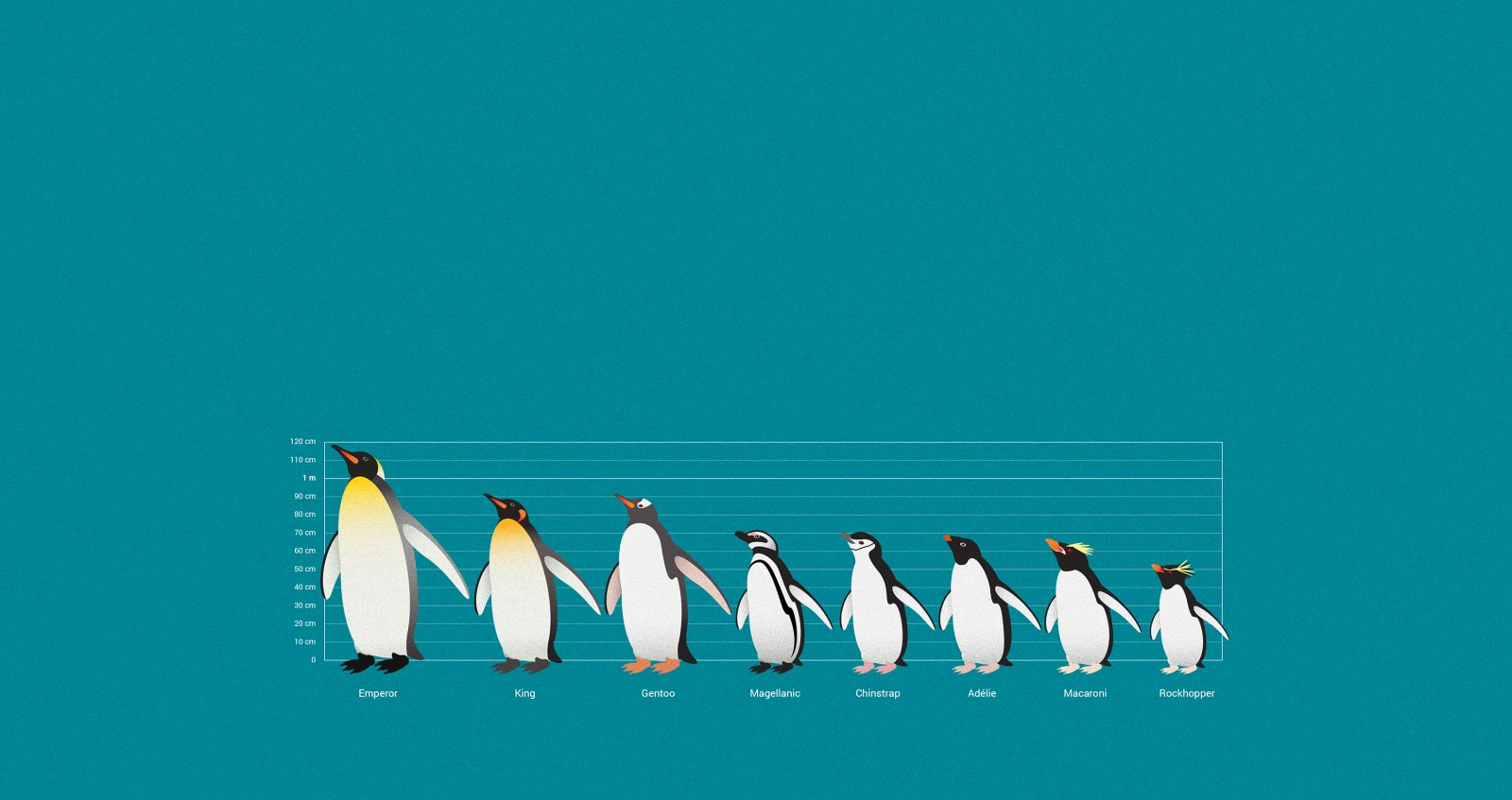
Regions: Antarctica
Destinations: Antarctic Peninsula, Ross Sea, Weddell Sea, Falkland Islands, South Georgia
Highlights: Emperor Penguin, Adelie Penguin, Chinstrap Penguin, Gentoo Penguin, King Penguin, Macaroni Penguin, Magellanic Penguin, Rockhopper Penguin
Penguin species from Antarctica to the Falklands
There are 17 species of penguin on the planet, but the eight you’ll most likely recognize live in Antarctica , its nearby islands, and the sub-Antarctic archipelagos of South Georgia and the Falklands . These are the core species we tend to see on our expedition cruises.
Of these eight types of penguin, two live exclusively on the Antarctic Continent (emperor penguins and Adélie penguins), three live in both northern Antarctica and the sub-Antarctic islands (chinstraps, macaronis, and gentoos), and three species of penguin reside exclusively in the sub-Antarctic (rockhoppers, Megallanics, and kings).
Here we’ll give you the key information on all of them. By the time you embark on one of our adventurous Antarctica cruises, you will be fully equipped to identify and discuss any of the eight great penguin species you might encounter.
Also, don’t miss our penguin “bird call” video at the end!
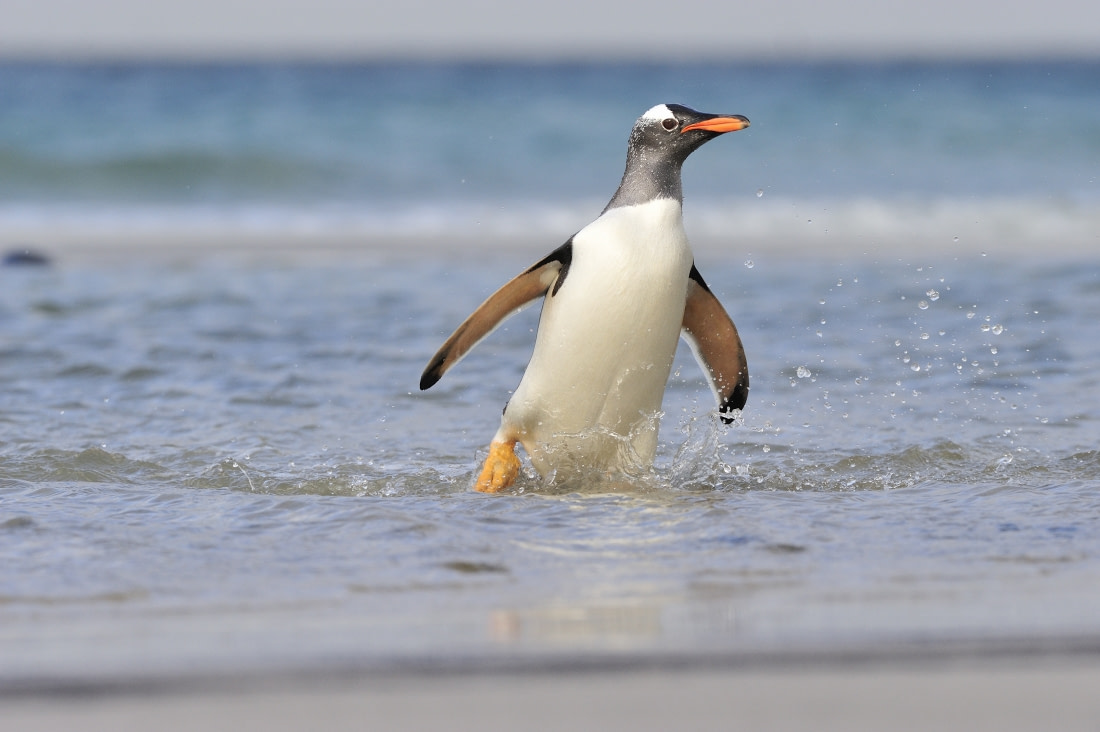
Picture by Martin van Lokven
1. Emperor penguin (Antarctica only)
Of all the penguin species on the planet, emperor penguins may be the most emblematic.
It helps that they're also the largest: Emperor penguins grow up to 122 cm tall (48 inches) and weigh 22 to 45 kg (49 to 99 pounds). They live on crustaceans, squid, and fish, and are usually found in the Ross Sea and Weddell regions, especially Snow Hill Island. Forming large colonies on the sea ice, emperor penguins rarely head north to sub-Antarctic waters.
Emperors are the only penguins (or any bird species) in the Antarctic that breeds during the winter. Baby emperor penguin chicks are born between the end of July and the middle of August, but they're unable to explore the sea alone until January.
Temperatures can plummet to -50 degrees Celsius (-58 degrees Fahrenheit) and winds reach speeds up to 200 kph (124 mph) during the emperor breeding period.
The female lays a single egg, then passes it over to the male, who incubates it while she heads to sea to feed. During a nine-week period, the male fasts while keeping the egg warm, losing up to 45 percent of his body weight.
When the female comes back in August, it's the male's turn to head out to sea and feed. He often has to trek up to 100 km (62 miles) over the ice to find food. Once fed, he returns and helps the female rear the chick. And when the sea ice starts to break up in December and January, the emperor penguin family heads out to sea. Scientists think the adults take the chick to sea when food is plentiful so that it can learn to be independent.
Emperor penguins dive deeper and longer than any bird, reaching over 200 meters (700 feet) and staying underwater for up to 18 minutes. And while they have a high survival rate, they're also the least common penguin: Only around 220,000 breeding pairs are alive today.
They live about 15-20 years in the wild.
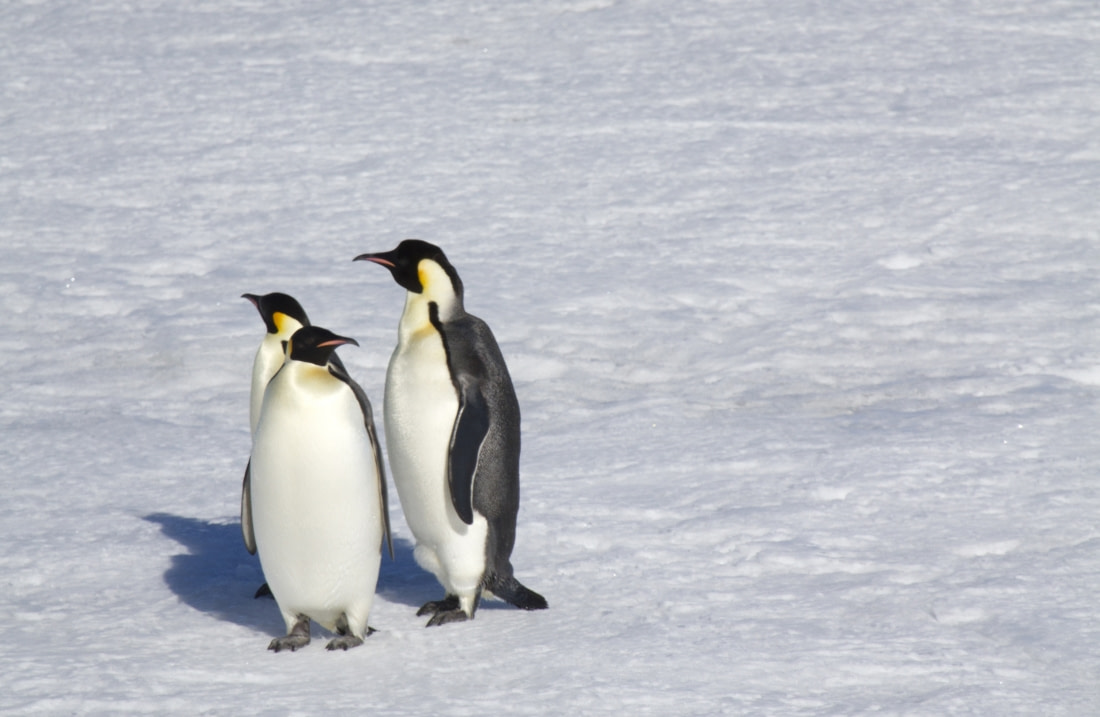
Picture by Douglas Newson

2. Adélie penguin (Antarctica only)
The most widely distributed penguin species in the world, Adélies are found on the northerly Antarctic pack ice during the winter and in the summer return to the continental coastline and Antarctic islands.
There are an estimated 2.5 million breeding pairs of Adélie penguins in Antarctica.
They weigh from 3.6 to 6.0 kg (7.9 to 13.2 pounds), grow between 46 to 71 cm (18 to 28 inches) tall, and their preferred diet is fish and krill . Though Adélie penguins can dive to 175 meters (574 feet), they usually catch their meals near the surface.
Adélie penguins live in tightly-packed breeding colonies that number in the thousands, giving birth to chicks during the Southern Hemisphere summer, usually in December.
Their breeding season is one of the shortest of all the penguin species, and courtship is similarly brief, with a lot of flipper-waving and calls. The Adélie female lays two eggs in mid-November, and both parents take care of them before they hatch.
Two to three weeks after the chicks hatch, the young Adélie penguins join a crèche, or nursery, before heading out to sea by February.
During the crèche stage, Adélie chicks are extremely vulnerable, and only about two-thirds survive. Once out to sea, however, the young Adélies are relatively safe and enjoy a typical lifespan of about 11-20 years.
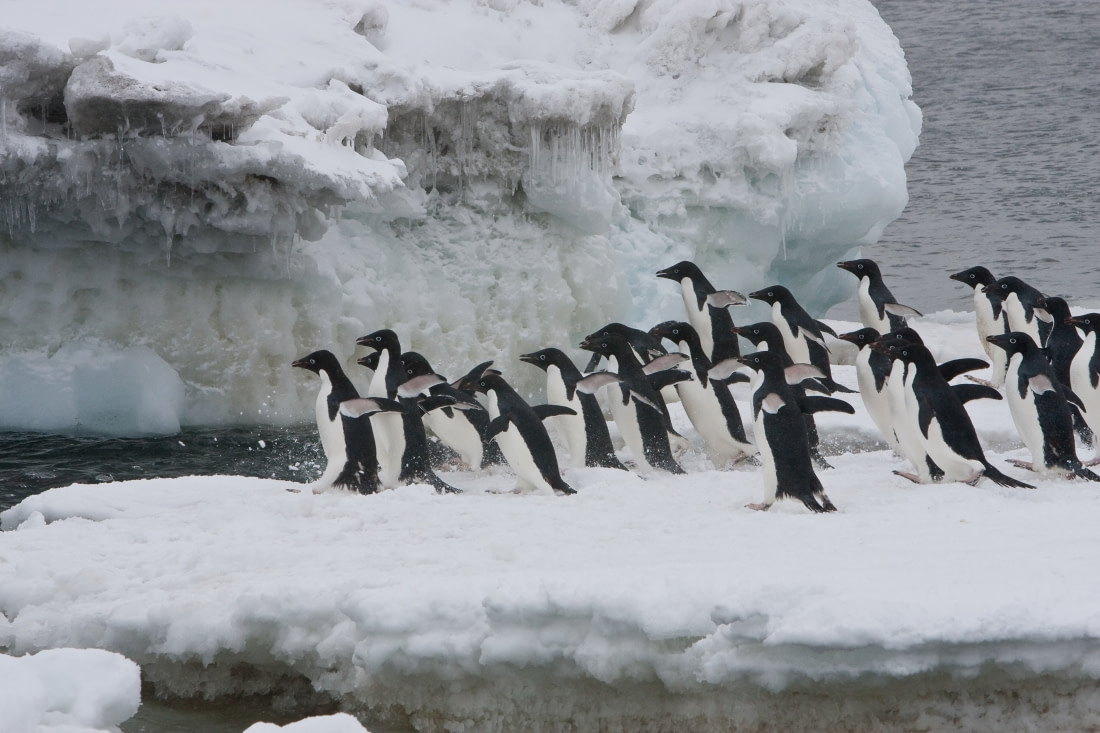
Picture by Jan Veen
3. Gentoo penguin (Antarctica and sub-Antarctic)
There are estimated to be about 300,000 breeding pairs of gentoo penguins in the Antarctic region, putting them second only to emperor penguins in terms of population scarcity.
As adults, gentoos are the third largest penguin behind emperors and kings, reaching 50 - 90 cm (19.7 - 35.4 inches) tall and weigh 4.5 - 8.5 kg (9.9 - 18.7 pounds). They feed on a diet of squid, fish, and crustaceans.
Gentoo penguins live in large, gregarious breeding colonies along the coastlines of the northern Antarctic Peninsula, South Sandwich Islands, South Shetlands, South Orkneys, and in the sub-Antarctic Falklands and South Georgia. They build nests on beaches and in grass tussocks and are highly aggressive in defending their turf.
Gentoos use stones to form their nests, and males often give stones to females as courtship gifts. They'll also attract females by “trumpeting” skyward, and if a female gentoo chooses a mate, both sexes point their bills at the nest the female has built.
Egg-laying can occur as early as June but in colder areas is delayed until December. Gentoo penguins are monogamous and have up to three breeding seasons, but generally they find new partners after that.
Female gentoo penguins lay two eggs, switching incubation duties with males daily. After hatching about 35 days later, it takes another month for gentoo penguin chicks to fledge, at which point they're able to venture out to the sea. Unlike other penguins, gentoo chicks fledge prior to becoming independent.
Gentoo penguins live about 15-20 years and are one of the fastest-swimming birds, reaching speeds up to 36 kph (22 mph).
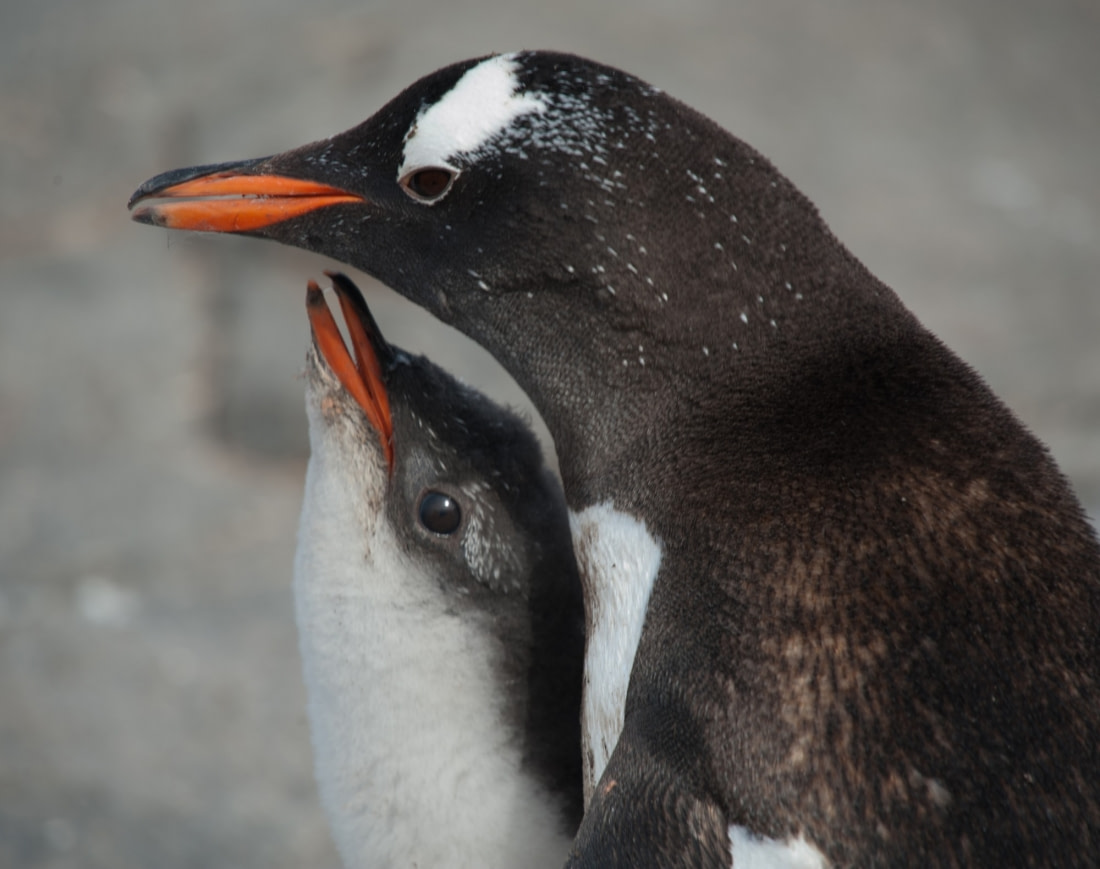
Picture by Erwin Vermeulen
4. Chinstrap penguin (Antarctica and sub-Antarctic)
With roughly seven million pairs of chinstrap penguins in the world, it's not surprising when one of these penguins is spotted from an expedition ship.
Adult chinstrap penguins are one of the most abundant penguins in the world, with an average height of 68 to 76 cm (27 to 30 inches) and weight between 3.2 to 5.3 kg (7.1 to 11.7 pounds).
They live on a diet of fish and krill, and typically have two chicks per mating season, born between late February and early March.
Chinstrap penguins are near-shore feeders, usually foraging among pack ice. And because they feed by pursuit, they have short dive times of less than a minute and seldom dive to depths of more than 60 meters (200 feet). Most of their dives are less than 45 m (150 feet).
When in water chinstrap penguins reach speeds of about 30 kph (18 mph), and on land they slide around the ice on their stomachs with their feet and flippers propelling them.
Chinstrap penguins live for about 20 years and breed in large colonies, even at times living on icebergs floating in the open ocean. They are also an aggressive species, often getting into fights with other penguins.
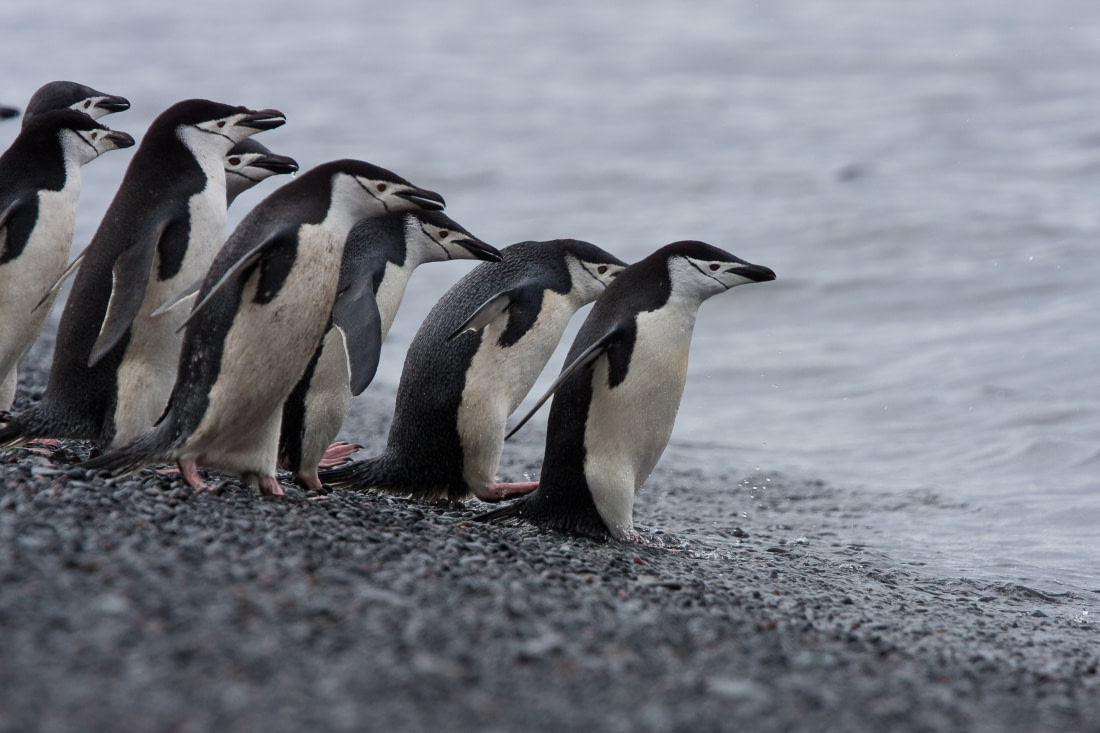
5. Macaroni penguin (Antarctica and sub-Antarctic)
These island-dwelling crested penguins have an estimated population of 12 million pairs. Adult macaroni penguins and chinstrap penguins are virtually identical in terms of height and weight, growing to around 70 cm (28 inches) and 5.5 kg (12 pounds), with a main diet of fish, krill, and squid.
Macaroni penguins are found close to the Antarctic Convergence, breeding in the Falklands, South Georgia, South Sandwich, and South Orkney Islands. They form huge colonies that can number in the hundreds of thousands and are located on hillsides as well as rocky cliffs.
In South Georgia, macaroni penguins arrive to breed in late October and lay their eggs two weeks later. Females lay two eggs, the first much smaller than the second, and the smaller egg rarely hatches.
Both parents share incubating duties, but it comes at a great energy expense: Adult macaronis lose up to half their body weight in the process.The young macaroni chick fledges for two months after hatching, with just one parent staying at home to look after it. This focus on raising one chick means that the macaroni penguin population doesn't have the boom-bust population cycle like some other penguin species.
Macaroni chicks grow enough within 10 weeks to leave their parents behind and integrate into the adult penguin population. They live about 15 years in the wild.
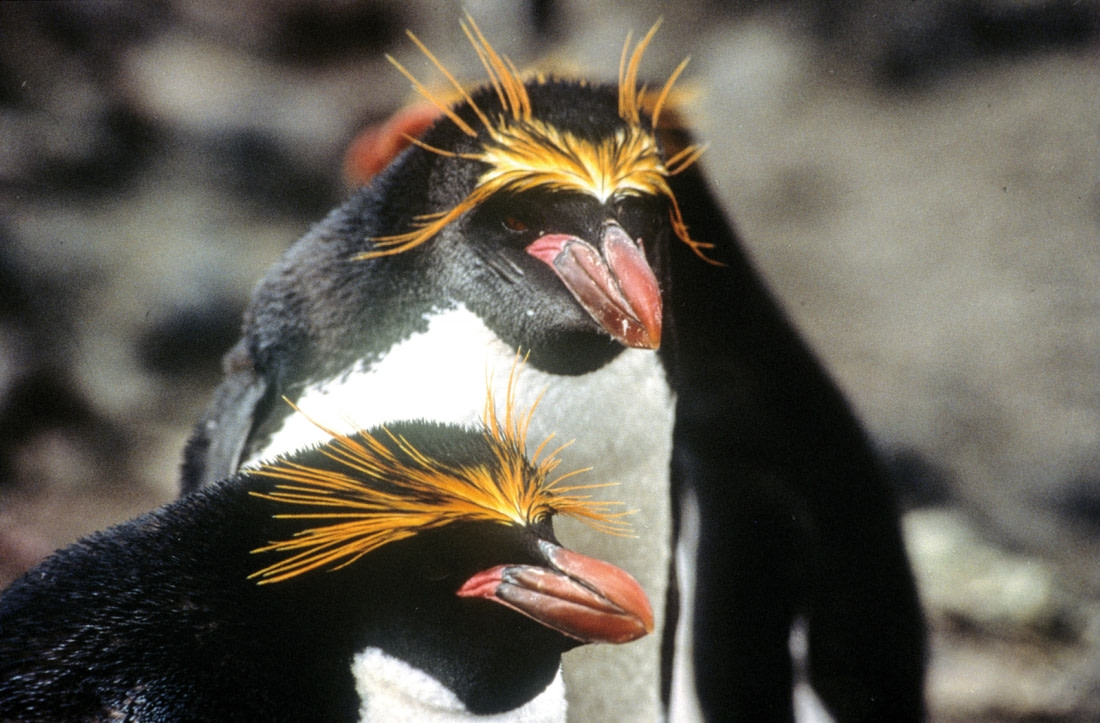
6. Rockhopper penguin (Antarctica and sub-Antarctic)
Because there's contention as to what distinguishes a rockhopper penguin , the species has been divided into three fairly distinct subspecies by reproductive behavior and breeding location: northern, southern, and eastern rockhopper penguin.
On our Antarctica voyages, we mostly see northern and southern rockhopper penguins.
Rockhoppers are one of the smallest penguin species, and the smallest of the crested penguins, with an average height of 50 cm (19.7 inches) and weight of 2.5 kg (5.5 pounds). They usually stick to shallow water but can dive up to 100 meters (330 feet) in pursuit of prey, which consists mostly of fish, krill, and small crustaceans.
Rockhopper penguins get their name from their preferred habitat of rocky, windswept shorelines on the islands north of Antarctica.
During their annual breeding times, rockhoppers gather in chatty colonies that often number in the hundreds of thousands. They construct burrows in tall tussock grasses near shore, returning each year to the same breeding site, nest, and sometimes, the same mate.
Habitat loss, human disturbance, and starvation due to commercial fishing has led to a nearly 30% decline in rockhopper penguin population over the last 30 years, putting the most recent population estimate at 1.5 million breeding pairs.
Rockhopper penguins live to be about 10 years old in the wild.
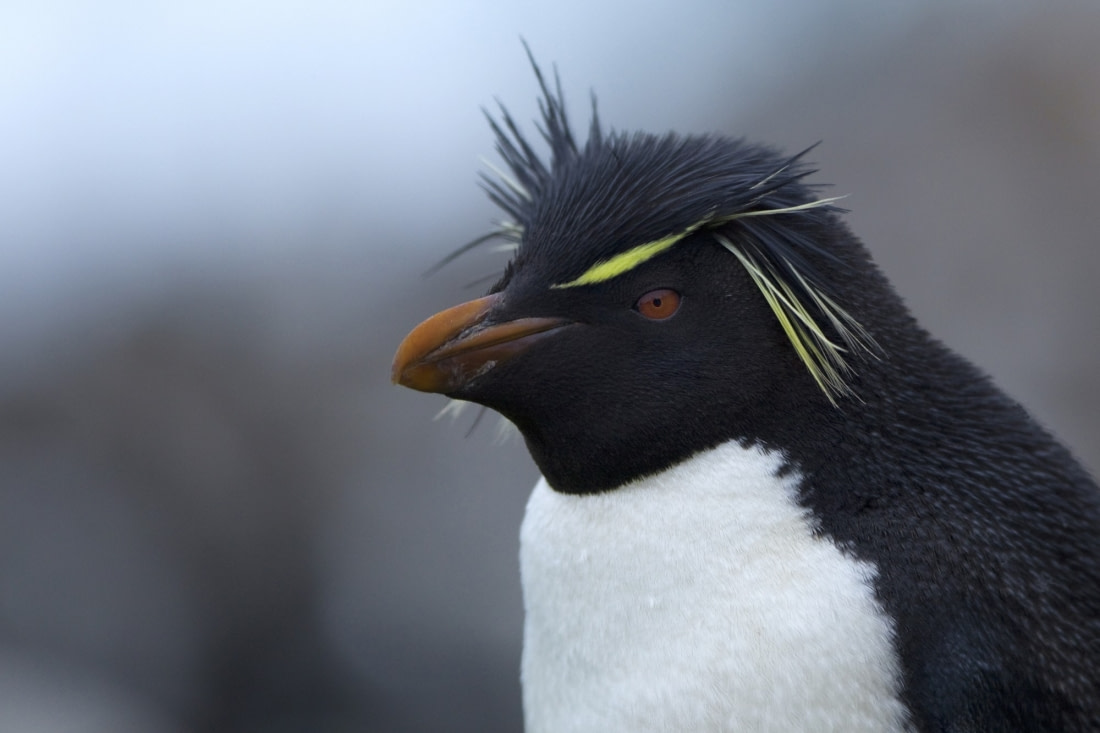
Picture by Wim van Passel
7. Magellanic penguin (sub-Antarctic)
These penguins are named after the famous explorer Ferdinand Magellan, and are closely related to Galápagos penguins, Humboldt penguins, and African penguins.
Magellanic penguins stand between 60 to 75 cm (23.6 to 29.5) tall and weigh around 2.5 to 6.5 kg (5.5 to 14.3 pounds). They tend to be shy around humans, running for cover in their nesting burrows if people are near. And if it gets too hot, they will shed beak feathers, pant, and stretch their flippers to catch a breeze and release excess heat.
Magellanic penguins are primarily found around the Falkland Islands and South America, where they are numerous, but scant vagrant populations have been recorded in South Georgia and the South Shetlands.
The Falklands population, in fact, is over 100,000 breeding pairs, but this is small compared to South America, where Magellanic penguins number around 900,000 breeding pairs in Argentina and 800,000 pairs in Chile.
Magellanics like islands with dense vegetation and deep layers of soil for burrowing, which offers protection from aerial predators.
Opportunistic feeders, Magellanics take equal proportions of fish, squid, and crustaceans. While out to sea, they usually forage at depths of less than 50 meters (165 feet), but may at times dive up to 100 meters (330 feet).
Magellanic penguins are comparably long-living, reaching around 25 years in the wild.
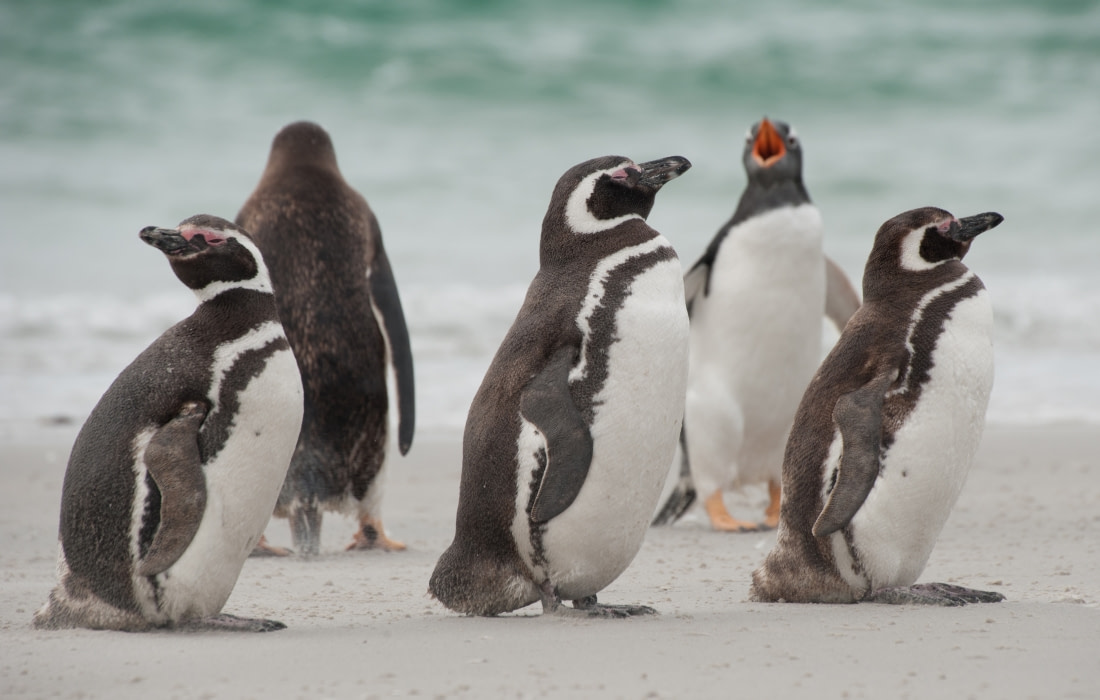
8. King penguin (sub-Antarctic only)
King penguins are the second-largest penguin species after emperors: Once they reach full maturity, they weigh about 16 kg (35 pounds) and stand 94 cm (37 inches) tall.
The estimated 2.2 million breeding pairs of king penguins dine on squid and fish, and live along the coastlines of the sub-Antarctic islands. They are the most marine of all penguins - and indeed all birds, spending more time at sea than any other.
King penguins can dive to depths of more than 300 meters (985 feet) to pursue prey, staying underwater for up to nine minutes.
They are highly social birds that gather in massive colonies (like the St. Andrews Bay rookery of over 150,000 members) to breed. King penguins have an unusual breeding timeframe that lasts approximately 14 months from courtship to the fledging of the chick.
Not natural nest builders, king penguins instead lay one green-white egg that they incubate on their webbed feet and below a fold of skin.
King penguins are known by scientists to have mid-afternoon naps, sleeping more deeply after lunch than during the morning. They live to be about 25 years old in the wild.
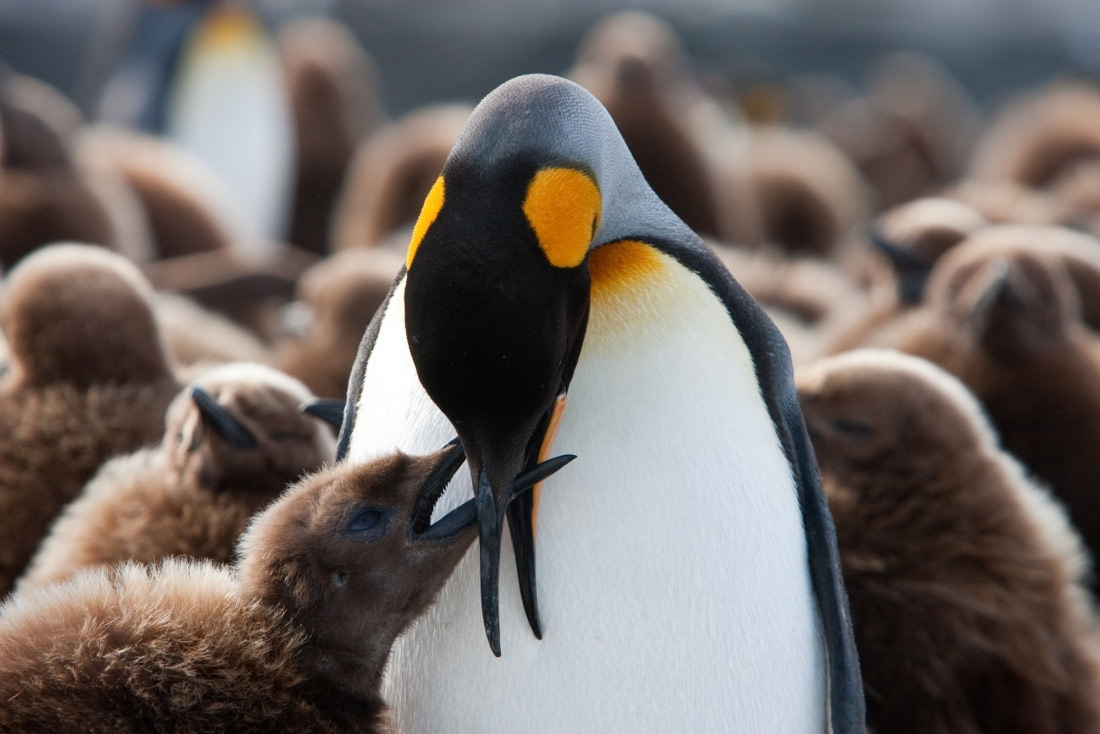
Picture by Ilja Reijnen
See and hear these eight penguins in their Antarctic habitat
There’s only so much writing and pictures can communicate about the beauty of polar wildlife. Ultimately, you just need to experience it in person. But if you still need convincing before you book an Antarctica cruise , check out the video below for some great shots (and sounds) of both species and scenery.
Related cruises
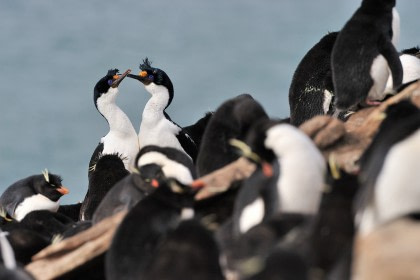
Falkland Islands - South Georgia - Antarctica
Meet at least six penguin species!
PLA20-24 A cruise to the Falkland Islands, South Georgia & the Antarctic Peninsula. Visit some of the most beautiful arrays of wildlife on Earth. This journey will introduce you to at least 6 species of penguin and a whole lot of Antarctic fur seals!
m/v Plancius
Cruise date:
18 Oct - 7 Nov, 2024
Berths start from:
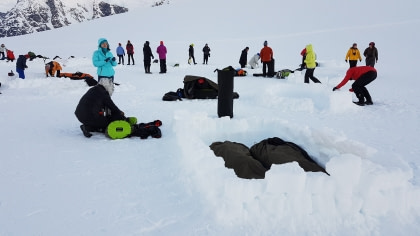
Antarctica - Basecamp - free camping, kayaking, snowshoe/hiking, photo workshop, mountaineering
The best activity voyage in Antarctica
HDS21a24 The Antarctic Peninsula Basecamp cruise offers you a myriad of ways to explore and enjoy the Antarctic Region. This expedition allows you to hike, snowshoe, kayak, go mountaineering, and even camp out under the Southern Polar skies.
m/v Hondius
1 Nov - 13 Nov, 2024
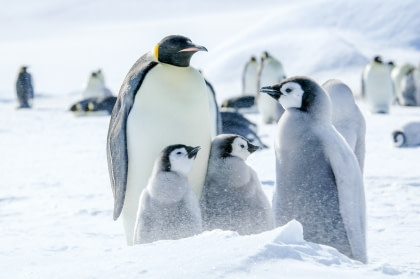
Weddell Sea – In search of the Emperor Penguin, incl. helicopters
Searching for the Elusive Emperor Penguins
OTL22-24 A true expedition, our Weddell Sea cruise sets out to explore the range of the Emperor Penguins near Snow Hill Island. We will visit the area via helicopter and see a variety of other birds and penguins including Adélies and Gentoos.
m/v Ortelius
10 Nov - 20 Nov, 2024
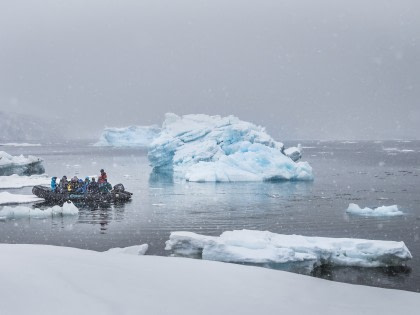
OTL23-24 A true expedition, our Weddell Sea cruise sets out to explore the range of the Emperor Penguins near Snow Hill Island. We will visit the area via helicopter and see a variety of other birds and penguins including Adélies and Gentoos.
20 Nov - 30 Nov, 2024
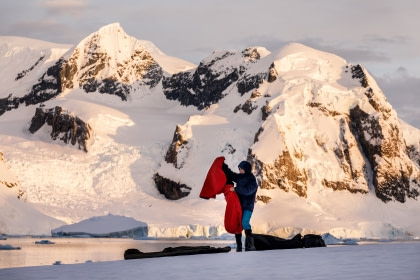
Antarctica - Basecamp - free camping, kayaking, snowshoe/hiking, mountaineering, photo workshop
HDS23-24 The Antarctic Peninsula Basecamp cruise offers you a myriad of ways to explore and enjoy the Antarctic Region. This expedition allows you to hike, snowshoe, kayak, go mountaineering, and even camp out under the Southern Polar skies.
23 Nov - 5 Dec, 2024
We have a total of 62 cruises
- TRAVEL AGENTS
- TESTIMONIALS

Expedition Cruises
- Fridtjof-Nansen
- Roald Amundsen
- Polar Pioneer
- Ocean Diamond
- Ocean Adventurer
- Ocean Endeavour
- G-Expedition
Expedition+Luxury Cruises
- Greg Mortimer
- Sylvia Earle
- Ocean Albatros
- Ocean Victory
- NatGeo Explorer
- Heritage Adventurer
- Magellan Explorer
- Ultramarine
- World Explorer
- Ocean Explorer
Luxury C ruises
- Silver Cloud
- Silver Wind
- Le Commandant Charcot
- World Traveller
- Silver Endeavour
- Seabourn Venture
- Seabourn Pursuit
- Scenic Eclipse
- Viking Octantis
- Viking Polaris
- World Navigator
Antarctica – South Georgia & Falklands
- Antarctic Peninsula
- South Georgia
- Falkland Islands
- East Antarctica | Ross Sea
- New Zealand Sub Antarctic Islands
Pre & Post Cruise Extensions
- Galapagos Islands & Ecuador
- Easter Island
- City Stopover & Iguazu Falls
- Machu Picchu & Peru
- ANTARCTICA GUIDE
- AUS 1300 787 987
A Guide to the Penguins of Antarctica: When and Where to Spot Them
Antarctica Cruise
Embarking on a cruise to the icy waters of Antarctica offers a unique opportunity to witness the diverse array of penguin species that inhabit this frozen wilderness. From the regal Emperor penguins to the sprightly Adélies, each species presents a fascinating glimpse into the resilience of life in the harshest of environments. In this article, we will explore the habitats and seasonal patterns of the various penguin species one may encounter on an Antarctic cruise, providing insights into the best times and locations for sightings.

Emperor Penguins: The Majestic Monarchs of the Ice
The largest of them all.
The Emperor penguin ( Aptenodytes forsteri ) stands as the tallest and heaviest of all living penguin species, with an impressive stature that can reach up to 122 cm in height. These majestic birds are best seen during the austral spring, particularly in October and November, when they are tending to their young on the sea ice.
Breeding on the Pack Ice
Emperor penguins breed in the coldest environment of any bird species; they lay their eggs directly on the ice during the Antarctic winter. The most reliable place to spot them is in the Weddell Sea, especially around Snow Hill Island, where an estimated population of 10,000, including breeding pairs and offspring, can be found.
King Penguins: The Second-Largest and Social Birds
Striking appearance.
King penguins ( Aptenodytes patagonicus ) are easily recognized by their striking orange-yellow cheek patches. They are the second-largest penguin species and can be observed on sub-Antarctic islands such as South Georgia and the Falkland Islands.
Year-Round Sightings with Peak Mating Seasons
While King penguins can be seen throughout the year, their mating behaviors peak in November and March. These birds do not have a specific breeding season, and their unusual breeding cycle lasts approximately 14 months.
Adélie Penguins: The True Antarctic Specialists
Classic black and white.
Adélie penguins ( Pygoscelis adeliae ) are the quintessential Antarctic penguin, with a black and white appearance and a distinctive white ring around their eyes. They breed on exposed rocks along the Antarctic coastline and are most active during the austral summer months of December to February.
Largest Colonies at Cape Adare
The largest Adélie penguin colony is at Cape Adare in the Ross Sea, where visitors can witness over a million pairs during the summer. These penguins are widely distributed and are a common sight on the Antarctic Peninsula.
Gentoo Penguins: The Fast Swimmers with a Wide White Stripe
Third largest penguin species.
Gentoo penguins ( Pygoscelis papua ) are known for their bright orange-red beaks and the distinctive white stripe across the top of their heads. They are the third-largest penguin species and breed on sub-Antarctic islands and the Antarctic Peninsula.
Breeding and Raising Chicks in Summer
The best time to see Gentoo penguins is during the Antarctic summer, from December to February, when they are breeding and raising their chicks. They are most active during this period and can be seen on virtually all trips to the Antarctic Peninsula.
Chinstrap Penguins: The Abundant Species with a Namesake Marking
Thin black stripe feature.
Chinstrap penguins ( Pygoscelis antarcticus ) are named for the thin black band that runs under their chin. They breed on sub-Antarctic islands and the Antarctic Peninsula, with one colony on the South Sandwich Islands believed to contain over 10 million birds.
Peak Breeding Season in Summer
The peak breeding season for Chinstrap penguins is during the austral summer, making December to February the ideal time for sightings. They are one of the most abundant penguin species and are a common sight on the Antarctic Peninsula.
Macaroni Penguins: The Crested Beauties with Large Populations
Distinguished by their crests.
Macaroni penguins ( Eudyptes chrysolophus ) are known for their prominent orange-yellow crests. They are virtually identical in size to Chinstrap penguins and breed on sub-Antarctic islands such as South Georgia and the South Orkney Islands.
Millions of Breeding Pairs
With a total breeding population estimated to be 12 million pairs, Macaroni penguins form huge colonies and are best seen during the austral summer months when they are actively breeding.
Rockhopper Penguins: The Small and Agile Climbers
Distinctive yellow crests.
Rockhopper penguins ( Eudyptes chrysocome ) are one of the smallest penguin species, recognized by their yellow head crests and red eyes. They breed on sub-Antarctic islands and are known for their hopping movements.
Breeding on Windswept Shorelines
Rockhoppers prefer rocky, windswept shorelines and can be observed during their breeding season, which peaks in the austral summer months. They are divided into three subspecies based on reproductive behavior and breeding location.
Magellanic Penguins: The Burrowers with a Broad Black Band
Named after ferdinand magellan.
Magellanic penguins ( Spheniscus magellanicus ) have a broad black band under their chin and another that runs in an inverted horseshoe shape around their fronts. They breed in various locations, including the Falkland Islands and South America.
Breeding in Dense Vegetation
These penguins prefer islands with dense vegetation and deep layers of soil for burrowing. The best time to see them is during their breeding season, which occurs from November to February.
FAQs About Penguins in Antarctica
When is the best time to see penguins in antarctica.
The best time to see penguins in Antarctica is during the austral summer, from December to February, when they are breeding and raising their chicks.
Where can I see Emperor penguins?
Emperor penguins can be seen in the Weddell Sea, particularly around Snow Hill Island, during October and November.
Can I see King penguins on the Antarctic Peninsula?
King penguins are not typically found on the Antarctic Peninsula; they are more commonly seen on sub-Antarctic islands such as South Georgia and the Falkland Islands.
Are there any penguins that breed during the Antarctic winter?
Yes, Emperor penguins are the only species that breed during the Antarctic winter, laying their eggs directly on the sea ice.
Related post
Science at sea: educational opportunities on antarctic cruises, photographing antarctica: a cruiser’s guide to capturing the frozen continent, luxury antarctic cruises: experiencing the pinnacle of polar travel, history unveiled: exploring the historic sites of antarctica on a cruise, eco-friendly antarctic cruising: how to responsibly explore the white continent, crossing the drake passage: tips for smooth sailing on your antarctic journey.

Call Us: +1 (206) 618-1107
When to See Penguins in Antarctica

Over the years, I’ve sent over 1000 travelers to Antarctica and though many go for the sheer adventure of it, some to set foot on their 7th continent, and some just to have bragging rights, there have been a fair number of animal lovers who have gone mostly to fulfill their dream of seeing penguins. And penguins are remarkable! They’re definitely worth crossing the sometimes very rough seas of the Drake Passage for. I feel honored to help people make their penguin dreams come true. They’re so much fun!
But when should you go to Antarctica to see penguins? Trips to Antarctica travel between November and March yet it’s important to know exactly which penguins are doing what during which months so you don’t go at a time when penguin viewing will be less than stellar.
November is a beautiful time to go to Antarctica. It’s the beginning of the season and the three main species of penguins who live on the Antarctic Peninsula, the Gentoos , the Chinstraps, and the Adelies , are just coming out of the sea after their winter away. They’re climbing onto the shoreline, greeting old friends, looking for their mate, and getting ready for their breeding season.
The shores of Antarctica are particularly stunning and pristine in November as the penguins haven’t yet spread their red guano around everywhere. But wait! You wanted to see baby penguins and sadly November is too early to see babies . November and early December are a time to see adult penguins and witness their breeding rituals: lots of loud calls and pebble exchanging!
A good time to see baby penguins is right around December 19 . Over the years I’ve refined this date and some years it’s a day or two earlier and some years it’s a day or two later yet if you plan to be in Antarctica on December 19, you’ll see those adorable little fur balls.

What’s happening in January? J anuary is when the babies start to grow into teenagers and they don brown furry coats. They always make me think of those long fur coats college men used to wear in the 1920’s. They’re almost as cute as the babies so if you plan to visit Antarctica in January, I know you’ll love seeing the teenagers. The furry coated one below is a King Penguin yet you get the idea.

By the time February rolls around, all the teenagers have become adults and then all the penguins look pretty much the same again. Mid to late February is the time when penguins head back into the sea so it’s important for penguin lovers to choose a trip that leaves the Antarctic Peninsula by Feb 22. Late February departures won’t see as many penguins as you would have seen earlier in the year. And March is a time when the only penguins left on shore are the ones who couldn’t figure out how to swim. If you hope to see penguins, don’t travel in March. Antarctica is still amazing in March and people go for the Aurora Australis at that time because it’s darker at night yet penguin people should travel to Antarctica before Feb 22.
Three foot tall King penguins can be seen anytime on South Georgia and the Falkland Islands between November and March. They do their mating behaviors in November and March and you can see baby penguins on most of the trips that travel there.
A word about guano. Penguins leave a lot of guano on the ice in Antarctica and it’s red. This means if you are traveling in late February or March when the penguins have been on shore since November, you are going to see a lot of red guano on the once pristine whiteness. This can be shocking if you’re not expecting it. Any travel planner who offers you a late February or March trip without telling you about the red guano are doing you a disservice.
That’s why you need experts like the ones we have here at Wild Nectar. Check out o ur amazing Antarctica trips . Contact us . We love making your penguin dreams come true!
Related Posts
Antarctica Short or Long? Which Trip Length is for You?
Why You Need to See Polar Bears Now (or Very Soon)
Why So Shy? The Hidden Animals of the Amazon
Best Time to Visit Antarctica
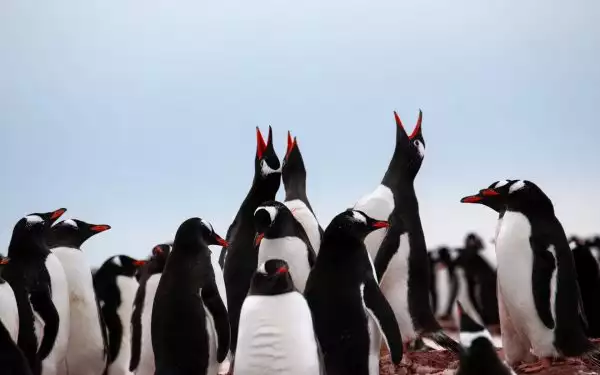
So, you want to travel to Antarctica, but you are wondering when to go. The Antarctic travel season coincides with the austral summer beginning in October and running through March. Many travelers ask us “When is the best time to visit Antarctica?” or “What is the weather like in Antarctica in January?”
The best time to visit Antarctica is from mid-December through mid-February. The best month to take an Antarctic cruise is January. Of course, there is much more to it than that. The Antarctic travel season is short. Weather, wildlife, sunlight and sea conditions vary greatly between spring, summer and fall.
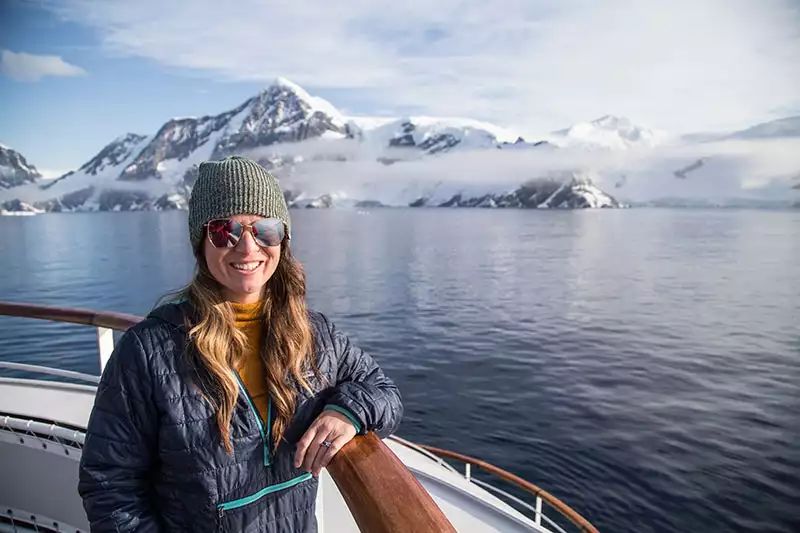
IN THE KNOW ON WHEN TO GO
Expert insights, delivered to your inbox.
IN THIS POST – Best Time to Visit Antarctica: Antarctica Seasons Month By Month: – Oct , Nov , Dec , Jan , Feb , Mar Best Time for: – Drake Passage & Cruising – Penguins & Whales Why Latitude Matters Antarctica Climate Tables What Is the Best Month in Antarctica? More Resources
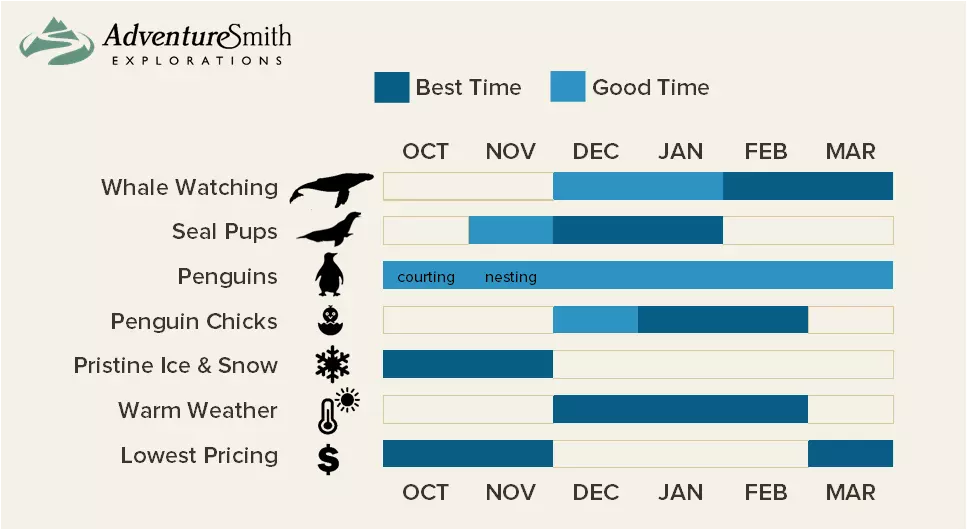
Antarctica Seasons: When to go & Why
Below we outline best seasons for Antarctica and what to expect during each Antarctic season. Remember that in the Southern hemisphere the seasons are opposite of those in North American and Europe. Winter in the northern hemisphere is summer in Antarctica.
Antarctic Spring
Spring in Antarctica begins in late October and runs through November. Antarctica in spring is characterized by cold temperatures, snow and frozen sea ice. Sea ice is at its maximum, an average of 22 million square miles, which can restrict where ships are able to go.
In the early Antarctic spring, most wildlife has not yet emerged, except for Emperor Penguins, which have overwintered on the ice. Specialty trips to view Emperor penguin colonies are sometimes offered in November.
The season to visit Antarctica begins in earnest in November. Mid to late Spring in Antarctica is characterized by the icy landscape awakening. Days are getting longer and temperatures are warming. Sea ice is common, and penguins are starting to arrive to build nests.
Antarctic spring is the best time to go to Antarctica for skiers, snowboarders and photographers set on massive icebergs and icy, white landscapes.
Antarctica Summer
Antarctica in the summer is spectacular and this is the peak of the travel season. Summer in Antarctica begins in December and runs through January. The temperature in Antarctica in the summer is surprisingly mild with highs in the 50’s F and lows in the 20’s F.
Sea ice is melting and gone by the end of Antarctic summer. This opens bays, inlets and passages south to the Arctic circle. Spring storms abate and summer in Antarctica offers a better chance of calm seas while crossing the Drake Passage.
Penguins and wildlife are most active during the Antarctic summer. Depending on latitude, (more on why latitude matters below) penguins lay their eggs in early summer and chick are born in mid-summer. Seabirds are feasting on the ocean’s bounty. Seals have come ashore to give birth to pups. Whales begin to arrive to feed on rich seas.
Antarctica Fall
Autumn in Antarctica begins in March and ends by April. Days are getting shorter, temperatures are falling and the travel season winds down by late March. Sea ice is greatly reduced from 22 million miles of sea ice in September to only 5.4 million square miles of sea ice in September. This means more bays and inlets are available for ships and the polar circle is more easily reached in the fall.
Fall in Antarctica is the best time to view whales. Ice free waters, enriched by the summer sun, provide a bounty of krill and small fish which by now have attracted large pods of migrating whales. Penguin parents have left for the open sea and chicks are ready to follow. Seal pups are also heading into the ocean and can be a target for Orca whales.
Photographers seeking spectacular sunsets love the fall Antarctic season. Visitors may also catch a glimpse of the aurora australis or southern lights during dark nights.

Antarctica Weather & Wildlife by Month
What follows are detailed insights into Antarctica weather and wildlife by month for the entire travel season. Our expert compile their advice to help you determine the best time to visit Antarctica. Antarctica temperature listed below in Fahrenheit.
Antarctica In October
Be among the first to witness Antarctica as it awakens from the long winter. Antarctica in October is pristine, cold and a skier’s dream with white-capped peaks. We consider this the best time to go to Antarctica for skiers, snowboarders and photographers set on those icy, white landscapes. Specialty trips to view emperor penguins are sometimes available in October.

Antarctica Weather in October
- Average temperature in Antarctica in October: 22-29 degrees & 14 hours of daylight
- South Shetland Islands Temperature in October: 17-25 degrees & 15 hours of daylight
- South Georgia Island Temperature in October: 28-41 degrees & 14 hours of daylight
Benefits Visiting Antarctica in October
- Abundant sea ice, dynamic ice floes, large icebergs, all excellent for photography
- Wintering scientists look forward to visitors, make enthusiastic hosts at research stations
- Specialty trips to view Emperor penguins
- Feels like Antarctica! On cold days you’ll dress like you’re at the South Pole
Antarctica Wildlife in October
- Seabirds including skuas, albatross and petrels begin breeding activities
- Adelie, gentoo and chinstrap penguins begin the breeding cycle with courtship rituals
- Emperor penguin rookeries in the Weddell Sea may become accessible
- Crabeater seals are born
Antarctica in November
If you choose to visit Antarctica in November, you can enjoy more activities like kayaking and camping. You’ll witness nest-building behaviors from penguins. Availability starts to really ramp up with more ships making the voyage across the Drake Passage. November is the best month to go to Antarctica for active travelers. Skiing, snowboarding and snowshoeing are available only in November. Kayaking, mountaineering and camping become available as well.

Weather in Antarctica in November
- Average temperature in Antarctica in November: 25-32 degrees & 15.5 hours of daylight
- South Shetland Islands temperature in November: 21-26 degrees & 18 hours of daylight
- South Georgia Island Temperature in November: 30-44 degrees & 16 hours of daylight
Benefits of Visiting Antarctica in November
- Pack ice begins to melt, opening up the 7 million square miles of the frozen Southern Ocean
- Longer days and lots of ice mean November is best time for landscape photographers
- Camping options begin and continue through February (select departures)
- Kayaking options begin and continue the rest of the Antarctic season (select departures)
- Early season prices are often the lowest of the year
Antarctica Wildlife in November
- Adelie, chinstrap & gentoo penguins find mate, build nests and lay eggs
- King penguins on South Georgia Island lay eggs & incubate on their feet by late November
- Albatrosses are spotted in the skies in Antarctica in November
- Spring wildflowers bloom in the Falkland Islands
- Elephant seals begin courting on South Georgia Island
- Ships are sometimes able to park on the sea ice, allowing guests to walk the frozen sea
- Fur seals mate & establish breeding territories. Aggressive mating rituals can be observed
Antarctica in December
Antarctica weather in December really heats up (well, relatively) thanks to more daylight around the solstice. The weather in Drake Passage in December also offers an increased chance for calmer seas. December is the best time for family Antarctica travel. December in Antarctica coincides with school holidays and offers great daylight and warmer temperatures with great penguin activity. December is the busiest travel month in Antarctica, so it is best to book early. Holiday cruises can sell out nearly one year in advance.
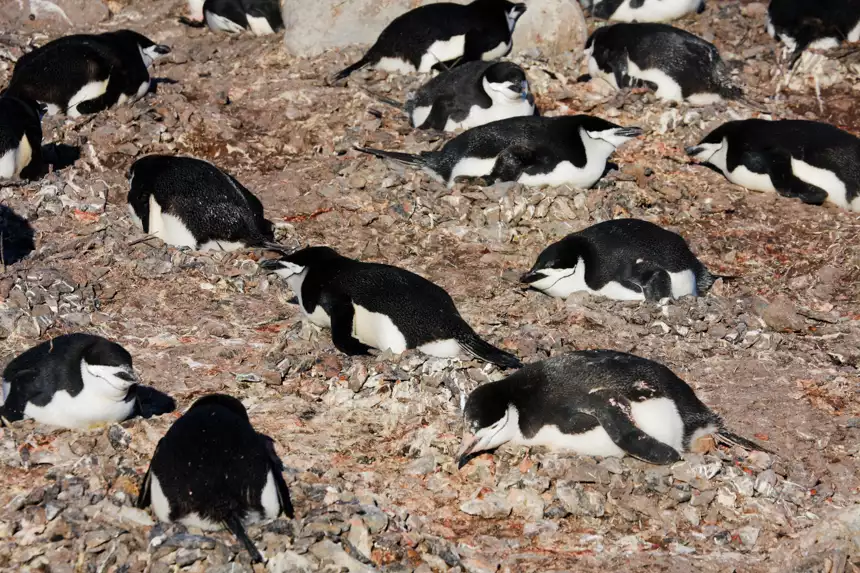
Antarctica Weather in December
- Average temperature in Antarctica in December: 29-34 degrees & 16.5 hours of daylight
- South Shetland Islands temperature in December: 23-27 degrees & 20 hours of daylight
- South Georgia Island temperature in December: 32-46 degrees & 17 hours of daylight
Benefits of Visiting Antarctica in December
- Good chance for calmer seas crossing the Drake Passage
- Warmest months and nicest weather of the Antarctica seasons begins
- Glaciers are actively calving as temperatures rise
- Research and station visits peak in Antarctica beginning in December
- Long days with midnight sun create more opportunities for exploration & wildlife viewing
- Whales are beginning to arrive in Antarctica
- Spring wildflowers bloom on South Georgia Island
- Historic whaling village of Grytviken & Shackleton grave accessible on South Georgia Island
Antarctica Wildlife in December
- Whales starting to arrive to Antarctica in December
- Leopard, Crabeater, Weddell & Elephant seal pups are commonly seen on ice floes
- Penguins, petrels and cormorants are laying eggs and sitting on their nests
- Penguin chicks begin to hatch in late December in Antarctica
- Penguin chicks begin to hatch in early December in the Falkland Islands.
- Fuzzy brown King penguin chicks are hatching on South Georgia Island
- Wandering albatross return to lay eggs on South Georgia Island
Antarctica in January
Being the height of the travel season with cruises in full swing, travelers often ask “What is the weather like in Antarctica in January.” The weather in Antarctica in January is excellent, with average temperatures reaching their highest of the year. Undoubtedly January is the warmest month in Antarctica. January is the best time to go to Antarctica because of calm weather, calm seas and abundant wildlife.
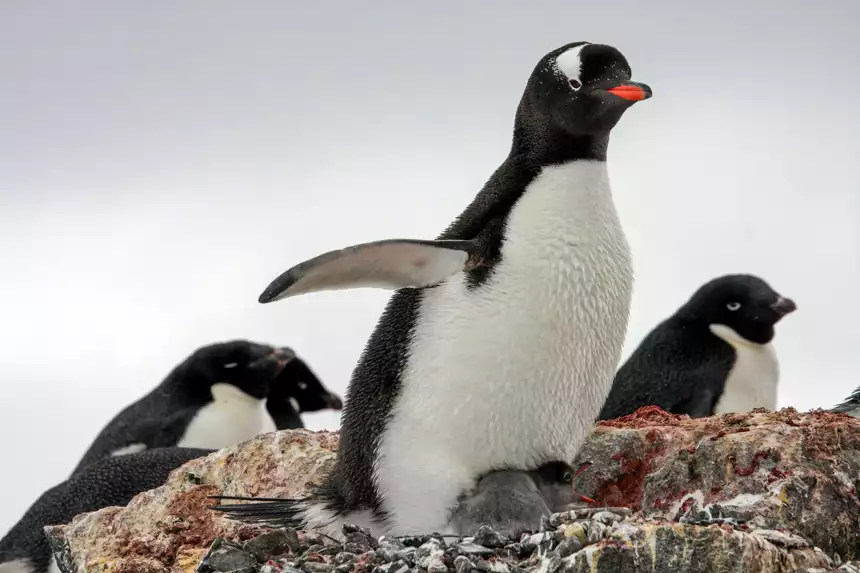
Weather in Antarctica in January
- Average temperature in Antarctica in January: 33-36 degrees & 16 hours of daylight
- South Shetland Islands temperature in January: 25-29 degrees & 19 hours of daylight
- South Georgia Island temperature in January: 32-46 degrees & 16.5 hours of daylight
Benefits of Visiting Antarctica in January
- January is the warmest month in Antarctica with average high of 36 degrees
- Zodiac cruises are intriguing with melting icebergs, shaped by the sun
- Sea ice opens allowing for visits to more landing sites and wildlife
- Certain itineraries start attempting to reach the Antarctic circle
- Historical huts of Shackleton and Scott in the Ross Sea are accessible
Antarctica Wildlife in January
- Hatching or newly hatched penguins are abundant
- Penguin feeding frenzies begin as parents bring their young food from the sea
- Baby Antarctic terns are hatching
- Baby seals are lounging about with their parents
- Whale sightings are increasing
- Population of King penguins on South Georgia Island is highest
Antarctica in February
February is the best time to see whales in Antarctica. If you like whale watching, this is your month. It’s the best time to visit Antarctica for predictable whale watching, penguin chick activity ashore, and the shorter days lend themselves to excellent sunrises and sunsets punctuated by those whale tails. The weather in Antarctica in February is begging to cool and days are getting shorter. Fall is fast approaching.

Weather in Antarctica in February
- Average temperature in Antarctica in February: 28-34 degrees & 14.5 hours of daylight
- South Shetland Islands temperature in February: 25-33 degrees & 16 hours of daylight
- South Georgia Island temperature in February: 35-48 degrees & 15 hours of daylight
Benefits of Visiting Antarctica in February
- Best time to view whales. Long days generate plankton blooms, a buffet for feeding whales
- This is the best time to visit Antarctica for orca, minke and humpback whale watching
- Receding ice opens up and allows for even more exploration
- Epic sunrises and sunsets as days get shorter
Antarctica Wildlife in February
- Molting penguin chicks are running about
- Adult penguins are busy swimming after krill to feed their chicks
- Playful fur seal and leopard seal pups are commonly seen
- Whales become predictable visiting feeding areas sometimes traveling in large pods
- Orca whales arrive to feed seal pups and penguin chicks learning to swim
- Abundant fur seal populations
- Elephant seals come ashore to molt
- King Penguin chicks on South Georgia Island are beginning to mold
Antarctica in March
March is the best month to go to Antarctica if you are seeking color! Algal blooms, night sky viewing, sunsets and possible sightings of aurora australis all make Antarctica in March a fascinating month. March is the best time of year for polar circle cruises to accomplish this bucket list goal. March is also a good time to find Antarctica cruise deals since the season is winding down and the weather is turning cooler. March in Antarctica is characterized by shorter days, colder weather and waterways virtually free of sea ice.
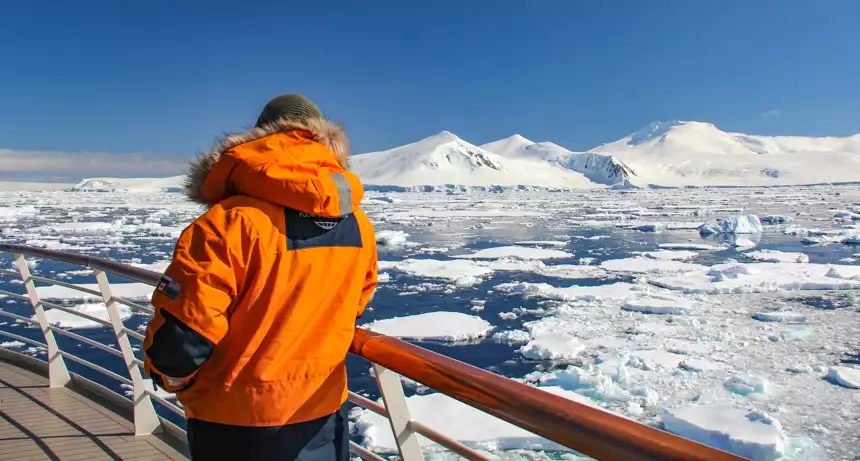
Antarctica Weather in March
- Average temperature in Antarctica in March: 26-32 degrees & 12.5 hours of daylight
- South Shetland Islands temperature in March: 22-30 degrees & 13 hours of daylight
- South Georgia Island temperature in March: 33-46 degrees & 13 hours of daylight
Benefits of Visiting Antarctica in March
- Great time to see whales in Antarctica
- Less sea ice means more opportunities to reach the polar circle
- Snow-free beaches allow for more landing sites and easy sightings of large penguin rookeries
- Best time to travel to Antarctica for night sky viewing, weather permitting
- Green and pink algae blooms show their colors on snow and ice cliffs
- Possible sightings of aurora australis, also known as southern lights, during dark nights
- Lower prices and more availability making this the best time to visit Antarctica for a deal
Antarctica Wildlife in March
- Adolescent penguins explore colonies, finish molting & grow adult feathers to begin swimming
- Some Adelie, chinstrap and gentoo rookeries are empty, as adults return to the sea to feed
- South Georgia Island’s king and macaroni penguin rookeries are highly populated
- Some birds, like Antarctic terns, start flying north
- Whale activity is high as they feed furiously before migrating north
Best Month to Cross the Drake Passage
Ocean conditions can undoubtedly affect your Antarctic plans. The infamous Drake Passage is the body of water between South America’s Cape Horn and the Antarctic Peninsula. Currents at this latitude meet no resistance from any landmass. Combined with high winds this can make for a rough crossing certain times of year.
We are often asked “What is the best month to cross the Drake Passage?” January is the best time to cross Drake Passage with the best chance for calm seas. During the height of summer winds may abate and seas may calm. See our post about how to prevent and treat seasickness on cruises . And consider yourself lucky if you experience calm seas any time you cross the Drake Passage.
Best Time to Cruise Antarctica
Most travelers will visit Antarctica by small ship . We could have called this guide the best time to cruise Antarctica, as all of the advice above applies to cruises. The best time to cruise Antarctica is December through February, which comprises the peak cruising season. We are often asked “When is the best month to cruise Antarctica?” If we had to pick one, the best month to visit Antarctica is January.
View All Antarctica Cruises
See the full list of White Continent itineraries.
Best Time to See Penguins in Antarctica
Penguins can be found throughout the Antarctica travel season. The best time to see penguins in Antarctica is December through March. The best time to see penguin chicks in Antarctica is late January through the end of February. Viewing penguins is a highlight for most travelers visiting Antarctica.
Travelers can see up to eight species of penguin in Antarctica. Virtually all trips to the Antarctic Peninsula will see gentoo, adelie and chinstrap penguins. If you really want to see more species of penguins in Antarctica there are a few specialty cruises to consider.
Trips that visits South Georgia Island and the Falkland Islands will view vast colonies of king penguins and may also encounter rockhopper, megallanic, and macaroni penguins.
Emperor penguins are rare. But there are specialty emperor penguin cruises focused on finding and viewing the largest penguins species.
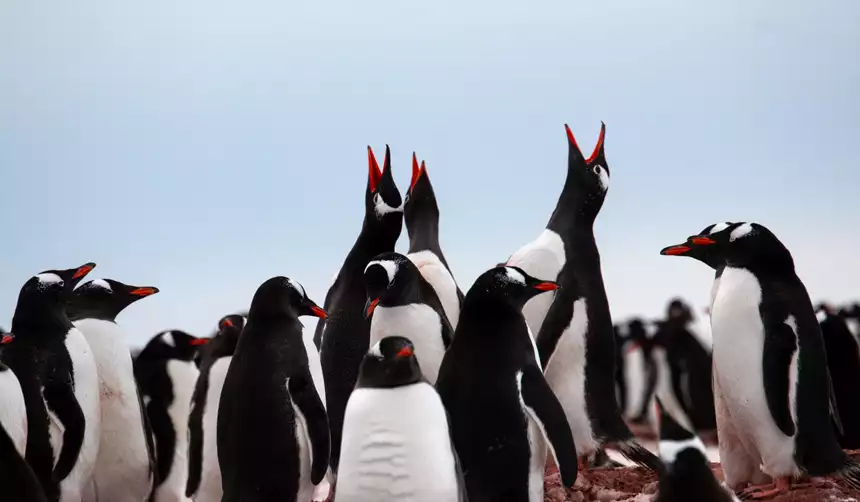
Best Time to See Whales in Antarctica
Whale watching is an exciting highlight of any visit to Antarctica. The best time to go whale watching and to see whales in Antarctica is February and March.
There are up to 8 whale species travelers might encounter in Antarctica. Humpback whales are the most commonly sighted whales, followed by smaller minke whales.
Migratory whales such as humpback whales, fin whales, blue whales and minke whales are begin arriving in Antarctica in November and December. Whales come to feed on abundant krill and small fish that explode as a result of long days and productive waters. Numbers increase and feeding pods form through January. By February and March feeding pods have formed making this the best time to see whales in Antarctica.
Orca whales don’t migrate and can be found in Antarctica year round. The best time to see Orca whales in Antarctica is in February and march when penguin chicks and seal pups are entering the water making an easy meal.
Whale watching is an incredible part of the Antarctic experience. Consider yourself lucky if you see whales on your trip.
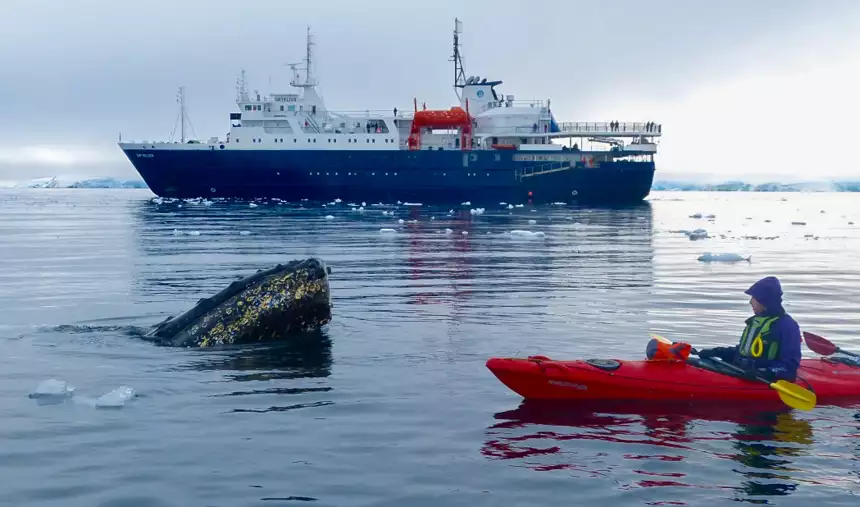
Latitude Matters When Choosing When to Visit Antarctica
Life at the south pole is affected greatly by latitude variances. Slight latitude shifts confer big changes in temperature, sunlight and seasonality. Combine this with the short Antarctic summer and you’ll see animals’ mating, laying and rearing cycles moving very fast!
The Antarctic Peninsula warms first at the northerly tip, and later in the south. This will affect penguins, wildlife and ice conditions. For instance, on our founder’s air cruise to Antarctica in December, he saw penguins mating and nest building; sitting on eggs; and newly hatched chicks all in different areas based on latitude north or south.
There are particularly significant differences for Falkland Islands and South Georgia cruise routes, as well as for routes that stretch into the eastern reaches of the Weddell Sea. Read more about the best time to visit for viewing South Georgia Island animals .
While this Antarctica by month guide is valuable resource for planning your own best time to visit Antarctica, note that wildlife and weather can never be fully predicted, especially in a land as dramatic as Antarctica.
Detailed Climate Tables
View our Antarctica climate page to see Antarctica average temperature by month and daylight hours in detailed locations like the Antarctic Peninsula, South Shetland Islands, South Georgia Island and Ushuaia. As most cruises focus on the Peninsula, here is our detailed table for that region:
Antarctic Peninsula Weather by Month
Antarctic Peninsula Average Temperature, Rainfall & Daylight
So, What Is the Best Month to Go to Antarctica?
Considering everything stated above, the best month to go to Antarctica is January. There is a reason January is the peak Antarctica season. The wildlife is active, the ice is spectacular, and the weather is hard to beat.
But not everyone can or should schedule their trip during this time since each month has its benefits. You really can’t go wrong choosing any time in Antarctica’s six-month cruising season. If you plan your trip during the peak season of mid-December through mid-February, then be sure to book early as these are the dates that sell out first.
Need more information on when to travel to Antarctica? Our timeline above aims to be a detailed guide for you to determine your own individual best month to go to Antarctica. Our experts are here to assist with even more detail. Contact us to learn more about planning an Antarctica cruise and the best time to visit Antarctica for your travel needs. We are here to help with one-on-on advice and ensure you have a great trip any time of year.

MAKE IT HAPPEN
Full-service booking from experts who’ve been there.
Keep researching your visit to Antarctica with our resources below. Or, simply have the latest about Antarctica delivered to your inbox by signing up for the AdventureSmith Explorations newsletter .
MORE ANTARCTICA RESOURCES : Antarctica Travel Guide Antarctica Cruises Luxury Antarctica Cruises Falkland Islands & South Georgia Cruises Cruises with Flights to Antarctica Antarctica Cruise Cost How to Get to Antarctica Things to Do in Antarctica Places in Antarctica Antarctica Ships Best Antarctica Cruise Lines Antarctica Cruise Deals Antarctica Cruise Reviews
Have a question or looking for advice about the best time to visit Antarctica? Use the comments below and we’ll answer your question and make this guide even better.
Comments will be moderated and will appear after they have been approved.
Cancel reply
Your email address will not be published. All fields are required.
Hi, if I would like to kayak, what is the best month to visit Antarctica, and what are the ships or itineraries I should consider?
Hi Wai Yee, Kayaking is available on most of our expeditions, at ANY time of the cruising season, but space can fill up fast for coveted spots. If you have your heart set on kayaking, it’s a good idea to book as soon as you can. Options range from short one-time paddles to full programs that let you kayak every day. We will have an Adventure Specialist be in touch to further hone in the best time to kayak in Antarctica & the best trips for doing so based on what’s available now or next season. Generalizations for timing kayaking would be to expect more ice and pristine landscapes if you kayak in early season (Nov-Dec) and to potentially get closer encounters with whales during kayak excursions later in the season (Feb-March).
Hey! How is end of March for a visit? 🙂
Hey Ashwini! March in Antarctica has its benefits. Whales are plentiful (humpbacks in peak numbers), sunsets/rises are long and vivid, and less snow allows for more landing sites and access to areas further south. By late March the cruise season is wrapping up as the temperatures drop. You can often find more Antarctica cruise deals and enjoy the feeling of having Antarctica to yourself. Here’s a list of Antarctica trips in March ; for detailed availability please contact an Adventure Specialist .
Best months to visit? We want to see the baby animals, plus we are going to tie it in with a trip to Machu Picchu.
Sue, Wow that sounds like quite a trip! These are two of our most popular destinations. Baby penguins are usually most prevalent in January while seal pups are most commonly seen in February, but it always depends where you go as timing can change by latitude. Talking to an Adventure Specialist can help you find the best timing and trip for you and will be reaching out to you shortly.
Find Your Best Time to Visit Antarctica
Start browsing our selection of trips to discover more about activities and itineraries. Let us be your guide to the best time to go to Antarctica and help choose your perfect expedition. Our team has traveled in every month of the season so have firsthand insight on each month. Get started finding your bucket list trip!
Contact Us - Best Time to Visit Antarctica
Travel is best planned one-on-one, and we’re here to help you with your specific needs.
- First Name *
- Last Name *
- Phone (required because some email replies get blocked) *
- Country of residence (required in order to comply with privacy laws) * United States of America - US Afghanistan - AF Aland Islands - AX Albania - AL Algeria - DZ American Samoa - AS Andorra - AD Angola - AO Anguilla - AI Antarctica - AQ Antigua and Barbuda - AG Argentina - AR Armenia - AM Aruba - AW Australia - AU Austria - AT Azerbaijan - AZ Bahamas - BS Bahrain - BH Bangladesh - BD Barbados - BB Belarus - BY Belgium - BE Belize - BZ Benin - BJ Bermuda - BM Bhutan - BT Bolivia - BO Bosnia and Herzegovina - BA Botswana - BW Bouvet Island - BV Brazil - BR British Virgin Islands - VG British Indian Ocean Territory - IO Brunei Darussalam - BN Bulgaria - BG Burkina Faso - BF Burundi - BI Cambodia - KH Cameroon - CM Canada - CA Cape Verde - CV Cayman Islands - KY Central African Republic - CF Chad - TD Chile - CL China - CN Hong Kong, SAR China - HK Macao, SAR China - MO Christmas Island - CX Cocos (Keeling) Islands - CC Colombia - CO Comoros - KM Congo (Brazzaville) - CG Congo, (Kinshasa) - CD Cook Islands - CK Costa Rica - CR Côte d'Ivoire - CI Croatia - HR Cuba - CU Cyprus - CY Czech Republic - CZ Denmark - DK Djibouti - DJ Dominica - DM Dominican Republic - DO Ecuador - EC Egypt - EG El Salvador - SV Equatorial Guinea - GQ Eritrea - ER Estonia - EE Ethiopia - ET Falkland Islands (Malvinas) - FK Faroe Islands - FO Fiji - FJ Finland - FI France - FR French Guiana - GF French Polynesia - PF French Southern Territories - TF Gabon - GA Gambia - GM Georgia - GE Germany - DE Ghana - GH Gibraltar - GI Greece - GR Greenland - GL Grenada - GD Guadeloupe - GP Guam - GU Guatemala - GT Guernsey - GG Guinea - GN Guinea-Bissau - GW Guyana - GY Haiti - HT Heard and Mcdonald Islands - HM Holy See (Vatican City State) - VA Honduras - HN Hungary - HU Iceland - IS India - IN Indonesia - ID Iran, Islamic Republic of - IR Iraq - IQ Ireland - IE Isle of Man - IM Israel - IL Italy - IT Jamaica - JM Japan - JP Jersey - JE Jordan - JO Kazakhstan - KZ Kenya - KE Kiribati - KI Korea (North) - KP Korea (South) - KR Kuwait - KW Kyrgyzstan - KG Lao PDR - LA Latvia - LV Lebanon - LB Lesotho - LS Liberia - LR Libya - LY Liechtenstein - LI Lithuania - LT Luxembourg - LU Macedonia, Republic of - MK Madagascar - MG Malawi - MW Malaysia - MY Maldives - MV Mali - ML Malta - MT Marshall Islands - MH Martinique - MQ Mauritania - MR Mauritius - MU Mayotte - YT Mexico - MX Micronesia, Federated States of - FM Moldova - MD Monaco - MC Mongolia - MN Montenegro - ME Montserrat - MS Morocco - MA Mozambique - MZ Myanmar - MM Namibia - NA Nauru - NR Nepal - NP Netherlands - NL Netherlands Antilles - AN New Caledonia - NC New Zealand - NZ Nicaragua - NI Niger - NE Nigeria - NG Niue - NU Norfolk Island - NF Northern Mariana Islands - MP Norway - NO Oman - OM Pakistan - PK Palau - PW Palestinian Territory - PS Panama - PA Papua New Guinea - PG Paraguay - PY Peru - PE Philippines - PH Pitcairn - PN Poland - PL Portugal - PT Puerto Rico - PR Qatar - QA Réunion - RE Romania - RO Russian Federation - RU Rwanda - RW Saint-Barthélemy - BL Saint Helena - SH Saint Kitts and Nevis - KN Saint Lucia - LC Saint-Martin (French part) - MF Saint Pierre and Miquelon - PM Saint Vincent and Grenadines - VC Samoa - WS San Marino - SM Sao Tome and Principe - ST Saudi Arabia - SA Senegal - SN Serbia - RS Seychelles - SC Sierra Leone - SL Singapore - SG Slovakia - SK Slovenia - SI Solomon Islands - SB Somalia - SO South Africa - ZA South Georgia and the South Sandwich Islands - GS South Sudan - SS Spain - ES Sri Lanka - LK Sudan - SD Suriname - SR Svalbard and Jan Mayen Islands - SJ Swaziland - SZ Sweden - SE Switzerland - CH Syrian Arab Republic (Syria) - SY Taiwan, Republic of China - TW Tajikistan - TJ Tanzania, United Republic of - TZ Thailand - TH Timor-Leste - TL Togo - TG Tokelau - TK Tonga - TO Trinidad and Tobago - TT Tunisia - TN Turkey - TR Turkmenistan - TM Turks and Caicos Islands - TC Tuvalu - TV Uganda - UG Ukraine - UA United Arab Emirates - AE United Kingdom - GB United States of America - US US Minor Outlying Islands - UM Uruguay - UY Uzbekistan - UZ Vanuatu - VU Venezuela (Bolivarian Republic) - VE Viet Nam - VN Virgin Islands, US - VI Wallis and Futuna Islands - WF Western Sahara - EH Yemen - YE Zambia - ZM Zimbabwe - ZW
- Newsletter Subscribe to our email newsletter
- By submitting this form, you consent to our privacy policy .
- Hidden IP Location
Talk to an AdventureSmith Travel Specialist Call us toll free at 1-877-620-2875 . Call us direct at 530-583-1775 .
Office Hours Monday through Friday, 8am-5pm Pacific Time.
Address 40169 Truckee Airport Road, Suite 201 Truckee, CA 96161
These are the best times to visit Antarctica

Dreaming of a cruise around the Antarctic Peninsula to spot leopard seals or to watch young penguins chase each other playfully around a rookery? Hoping to plunge into below-freezing Antarctic waters or see glaciers calve from the vantage point of a kayak? You'll need to find the best time to visit Antarctica to get the once-in-a-lifetime experience you crave.
Depending on what you want to do or see during your trip to Antarctica, you might favor an expedition earlier in the season or near the end. Certain months are better for camping and hiking on the continent, or for photographing whales and penguins. Some months confer longer days and warmer weather, while others may improve your chances of seeing the aurora australis, more commonly known as the southern lights.
For more TPG news delivered each morning to your inbox, sign up for our daily newsletter .
No matter your preference, you will certainly visit the White Continent during the austral summer. When the northern hemisphere is descending deeper into darkness, Antarctica is experiencing nearly 24 hours of sunlight — which means expeditions typically take place between late November and early to mid-March.
Here are the best times to visit Antarctica for the activities likely to be on your bucket list.
The best times to see wildlife
The best time to visit Antarctica to see wildlife depends on the animals you most want to see, and whether you have your heart set on photographing adorable baby penguins or whales breaching.
Travelers who visit Antarctica early in the season, typically in November, will likely see penguins nesting and protecting eggs. Fresh snowfall at this time can make for incredible photos — and wintry landscapes.
By December, visitors are more likely to see penguin hatchlings. I traveled to Antarctica in mid-December and missed the hatchlings by a week. My colleague, Gene Sloan, visited just 10 days later and saw many baby chicks during several landings.
The sweet spot for seeing chicks that are still small and fuzzy is late December through early January. As the season progresses, you'll find baby penguins turning into adolescents. When Sloan went back to Antarctica in early February, he found the same chicks he had seen as tiny balls of fluff had grown nearly as big as their parents.
Related: Is this the ultimate Antarctica cruise ship?
If whale watching is at the top of your list, visit Antarctica later in the season, in February or March, as that's the best time for cetacean spotting. This is when whales are more easily seen gathering together in large groups before migrating north. But even during my trip in December, we saw many humpback whales — and orcas were spotted in spades the following week.
Humpback whales, orcas and minke whales are all frequently spotted in Antarctic waters, though you might have luck catching a glimpse of more rare whale species too, such as sperm, fin and blue whales.
The best weather in Antarctica
Antarctica is the most extreme continent on the planet: It can be incredibly cold, dry and windy. In the leather folio I received for my December sailing with Atlas Ocean Voyages , I was told that temperatures during the Antarctic summer "usually reach between 30 and 40 degrees Fahrenheit," though this can vary depending on the specific month of your trip.
If you have an opportunity to land and walk on fast ice, as Gene did with Silversea Cruises during a late December trip, you'll want to aim for a trip early on in the season, as the fast ice melts away throughout the summer. It's possible to do this later in the season, but you'll need to venture much farther south, where it's colder.
January is the warmest month of the year in Antarctica, and good weather means better odds of kayaking and paddling around the Antarctic Peninsula and surrounding islands.
Likewise, snow can make landings more challenging and can make it harder or impossible to hike and camp on land. So, in addition to being colder and wetter, easy-season travel can have other complications.
The late summer months (February and March) can also make it possible to venture farther south, to parts of the region that are typically inaccessible, since more ice has melted.
The best times to visit Antarctica for photography
Antarctica is stunning no matter what time of year you decide to visit. But depending on the type of landscapes and wildlife you want to photograph, you might want to hone in on an early, mid- or late-summer trip.
Visit in late December during the summer solstice to capture the phenomenon of the midnight sun — and take full advantage of long days when you can squeeze in as much photography time as possible.
Related: The ultimate packing list for an Antarctica trip
If what you're after is an actual sunset or sunrise photo behind a backdrop of ice and mountains, you'll have more luck on the early and late ends of the season, when there's a more marked difference between day and night.
Or, aim to see the southern lights by visiting as late in the season as possible (March) when the days start getting shorter and you might get lucky on a particularly clear night.
Wildlife photographers should target the middle of the season, when there's a flurry of activity from penguins, whales, seals and other incredible animals.
Bottom line
The window for travel to Antarctica is relatively short, due to the continent's extreme and inhospitable weather. Even travelers on land-based excursions to Antarctica, such as the luxury eco camps by White Desert , will find the calendar of available dates is limited to travel between late November and early February.
To visit Antarctica at the time you think is best, book at least a year in advance.
Whether you're going to book an express flight to the continent or opt instead for a traditional sailing across the Drake Passage (one of the most violent bodies of water in the world no matter what time of year you plan to visit), you will love Antarctica in any season. Since this is often a once-in-a-lifetime destination, think carefully about the sights you want to see or the experiences you would love to have, then choose a trip in the right month to make your bucket-list dreams come true.
Planning a trip to Antarctica? Start with these stories:
- Dreaming of Antarctica: How to book the trip of a lifetime
- 7 tips for visiting Antarctica before it's too late
- 6 ways to travel to Antarctica in style and luxury
- 11 great expedition cruise vessels that will take you to Antarctica
- These 8 books are must reads before any Antarctica trip
- I just spent to night in an igloo in Antarctica — here's how you can, too
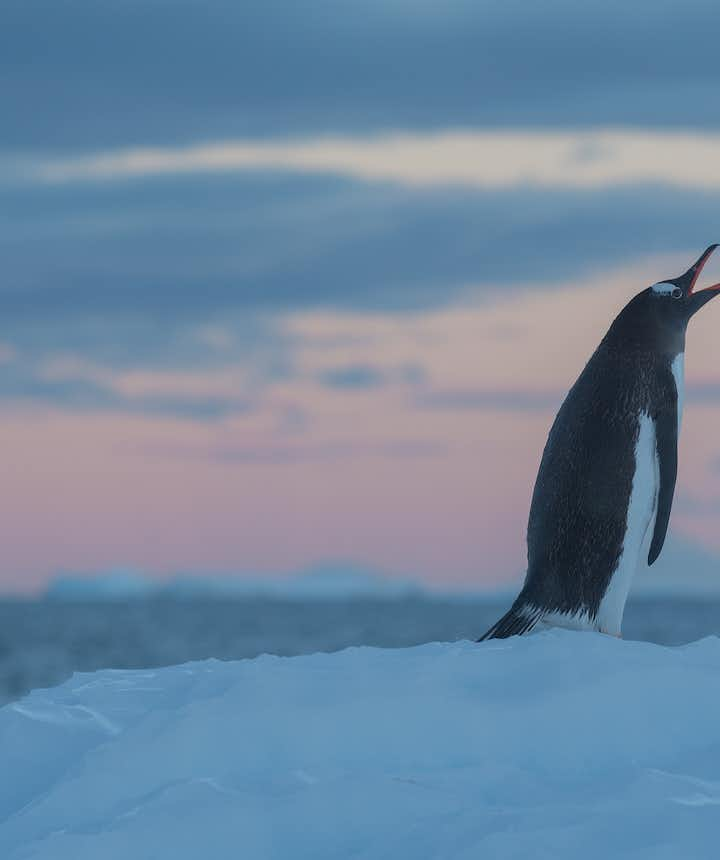
The Ultimate Guide to Photographing Penguins in Antarctica

- What to Bring for Photographing Penguins in the Antarctic
Rules and Techniques for Photographing Penguins in the Antarctic
- How to Photograph Different Penguins in the Antarctic
- Photographing Emperor Penguins
- Photographing Adelie Penguins
Photographing Chinstrap Penguins
Photographing macaroni penguins.
- Photographing Gentoo Penguins
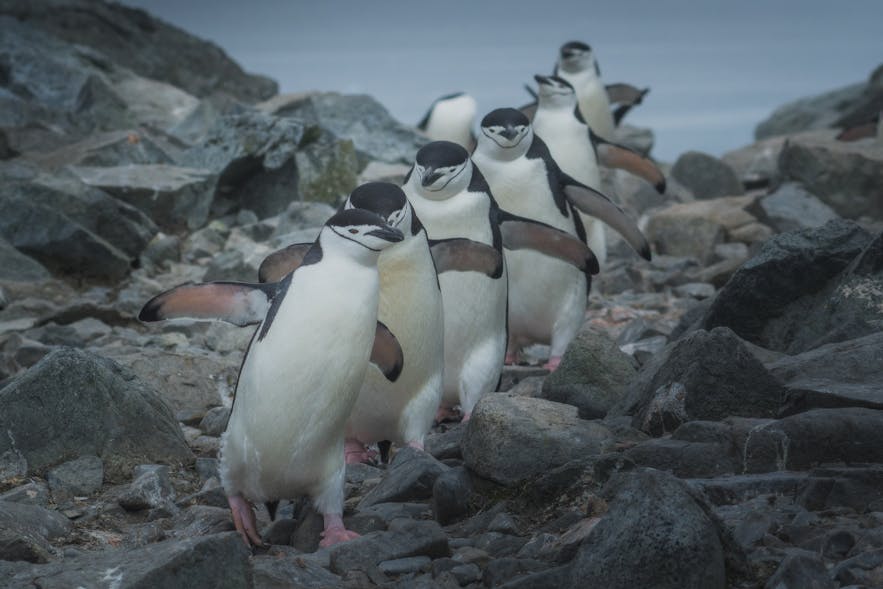
What is the best way to photograph penguins in Antarctica? What species of penguin live in Antarctica, and how are they different? Are there any tips, tricks and rules you need to know before setting out to catch them on camera? Continue reading for the ultimate guide to photographing penguins in Antarctica.
- See these 25 Useful Tips to Quickly Improve Your Landscape Photography
See our popular Antarctica Photography Tours & Workshops
Antarctica fly/sail photography expedition 20 february to 3 march 2025, falklands & south georgia - antarctica photography tour.
Every quality that penguins possess makes them photogenic; they are one of the most pleasurable and rewarding subjects to shoot in the animal kingdom. Their awkward, bumbling walk is endearing, their belly slides are adorable, their social interactions are heartwarming, and their emotive expressions are somewhat person-like.
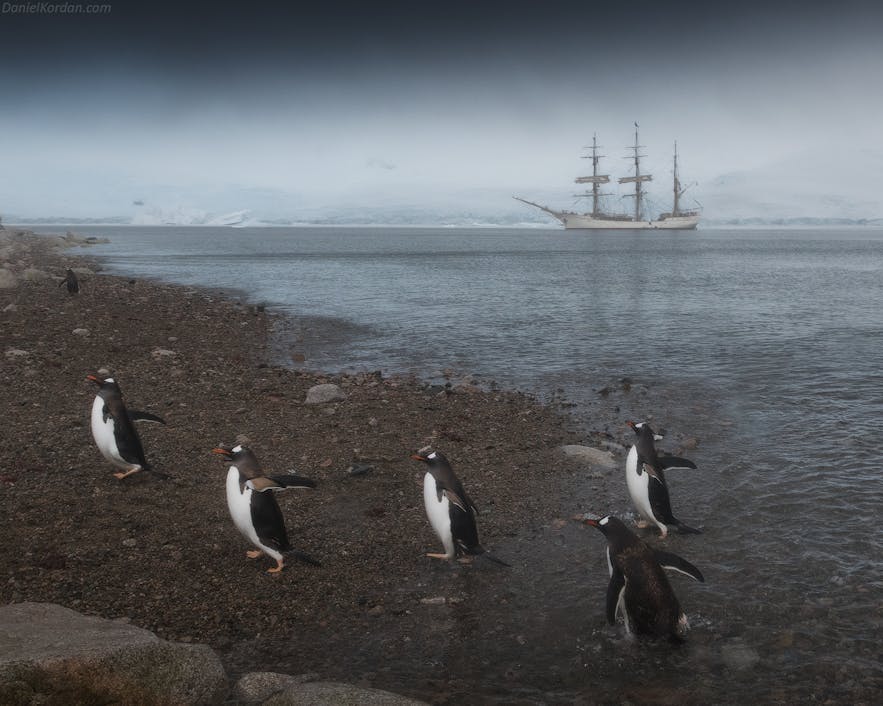
It is little wonder why they are regularly giving the starring roles in animated movies and documentaries, and why their cute behaviour often makes international news. The media stardom of penguins has brought environmental threats to the Antarctic to the world’s attention, refreshed a passion of wildlife programmes, and encouraged thousands to plan a trip to the world’s southernmost continent to witness and photograph them in their natural habitat.
While it is possible to book cruises and other trips that will give you the potential to see penguins in Antarctica, taking an Antarctic photo workshop is a far more immersive option and the closest you can get to a guarantee of multiple shoots of penguins.
For example, this twelve-day adventure, available in 2020 and 2021 , will take you from the southern tip of South America to the southernmost continent on a modern, comfortable, specialised ship called the Gregg Mortimer. This ship has an art room for processing photos and the tour led by world-renowned, award-winning photographer Daniel Kordan , who will provide seminars and lessons on improving your skills and be on hand every shoot to help you get the perfect images.
- Check out this Interview with Daniel Kordan
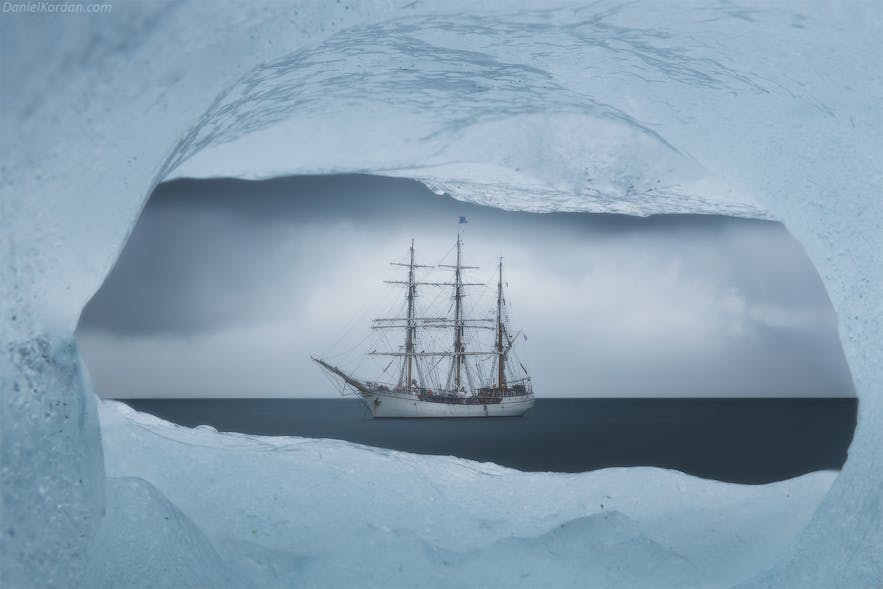
Not only this, but you’ll be joined by an expedition team who are experts on Antarctica's landscapes, the patterns of its wildlife, and how to safely navigate the terrain and interact with the animals. To make this workshop even more convenient, everything is arranged for you before your arrival, such as your hotels, meals and transfers, taking all the stress out of booking your adventure.
To photograph the penguins, you will visit the continent itself as well as some Antarctic and sub-Antarctic islands, by making day-trips on a zodiac. Because of the axis of the Earth in December and January, when this workshop takes place, the sun never sets in Antarctica, providing you with endlessly bright conditions and extended hours in which you can shoot.
The joy of photography tours such as these is that while you will have countless opportunities to photograph penguins exhibiting different behaviours in different environments, you will also be able to capture the other wonders of the Antarctic. This includes its spectacular land-, sea- and ice-scapes, as well as its other animals, such as its spectacular whales, its dramatic Elephant Seals and its diverse seabirds.
- Check out this Ultimate Guide to Wildlife Photography in Antarctica

What to Bring for Photographing Penguins in the Antarctic
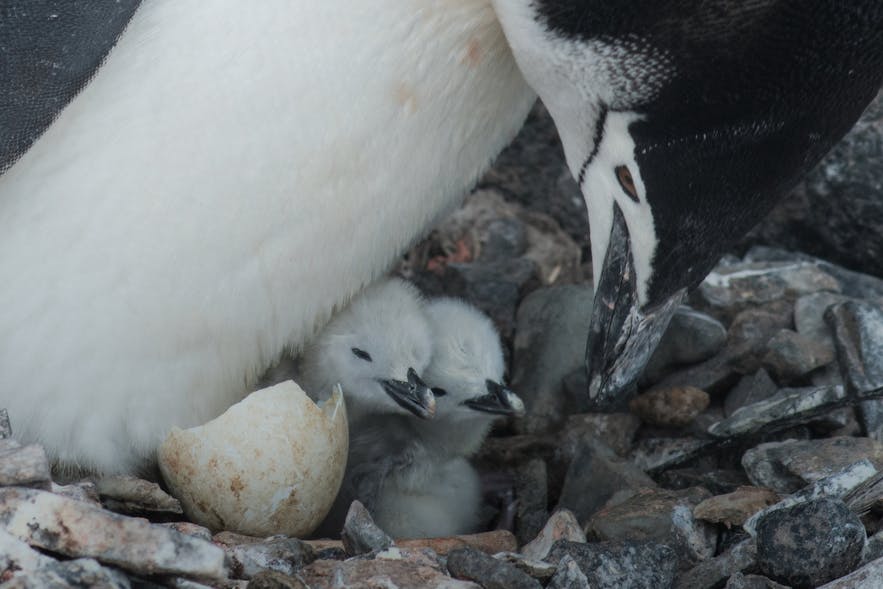
Travellers to the Antarctic should, of course, prioritise bringing waterproof, windproof and very warm clothing to protect them from the elements; photographers, however, need to consider a host of other equipment. What lenses will be needed to capture the penguins? What accessories should be brought? What can help protect a camera from malfunctioning in the cold?
Largely, those interested in capturing spectacular images of Antarctica’s animals should bring similar equipment that they would on any wildlife shoot. A telephoto lens is nearly essential, allowing you to get intimate shots of penguins and other creatures without disturbing them; if it has a stabilising function, then all the better. This is particularly useful for shooting images of nests and chicks, which you will want to keep your distance from.
Considering penguin colonies are often vast, a wide-angle lens can help reveal how they become part of Antarctica’s stunning landscapes. Fish-eye lenses, meanwhile, can reveal the scale of a colony in a way that makes those looking at the photo feel like a part of it.
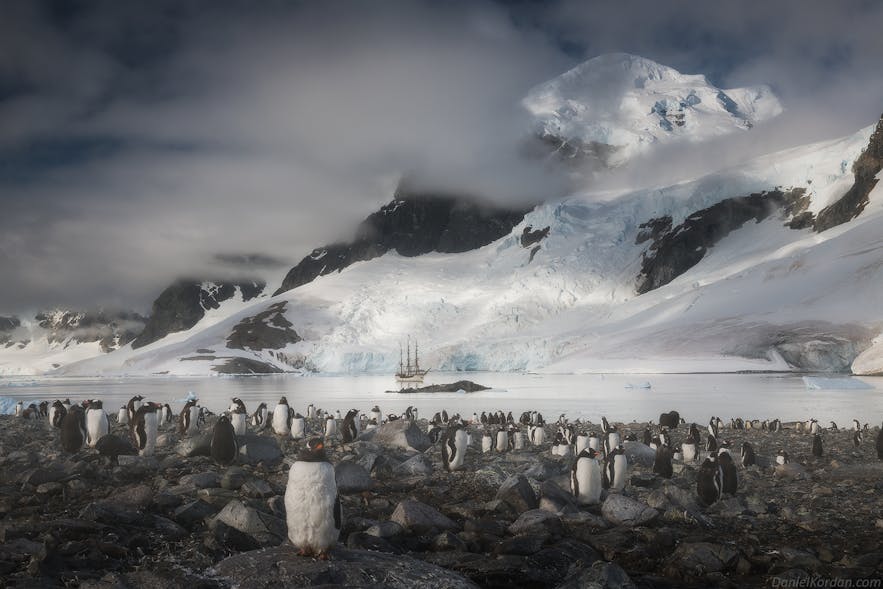
In terms of accessories, extra batteries are vital; the cold drains their life incredibly quickly. External battery packs can be used as well if kept in a warm pocket. Tripods are optional; while they will help you frame your picture and ensure the stability of your camera while zooming, they can be cumbersome in Antarctic conditions. Any flash equipment is unnecessary, due to the light of the midnight sun, and unwanted, as it could disturb the animals.
When booking a trip such as the photo workshop mentioned, you’ll be provided with a list of all equipment you will need, as well as some suggestions for accessories and lenses that will add to your experience shooting penguins in Antarctica.
- Check out these Bright Ideas for Shooting in Daylight
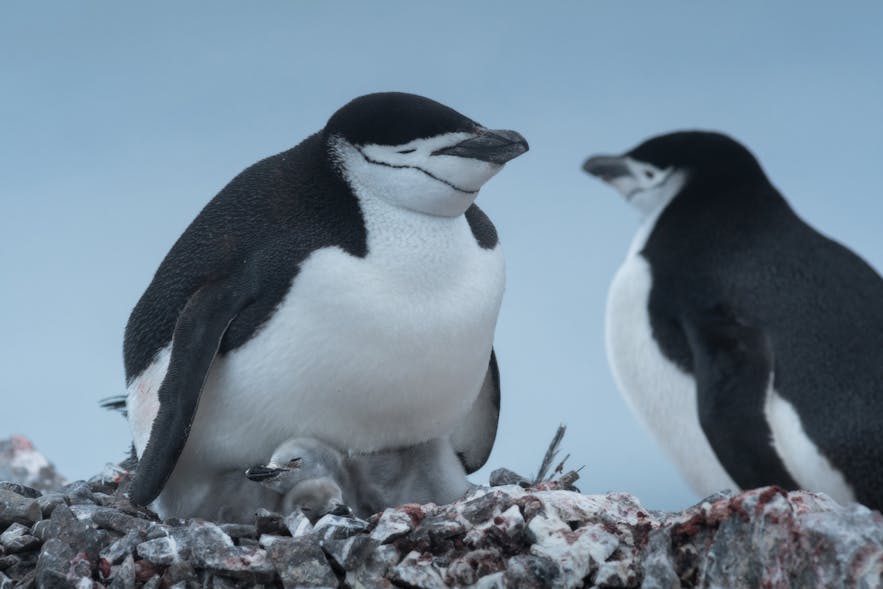
The penguins of the Antarctic continent have evolved far from humankind, and their historical interactions with us have been extremely limited, only really beginning in the last century. As such, they have not learnt to fear us as predators like the vast majority of the rest of the animal kingdom has.
This placid nature makes photographing penguins in the Antarctic a delight, and will often provide even novices with some excellent additions to their portfolios. You can get relatively close without causing them to change their natural behaviours, allowing you to take candid pictures of them interacting with their chicks, scuffling for territory, or tossing their heads back and squawking to their peers.
In spite of their affable nature, there are, of course, precautions you must take when photographing penguins. Regulations dictate that you must not come within five metres of an individual for the following reasons.
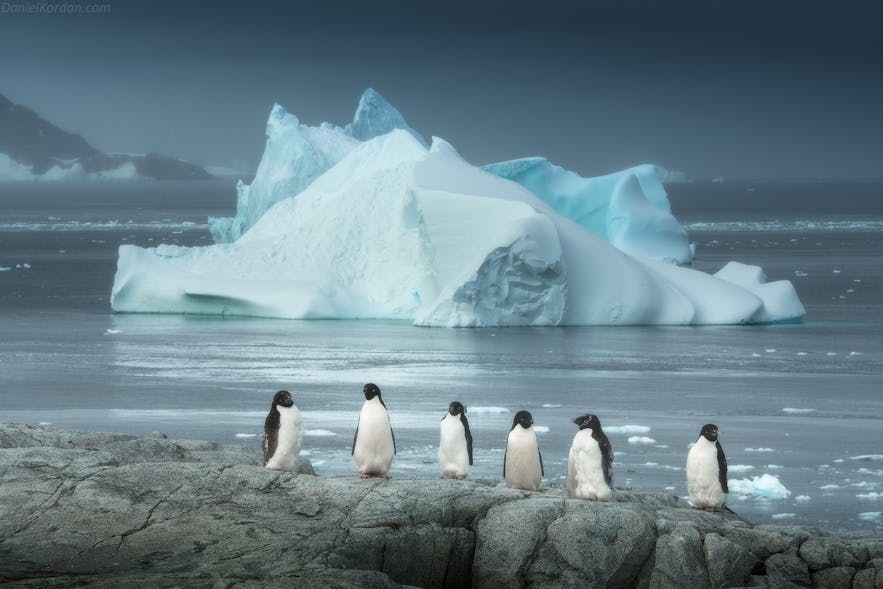
Firstly, most penguins in Antarctica in summer will either be raising eggs and chicks. You mustn't get anywhere near the nests, in case you should inadvertently step on one. This is a very real threat considering that you may have your eyes glued to your viewfinder. Your presence near a nest may also discourage parents from coming back to it in good time, which could lead to a chick starving or freezing.
Some penguins may even become aggressive if they feel like you are disturbing their chicks. Though they won’t do much damage through your thick clothing, it will still cause them to spend energy that could be better-used feeding or protecting their nests from real dangers such as seabirds. In the extreme conditions of the Antarctic, this could be the balance between life and death.
Secondly, they are likely to become at least agitated if you are nearby and they perceive you to be displaying threatening behaviour, such as making loud noises or making sudden movements. This is particularly the case considering many penguins are very near-sighted on land; as are social animals, if one becomes surprised and has a panicked reaction, it could set off a similar reaction throughout the colony.
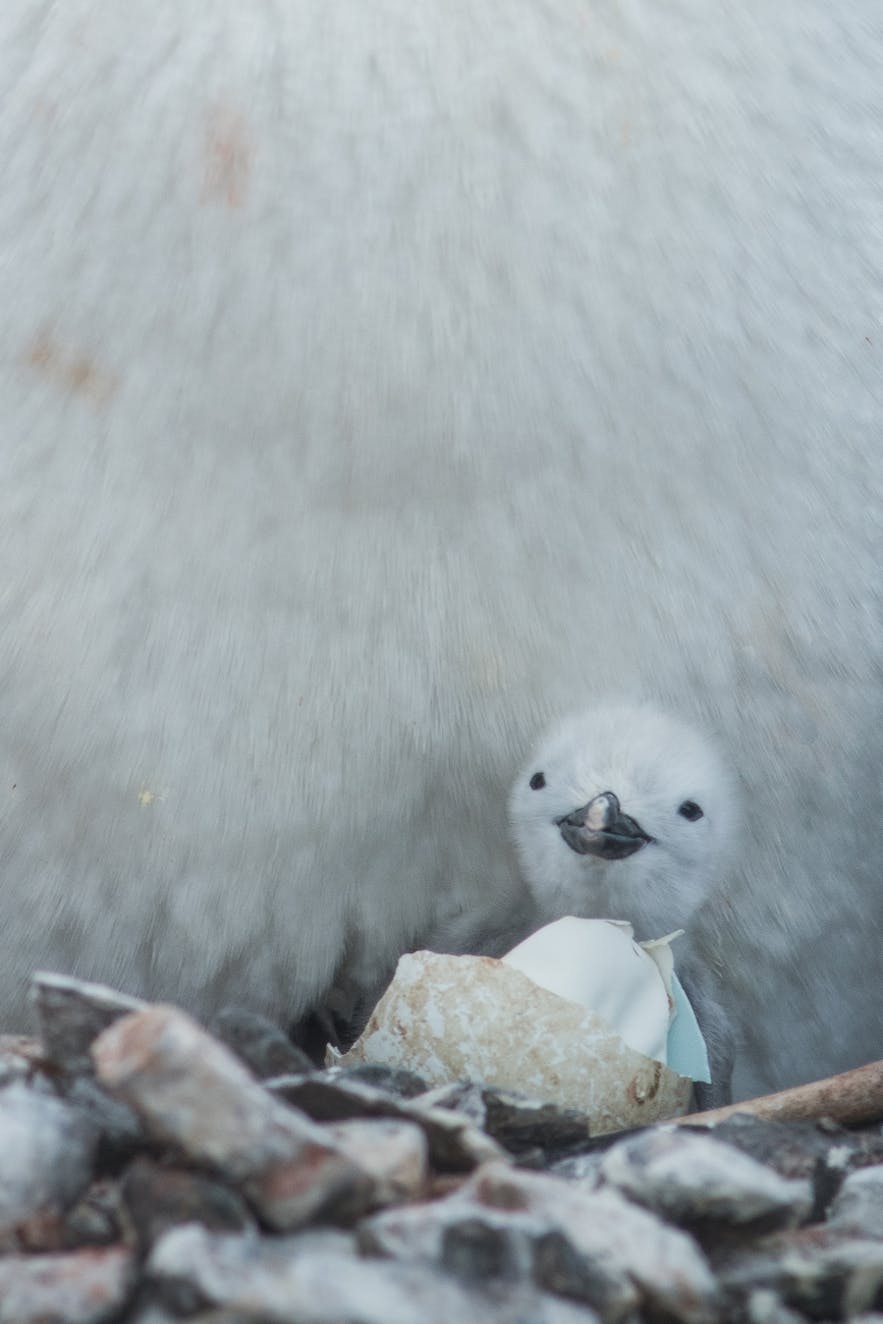
Such a panic could lead to birds abandoning their nests, fleeing to the water without taking precautions to avoid predators such as Leopard Seals, and may even discourage them from returning to the colony.
It should be noted that this five-metre rule is extended if the penguins move away from you; pursuing them would be a breach of regulation and an obvious encroachment on the animals in their natural environment.
The rule, however, only applies to you; if a penguin chooses to come closer, you do not have to move back. Many, particularly chicks, might be very curious of you and your camera equipment, allowing you to get some beautiful close-up shots and make fantastic memories that will last a lifetime.
It is important, however, not to touch the birds; their feathers contain oils essential for protection against the cold which you don’t want to displace.
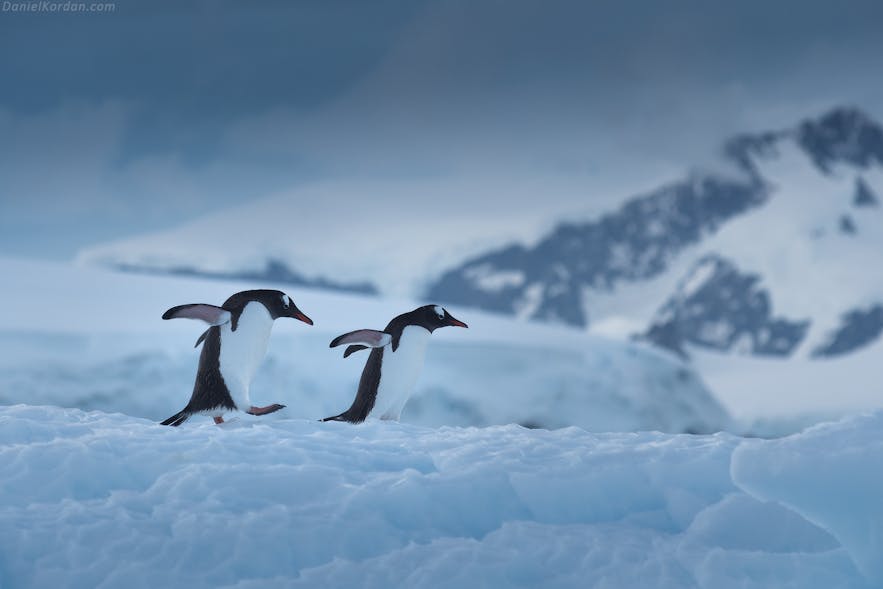
When photographing penguins, it is best to get low; not only does this make you seem less threatening, but provides a better angle for shooting them. It will also stabilise your camera if you chose not to bring a tripod, helping you focus when using a telephoto lens. It is also essential to be patient; some penguins may take a little while to get used to your presence.
It is possible to photograph penguins from the water, either from the shore or in a zodiac. Penguins do exhibit some interesting surface behaviour, such as breaching from water to land, or ‘porpoising’ to build up speed. However, they are only ever in the air momentarily, requiring a skilled photographer to snap them, making them much more difficult subjects. When bobbing on the surface of the water, they are also a challenge to shoot due to their black feathers blending in with the surrounding seas
If you are very sensitive to smell, then it’s recommended to bring something you can pinch your nose closed with when attending a colony; penguin guano reeks. Similarly, those sensitive to sound may wish to bring some earplugs, as the birds can be incredibly noisy.
- Check out the Complete Guide to Photographing Puffins in Iceland
How to Photograph Different Penguins in the Antarctic
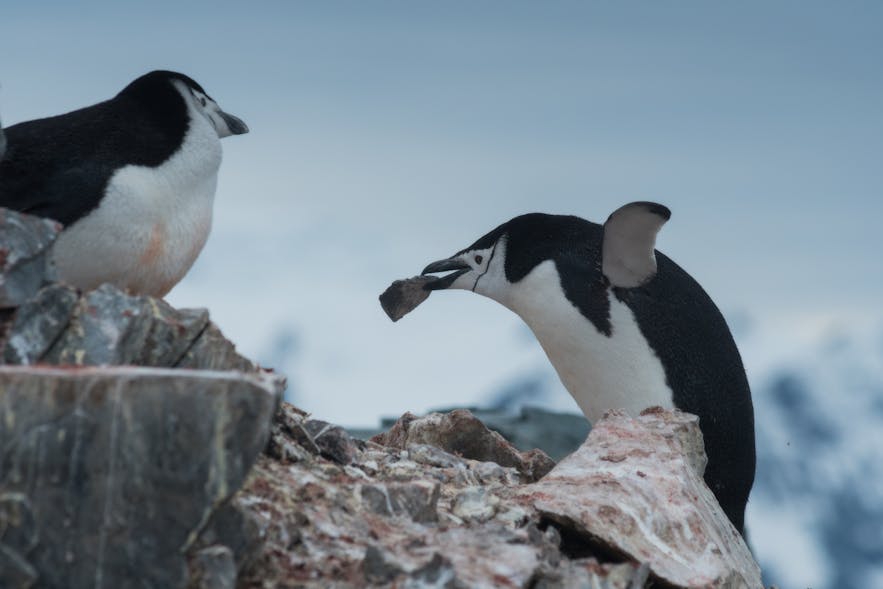
Eight species of penguin can be found in Antarctic and sub-Antarctic waters and landmasses:
The Emperor Penguin
The Adélie Penguin
The Chinstrap Penguin
The Macaroni Penguin
The Gentoo Penguin
The Southern Rockhopper Penguin
The Magellanic Penguin
The first five of these species live on the continent itself (the first two being endemic to it), and specific techniques on photographing each of them are discussed below.
- See also: The Ultimate Guide to Animals in Antarctica
Photographing Emperor Penguins
Emperor Penguins are the unquestionable stars of the Antarctic, the largest species of penguin at over a metre tall. Their person-like stature and expressions, deep parental bonds, and amazing ability to survive exclusively on the world’s most unforgiving continent have provided them with worldwide recognition and the featuring roles in countless documentaries.
Many people coming to the Antarctic with the ambition of adding some spectacular images to their portfolio do so largely because of these beautiful birds.
Upon arrival, few are not disappointed; Emperor Penguins make for magnificent subjects. Though more statuesque and beautiful than others of their kind, they retain the bumbling, clumsy nature that makes all penguins so endearing. Emperor Penguins are usually rather indifferent to the presence of people, and because of their size, the five-metre-rule does not impede shooting them.
Emperor Penguins are unique on this list as they are the only species that lay their eggs and rear their chicks over winter. You will not, therefore, be capturing interactions between parents and their offspring, but photographing adult birds preparing to summer out at sea and juveniles building up to their first departure from the colony.
Please note that if coming in later January, many Emperor Penguins will have already left.
Getting on your knees will put you at eye level with these creatures, allowing you to use your telephoto lens to take photos from the perspective of an Emperor Penguin; an even lower angle can be used to emphasise their height. Because Emperor Penguins gather in groups of hundreds of individuals, ensure you also bring a wide-angle lens to capture the scales of the colony in respect to the dramatic surrounding landscapes.
Photographing Adelie Penguins
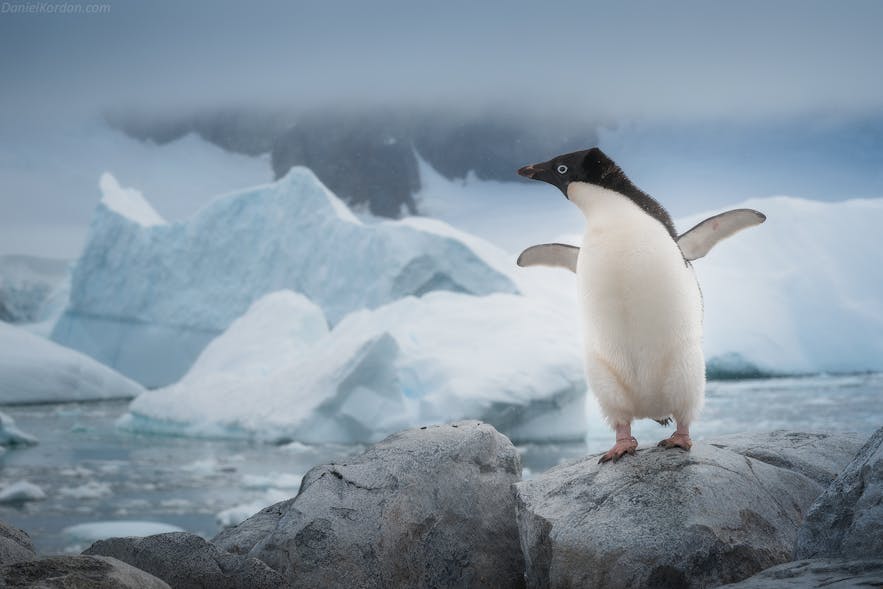
A kind person may describe Adélie Penguins as brave and curious; a bleaker person might simply describe them as stupid. Regardless, this species of penguin is remarkable for its fearlessness in the face of people and its eagerness to make new friends.
Several stories from early explorers note the bizarre behaviour of this bird, focusing on how they interacted with the dogs that accompanied them. Seeing the penguins, the dogs barked and pulled at their chains, clearly eager to chase down such easy prey. Rather than fleeing from this aggression, the Adélie Penguins found it most fascinating and hurried over to the dogs as quickly as they could to see what the fuss was about. In one case, a man had to carry a penguin away, which showed its displeasure by squawking, pecking his legs and trying to get back to the dogs.
As such, Adélie Penguins can be a challenge to capture in a way that is likely to be new to most wildlife photographers; rather than having to wait for them to get into the frame, you’re more than likely to have to wait for them to get out of it. You and your camera equipment may very well stimulate the birds to come investigating.
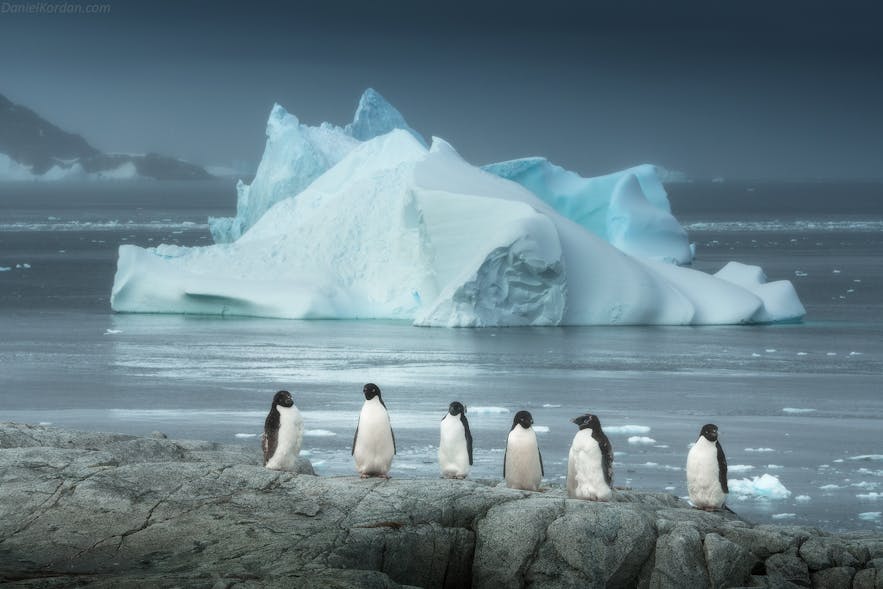
Adélie Penguins don’t mean any harm, and so long as you treat them gently, you are unlikely to do any harm back. If they approach you, it would be wise to put your expensive equipment out of their reach, enjoy the experience, and wait for them to lose interest before resuming your photography. Of course, if you forgot your telephoto lens, this is a fantastic opportunity to get an intimate picture.
As your photography trip will occur during the breeding season of the Adélie Penguin, they may be less curious in you and more interested in looking after their young. Regardless, photographing a breeding colony of Adélie Penguins is an incredibly special opportunity considering the numbers that they gather in. Many colonies have half a million mating couples, and in 2018, an unfathomable one-and-a-half million pairs were present on the Danger Islands.
If you can catch Adélie Penguins leaping from the water onto the shore, as they routinely do to heights of up to three metres, it will make a spectacular action shot. Though difficult to time, a high shutter speed and burst function will help enormously. Due to the midnight sun, you don’t need to worry about not having enough light exposure between frames.
- See also: What is Aperture? An Introduction to Aperture in Photography
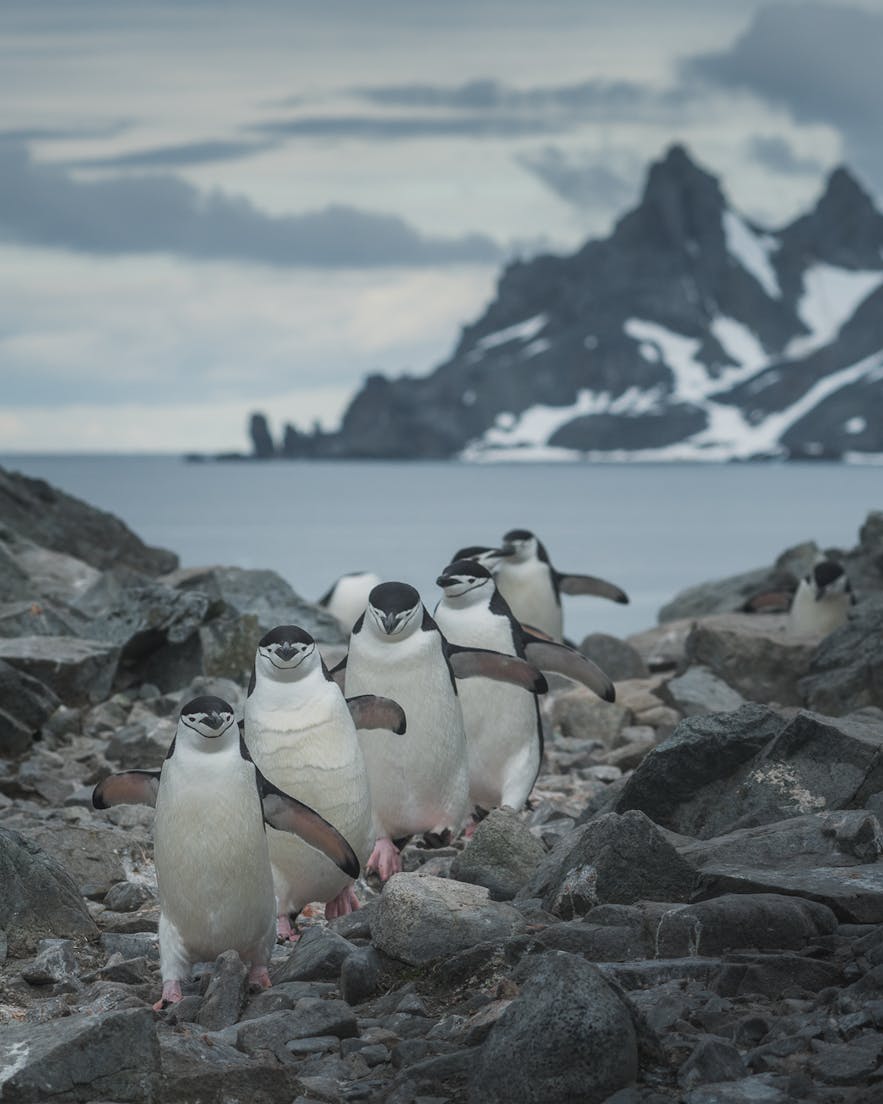
Adélie Penguins define themselves from their more indifferent cousins by being curious to a fault, but Chinstraps claim their uniqueness by being noticeably more aggressive. As likely as the former is to waddle over you for a nose into your camera bag, these birds may arbitrarily decide to stomp over mid-shoot and give you a pinch on the shin.
At around 70 centimetres tall and less than seven kilograms, Chinstrap Penguins don’t quite meet the definition of menacing, but if they get their beak or claws against your skin, it won’t be the most pleasant experience. The best way to avoid the fury of this angry little avians is to simply follow the guidelines above. Keep your distance, avoid their young, and move back if they are showing signs of discomfort. Failing this, try not to fear; you will survive the attack.
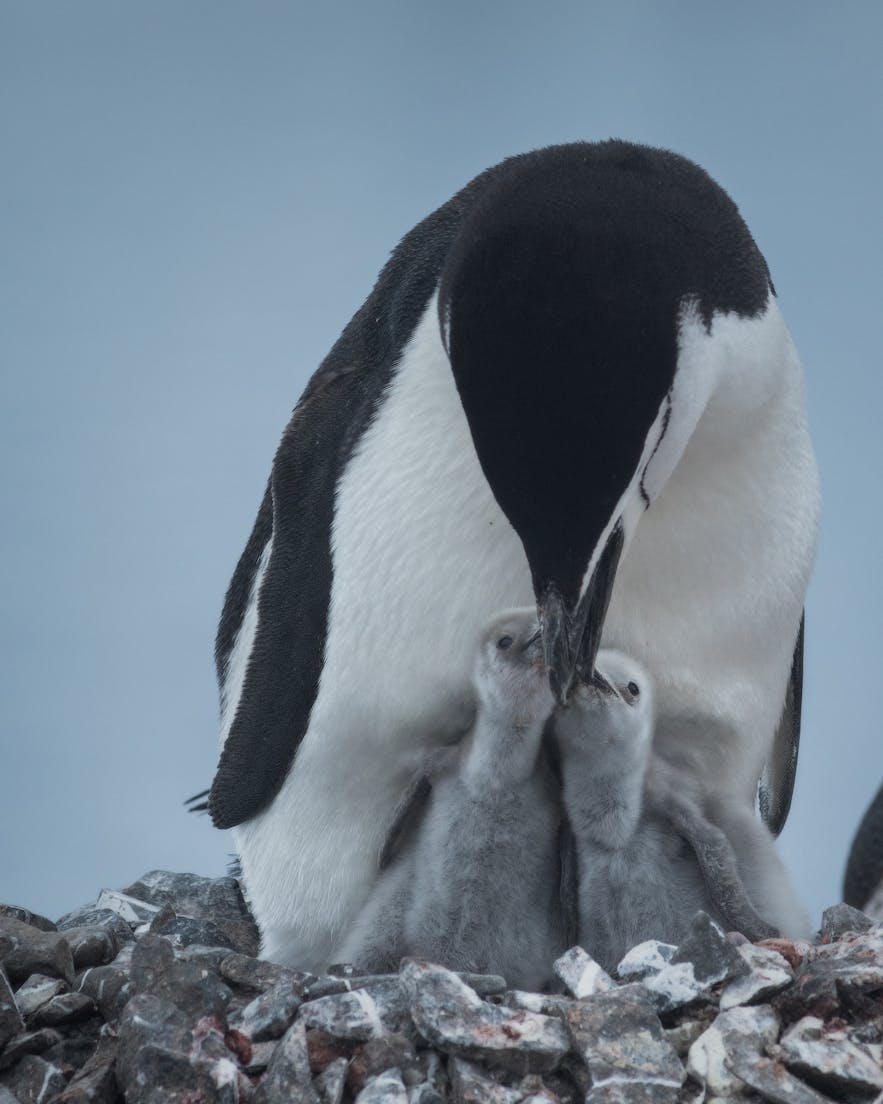
Because of their confrontational nature, however, Chinstraps make for great subjects. It is not uncommon to see them squabbling on the beach, allowing you to get shots that reveal this unique trait and the behaviour it leads to. These fights can occur with different types of penguins, allowing you to bring an interspecies dynamic into your frame.
They are also unusual in their appearance, with a black stripe under their face making it appear like they are wearing a helmet, giving close-up shots with your telephoto lens some extra character.
Macaroni Penguins are also excellent subjects due to their appearance. As crested penguins, they have yellow feather tufts on their forehead that give the illusion of bushy eyebrows, which add even more personhood to this bipedal, sociable little character. This feature explains how they got their name; Macaroni was used in the 18th Century for fancy men who wore extravagant hats. Their tuxedo-like colouration and their swaggering walk further explain this comparison.
In terms of how their appearance impacts your photography, Macaronis are also larger than most other crested penguins such as Rockhoppers, making it easier to catch the details of their faces and expressions. This is especially the case considering that they are not only unafraid of people but notoriously short-sighted on land, allowing you to stand five metres without them even knowing.
Like Adélie Penguins, Macaronis gather in vast groups, though these tend to number in the tens of thousands, rather than the hundreds of thousands. Even so, they nest densely together in their colonies, allowing you to take landscape shots where it almost seems that the terrain is carpeted by endless nesting birds.
Macaronis are also some of the best penguins to photograph in the water, particularly from a zodiac, due to their yellow crests making them instantly identifiable and their ability to breach clear of the water when travelling at high speeds.
Photographing Gentoo Penguins

The world’s third-largest penguin is the Gentoo. Gentoos make for wonderful subjects to their abundance, placidity and colouration. Their height and the white patches on this bird’s head make them easily identifiable, with the latter often being compared to a bonnet or turban. They also have long tails, unlike other species, adding to their uniqueness.
Unlike most other penguins, Gentoos form their colonies in a range of different areas; some prefer the snowy inland of Antarctica, others prefer rocky spaces where their eggs are better protected, while others remain in coastal regions. This allows you to capture them against a range of different backdrops utilising an array of different techniques, providing your portfolio with more diversity and stories of how penguins survive on this continent.
Gentoo Penguins during the summer are usually photographed in their lifelong breeding pairs. While many penguin species, contrary to popular belief, do not mate for life, Gentoos are one of the few that do. Images of their interactions and the interactions they have with their chicks are thus imbibed with a more human, emotive message than those of more fickle animal species. They provide a depth of character than many wildlife photographers strive to achieve in their photos.
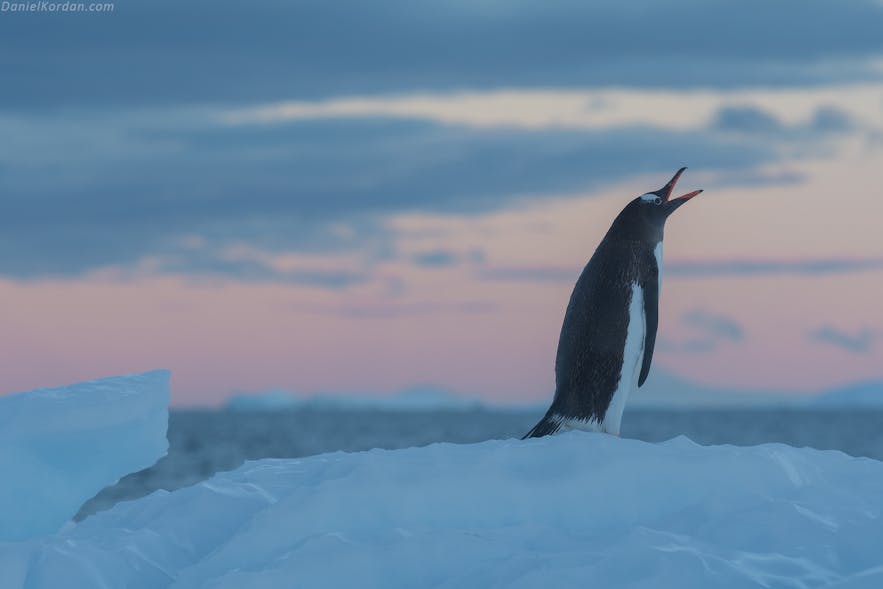
Gentoo Penguins can also be seen displaying some aggressive behaviours, providing a different angle to your documentation of them. Gentoo nests are surrounded by stones that are given to the females during courtship and are prized possessions. Female penguins will thus get aggressive if she feels another is eyeing up or getting too close to her stones, resulting in displays of strength and even physical struggles.
Gentoos will even force individuals out of their colony if they practice infidelity; capturing an animal being turned on by hundreds of its fellows would make for a dramatic image. Although such events are rarely seen, one of the wonders of wildlife photography in the Antarctic is that you never know what fascinating animal behaviours will unfold before you next.
See our popular Patagonia Photography Tours & Workshops
Capture the behaviour of penguins as they frolic in their natural habitat in Antarctica! Join one of our Antarctica photography workshops for the experience of a lifetime.
Popular articles
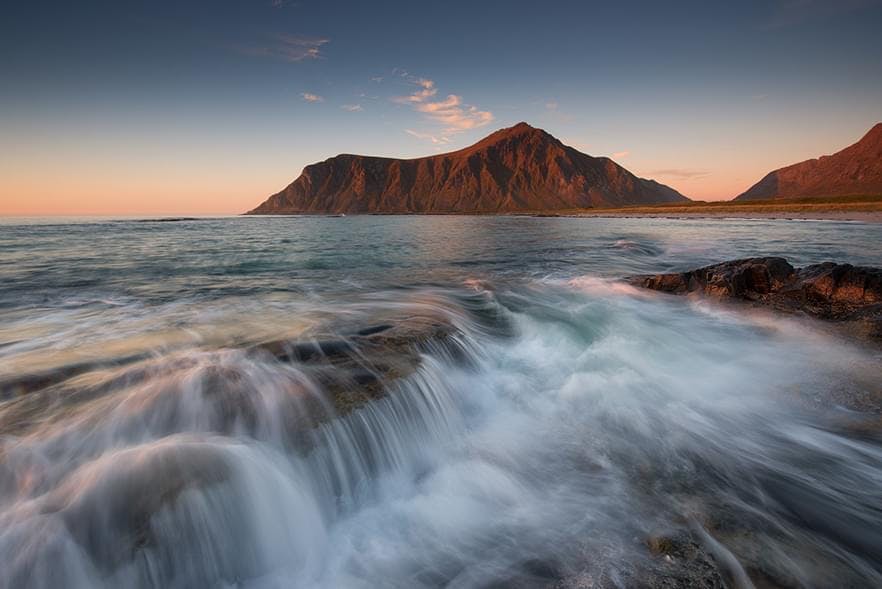
Landscape Photography in the Lofoten Islands of Norway
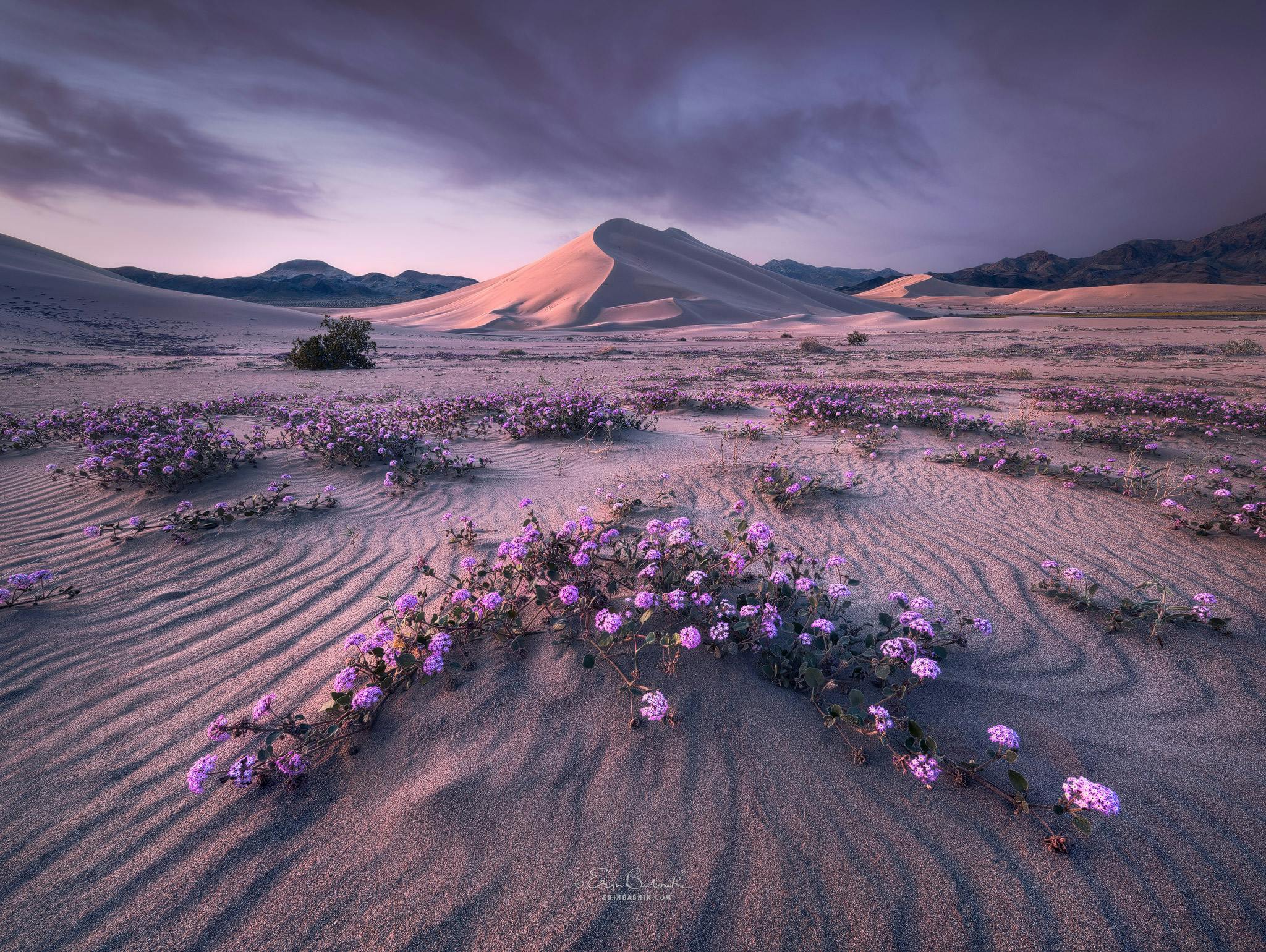
Interview with Erin Babnik

The Best Places to Photograph Puffins in Iceland
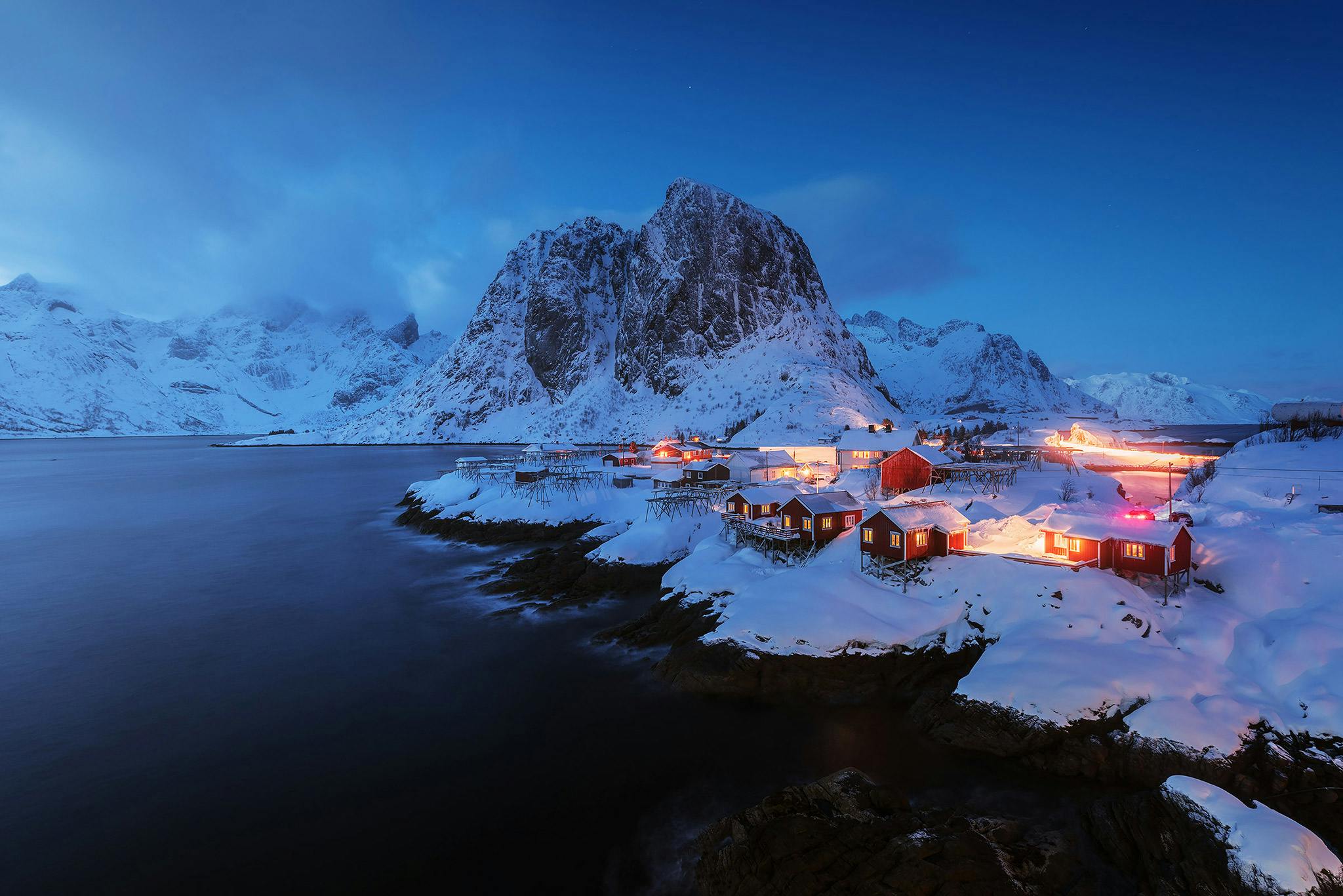
Ultimate Photography Guide to the Lofoten Islands of Norway
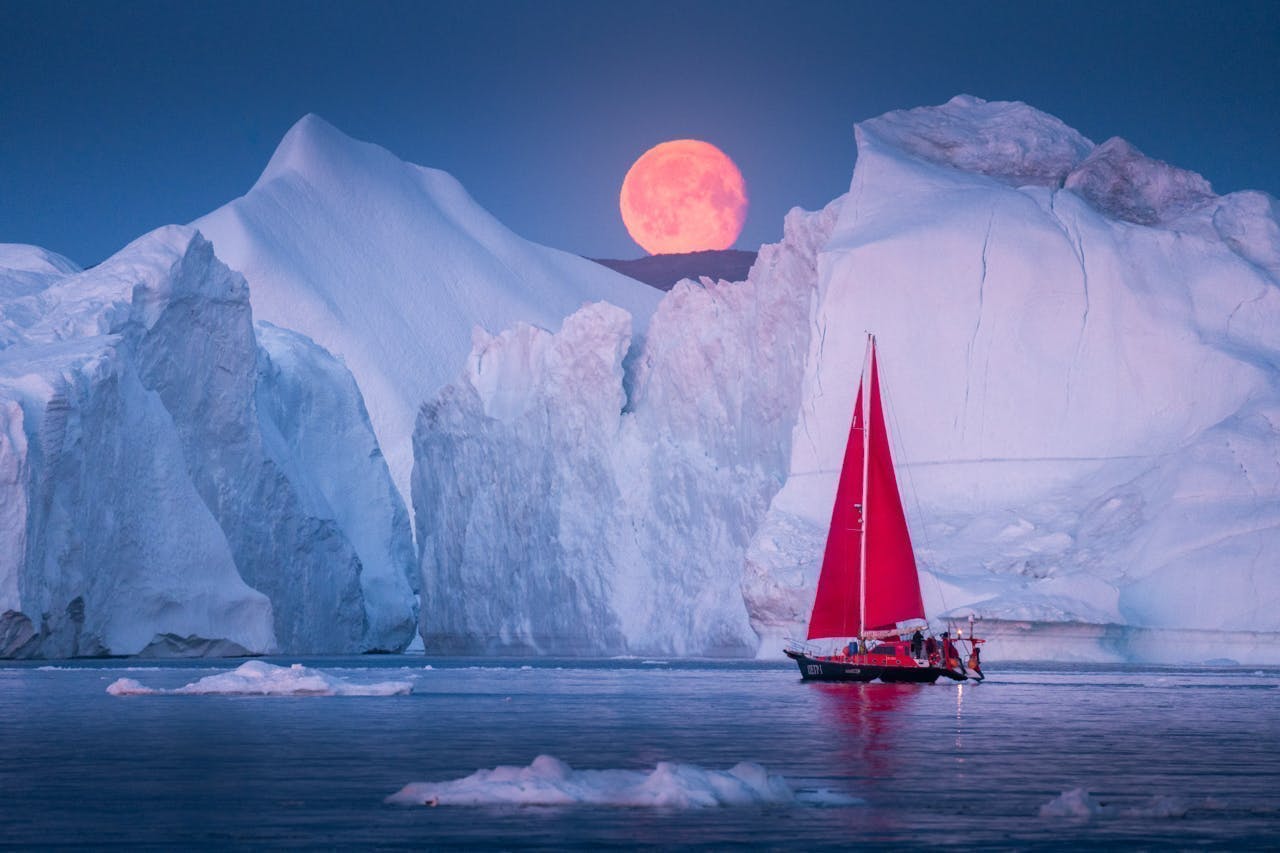
Ultimate Guide to Landscape Photography
Other interesting articles.
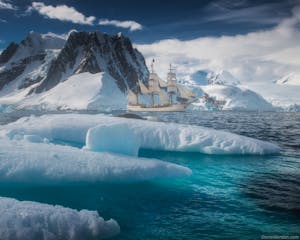
The Ultimate Guide to Cruises to Antarctica
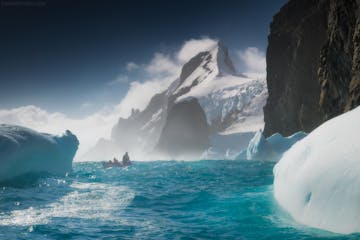
The Ultimate Guide to Climate and Weather in Antarctica
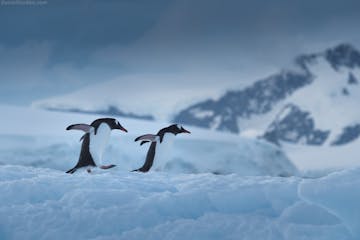
The Ultimate Guide to Wildlife Photography in Antarctica
Popular photo tours & workshops.
Travel the world to capture the most incredible landscapes
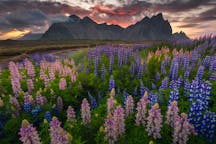
Summer Photo Tours in Iceland
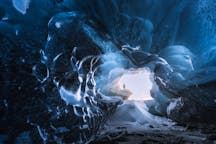
Winter Photo Tours in Iceland

International Photo Tours
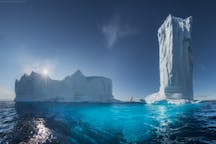
Greenland Photo Tours
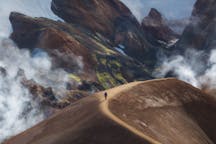
Private Photo Tours in Iceland
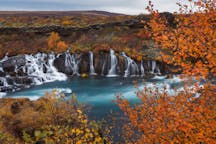
Autumn Photo Tours in Iceland
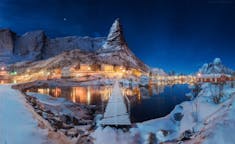
Norway Photo Tours and Workshops
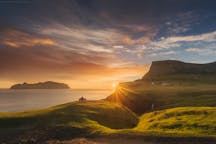
Faroe Islands Photo Tours and Workshops

14 Best Things To Do In Antarctica To Do On Your Expedition
I f ever given the chance to visit the seventh and arguably the most enchanting continent of Antarctica , take it ! I can assure you there is nowhere on the planet quite like it.
Although you might be thinking Antartica is all just icebergs and penguins, you’d be wrong. In fact, there are many unmissable things to do in Antartica that make it a unique and thrilling destination to adventure to.
After having the chance to spend nearly 15 days on a Chilean Naval Icebreaker with a National Geographic team , we learned there is much to discover and enjoy in the cold continent.
In this guide, we’ve shared some of the top attractions in Antartica and the highlights to experience.
We recommend the Antarctica tours from reputable company G Adventures. Not only will the G Expedition steer you closer to some of our planet’s most amazing places, their professional and highly-skilled team of on-board experts offer keen insight, unique perspectives, and hands-on attention not found in a guidebook. See the G Expedition tours and availability here.
1. Marvel at The Magnificent Landscape At Paradise Bay
2. run the antarctic half-marathon or marathon, 3. lick an iceberg, 4. send a postcard from port lockroy, 5. take a selfie with a penguin (and enjoy the other wildlife), 6. take a helicopter ride for an aerial view of antarctica, 7. take a shot with someone at a research base, 8. check out observation hill for a stunning view, 9. visit the south pole, 10. take a dip in deception island’s hot spring, 11. go kayaking around antartica peninsula, 12. go on a whale watching excursion, 13. do a polar plunge, 14. go snowshoeing, best time to visit antartica, how to get to antartica, final thoughts, 15 best things to do in antarctica.
The Antarctic summer starts in December and runs through till about March. The skies are usually bright and the temperature is no colder than a crisp, sunny winter’s day.
The summer is the best time to see Antarctica at its most beautiful, and arguably the best place to witness the beauty of Antartica’s landscapes is at the pristine Paradise Bay .
Paradise Bay is on the West side of Antarctica and the still waters and fascinating icebergs make it the epitome of Antarctica.
Visiting this harbor is simply put— magical.
On a typical summer day you would see exquisite ice sculptures standing tall and majestic, clear skies reflecting all the mightiness of the mountains into the clear bay.
Albatrosses spreading their 11ft wings and filling the skies as leopard seals bask in the sun on an ice float. Time stops still here .
The beauty is breath taking and is the go-to place if you want to experience the magical wonder that is Antarctica!
Read more: How To Visit Antartica on a Ross Sea Expedition.
On King George’s Island in nearly sub-zero conditions there are the Antarctic Half-Marathon and Marathon for those that are the most hardcore!
How great would finishing a race with a nice little medal be, to commemorate the trip to Antarctica?
The first things that I noticed when entering Antarctic territory were the beasts that were the icebergs.
They speckled the water and stood tall against the clear sky. It had always been on my bucket list to lick a real iceberg and where better to cross this off my list than in Antarctica!
Icebergs are never still and are constantly shifting positions due to the wind. For this reason a lot of bigger ships tend to steer clear of these ‘bergs. No one wants a repeat of the Titanic!
The chances come with smaller vessels, primarily Zodiacs . They are must smaller and can navigate around icebergs with ease.
We had the chance to pull up next to a rather small iceberg and see how far into the water it actually went. The old adage is true, what we saw really was “just the tip of the iceberg!”
Getting exciting at the possibility of being able to lick one of these great ice blocks we convinced our zodiac driver to pull in between two icebergs. Needless to say, this was a bad idea.
The imperceptible motions of the icebergs were lost on us and soon we found ourselves trapped between them.
Luckily, a flatboat from a base was returning to shore when they spotted us and were able to aid in our rescue!
If you stop by Port Lockroy make sure to send yourself a cool postcard stamped from Antarctica.
The Port Lockroy Museum used to be the British Base but is now a full time post office.
It is a cute little structure from which you can send yourself mail stamped with Antarctica’s stamp!
The best place to enjoy the frolicking of penguins would be on Paradise Bay . The snow capped mountains in the background with the little creatures in tuxedos happily scampering about is quite a sight.
They love to slide around on their bellies and splash around in the water. Their squawking and cooing is a pleasurable cacophony. Here is the ideal place to watch them play and take photographs.
The penguins on Antarctica aren’t used to humans but they sure aren’t scared of us either. They happily run up to you and circle your feet.
There are several species of penguin in Antartica, such as King Penguins, Gentoo Penguins, and Emperor Penguins. The penguins at Paradise Bay are Gentoo Penguins.
In terms of wildlife there is more to see than just penguins. Sometimes Leopard Seals, Elephant Seals, Fur Seals and Weddell Seals beach themselves on shore to relax after a meal, or even to lie in wait for the oblivious penguins to walk within reach.
These creatures aren’t used to humans either but they are not as friendly as the penguins.
We were advised by the people from the base and the National Geographic Team to leave the seals (and any other creature that wasn’t a penguin) alone, for our own safety.
In fact, it’s not a good idea to pick up or touch the penguins either. Many people do, but it’s not ethical practice and may frighten the penguin so we don’t advocate for this.
It is breathtaking to get an aerial view of Antarctica and its magnificent landscape.
Using a helicopter is probably the best way to travel around the continent and witness the Emperor penguin colonies, or even fly amongst albatross.
A popular spot to fly over is the Weddell Sea region, which is known for its wildlife.
You may also be in with a chance of seeing humpback whales, orcas, right whales swimming in the ocean, or see seals basking on ice floes.
It’s an odd thing when you ask someone where home is and their answer is Antarctica.
This is quite the case for the roughly 4,000 people that call Antarctica home during the summer months and the 1,000 that stay there during the winter as well!
Having a look into a base you wouldn’t even realize that you were on Antarctica. In fact, there are 70 permanent bases on the continent, each belonging to a different country – though not all of them are open to the public.
There’s a rather up-to-date facility at Base O’Higgins, a base belonging to Chile. They are staffed with all the amenities one could hope for including a basketball court!
Some other research stations you can visit as a tourist are Vernadsky Station , which is owned by Ukraine, Brown Station , Carlini Base , and Cámara Station which belong to Argentina .
So go ahead, be bold, as to take a shot (whether a drink or with a camera) with a person from within one of these awesome bases.
If you’re looking for an incredible view of the snowy peaks and icebergs, then head to the McMurdo Station and trek up Observation Hill .
It is not that much of a trek from the station (roughly 30-40 minutes) with an elevation of 754-foot (230 meter), but the view from the top is stunning. Though be warned, it’s a steep trek!
There is a beautiful view of the Ross Ice Shelf and views of Mt. Erebus ; the perfect spot for quiet reflection.
The South Pole lies at 90°S and 0°W . The best way to access this point is via helicopter, because it’s quicker and safer.
However, you can also reach the South Pole by trekking. The trek is not for the faint hearted though – you need to be equipped with specialized polar gear, designed to withstand the harsh conditions of the icy continent.
You can also reach the South Pole by vehicle.
Standing at the South Pole is how one can claim that they have indeed reached all the way to the bottom of the Earth. You can also visit the US Scientific research base known as the Amundsen – Scott South Pole Station.
Another bucket list thing to do in Antartica is experience the joy of bathing in a hot spring in Antarctica. Yes, you heard me! Strip down and swim around in warm Antarctic waters!
On Deception Island , at the South Shetlands in Antarctica , there is warm volcanic soil and even warmer water underground. This is because the island sits in a caldera above an active volcano.
If you’re feeling particularly brave you can wade into the warm shore water or else just dig up some of the volcanic soil and climb into a steaming hot pool of water right on Antarctica’s mainland!
One of the best ways to see Antartica is to get out on the water. Grab your paddles and life vest, and kayak around the icebergs and sheets of glacial ice.
While most cruise expeditions will have smaller zodiac cruises that take you to land, a kayak tour is a great way to get up close and personal with the landscape and wildlife.
While you might be anxious about the water conditions, the water around the Antarctic Peninsula is usually very still and calm, since it’s protected by the glaciers.
Sometimes it’s even possible to be greeted by curious whales in the waters.
Check out kayak tours in Antarctica here!
Not trip to Antarctica would be complete without taking a whale-watching adventure to see these majestic creatures in their natural habitat.
Antarctica boasts an abundance of whale species, including humpback, orca, minke, and blue whales. The sheer size and grace of these magnificent animals as they breach, tail-slap, and swim alongside your zodiac vessel is a sight to behold.
Not only do you get to witness their behavior, but you can learn about their conservation needs through expert guides and educational lectures onboard your expedition vessil.
Does the idea of taking a dive in cold water scare you? That’s exactly why you should do it!
The most thrilling thing to do in Antarctica is to take a cold plunge. This is when you strip down to your swimsuit, attach a safety rope around your waist, and dive in.
Sometimes shots are supplied so you can warm your insides up before and after. After all, you may need to be a little tipsy to take this challenge on!
Another great way to see the landscape of Antartica is to for a hike in snowshoes.
Imagine strapping on snowshoes and traversing through vast expanses of untouched snow, surrounded by towering glaciers, majestic mountains, and an endless white horizon.
It’s a chance to immerse yourself in the serene beauty of Antarctica, exploring areas inaccessible by other means.
The best time to visit Antarctica is during the summer, which runs from November to March.
During this time, the temperatures are relatively mild, ranging from -2°C to 8°C (28°F to 46°F).
The days are longer, with up to 20 hours of daylight, allowing for more time to explore and admire the stunning landscapes.
Wildlife is also abundant during this period, with penguins, seals, and whales being easily spotted.
The best time to see nesting penguins and baby penguins hatching is from November and early December, while late February and March are the best months to do whale watching as they migrate through the Drake Passage.
Antartica isn’t a destination where you can simply book a flight and go. There’s only one way to visit the continent as a tourist, and that’s on an Antarctic Cruise or by joining as a volunteer/research on an Antarctic Expedition.
Before booking a cruise expedition, be sure to research reputable tour operators.
Most travelers reach this icy paradise by boarding a cruise ship from Ushuaia, Argentina, which serves as the gateway to the Antarctic Peninsula and the Falkland Islands.
Alternatively, some opt for fly-cruise options, where they first take a flight to Punta Arenas, Chile, before boarding a ship.
It’s important to choose a voyage that suits your preferences and budget, though the cheapest cruise that we’ve come across is still around $4000 USD per person for ten days.
Note that the only way to reach Antarctica is to sail through Drake Passage, a notoriously rough section of ocean where waves can reach 12 meters (40 feet). Be sure to pack plenty of motion sickness tablets.
So there you have it, those are the best things to do in Antartica, and as you can see, there’s a lot of cool things to see and do.
Since most people visit Antartica as part of a cruise, be sure to check out what excursions and activities they have planned to help you decide on what to do.
Some cruises have workshops and educational talks, as well as additional excursions you can take.
The beauty of visiting Antartica is that much of the planning is done for you when you purchase an expedition package, but we hope this guide gave you some inspiration for what activities to look for when booking an expedition.
Have you been to Antarctica before? Is it on your bucket list now? Let us know in the comments.
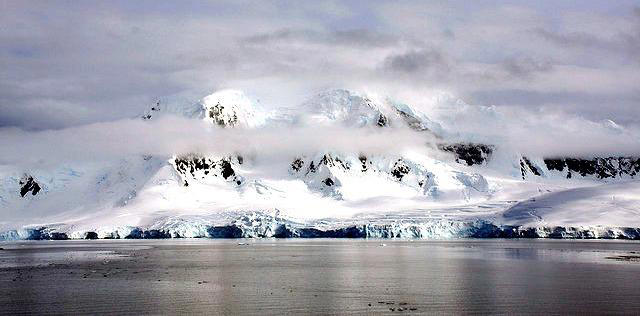
More From Forbes
‘out in the world’: a travel guide for the lgbtqia+ community.
- Share to Facebook
- Share to Twitter
- Share to Linkedin
Venice — one of destinations featured in 'Out In The World'
‘ Out in the World: An LGBTQIA+ (and Friends!) Travel Guide to More Than 100 Destinations Around the World ’ is National Geographic’s first travel book aimed at the LGBTQIA+ community. Authors Amy B. Scher and Mark Jason Williams dive into 120 destinations — from Austin to Antarctica — and what makes them both great vacations as well as inclusive for every traveler. I spoke with Scher and Williams about the need for this book and what they love most about travel.
What motivated you to write a travel book for the LGBTQIA+ community?
Mark Jason Williams : We wrote this book because it didn't exist. The LGBTQIA+ section in travel guides is usually in the back and focused on hotspots and bars and clubs. Those things are great but they're not for everyone. Sometimes I want to go to a small town and go antiquing and stay in a welcoming inn. We wanted to create a book that was inclusive and provided lots of different ideas and inspirations for various types of travelers.
Amy B. Scher : Our litmus test for this book was is this somewhere we could take our mom ? We want the same diversity that other communities have access to. We all know the places to go for Pride, what can we do beyond that? There's drag brunches in the book but also places you could go on a family reunion. The idea was to create a curated list of safe and welcoming destinations.
How has being part of a same-sex couple affected your travel experiences?
ABS : Until I met my future wife I had never dated women before. As a single woman I had to think about places I could and couldn’t go — like many straight people. But I never thought about places I couldn’t go as a same-sex couple. When we got married I wanted to go to Marrakesh. I was lovingly told by some family members that — at that time — they worried it might not be welcoming. It made me understand what the community deals with, not being able to freely be themselves as they travel. But I’m happy to say that things have really changed there and it looks like we’re finally going after 15 years together.
Out in the World
Fallout Dethroned In Amazon Prime Video s Top 10 List By A New Offering
Google chrome gets second emergency update in a week as new exploit confirmed, metallica makes history with their new no 1 single.
MJW : My husband and I checked into this boutique hotel once and there was a welcome card that started with “Welcome Mr. & Mrs.” I was upset because I had exchanged emails with the concierge and they knew that we were a gay couple. I brought it to the attention of the innkeeper. She said, “I have a lot of gay friends. We're not homophobic.” And that made me realize: we're beyond the obvious homophobia but there are still ways we’re not being welcoming to the community.
What was one of your favorite places you travelled for the book?
MJW : Antarctica is one of the most epic mind-blowing soul-healing journeys that I've ever been on. You're at the end of the world. I was so close to a whale that I could hear it breathe. The penguins. The glaciers. The astounding scenery and wildlife.
ABS : One of my biggest surprises was the Hill Country that surrounds Austin, Texas. Most people know that Austin is very LGBTQIA+ friendly, but as my wife and I got further out in some of these tiny towns we felt very welcome. And I don't think that's a place that I would've gone many years ago.
Author Amy B. Scher
Is the book purely positive or also cautionary about places not to travel?
ABS : It’s overwhelmingly positive. It’s mini-guides to 120 curated destinations. What to do, see and where to eat and stay. A sample itinerary and a taste of all the possibilities. If a business is in the book that means we like them.
But there are also caveats that maybe in this place, you want to exercise this type of caution or be more conscious in terms of public displays of affection.
Is that one of the more frustrating aspects of traveling with a same-sex partner?
MJW : People universally want to have the same freedom as the straight community to hold each other's hands or sneak a kiss. But if you are going to a place where PDA is frowned upon and you can't go without holding somebody's hand — maybe that just isn't the place for you.
In some countries the resorts are in a bubble and are going to be welcoming to the LGBTQIA+ community. Holding your partner's hand on the beach is going to be fine. But if outside the resort is a less progressive place where I would say don’t do that — then you need to ask yourself if the concession is worth it.
Author Mark Jason Williams
Are there locations where you give separate advice for different members of the LGBTQIA+ community?
ABS : Each chapter has an LGBTQIA+ lowdown which does point out when certain parts of the community should be more aware. But we also point out a lot of positives. Like in this particular area trans rights and inclusiveness has come really far or this place is very popular with lesbian couples .
What surprised you most while researching the book?
MJW : Even in less progressive U.S. states there are welcoming pockets and very inclusive communities. There’s Galena, Illinois or Eureka Springs in Arkansas. Kentucky has Louisville. There were more pride flags and LGBTQIA+ owned and welcoming businesses there than I ever would've realized. Same thing with Salt Lake City, which per capita has more LGBTQIA+ identifying people than Los Angeles. Don't rule out a place because of political beliefs.
Are there ways straight travelers can help make destinations more inclusive?
ABS: One way is to support businesses that outwardly state they're welcoming to the community. Put money into those places so they can continue to operate. It’s a vacation and you certainly don’t have to look up every business. But spending a few extra minutes sometimes can make a big difference to the community.
MJW: If you are a straight person traveling with an LGBTQIA+ person, sometimes they may need a little space and that's okay. There may be a bar they want to go to on their own and if they don’t want company don’t take it personally. And if they don’t feel comfortable in a particular space and want to leave don’t undermine their feelings. It's small things but they do go a long way.
- Editorial Standards
- Reprints & Permissions
Join The Conversation
One Community. Many Voices. Create a free account to share your thoughts.
Forbes Community Guidelines
Our community is about connecting people through open and thoughtful conversations. We want our readers to share their views and exchange ideas and facts in a safe space.
In order to do so, please follow the posting rules in our site's Terms of Service. We've summarized some of those key rules below. Simply put, keep it civil.
Your post will be rejected if we notice that it seems to contain:
- False or intentionally out-of-context or misleading information
- Insults, profanity, incoherent, obscene or inflammatory language or threats of any kind
- Attacks on the identity of other commenters or the article's author
- Content that otherwise violates our site's terms.
User accounts will be blocked if we notice or believe that users are engaged in:
- Continuous attempts to re-post comments that have been previously moderated/rejected
- Racist, sexist, homophobic or other discriminatory comments
- Attempts or tactics that put the site security at risk
- Actions that otherwise violate our site's terms.
So, how can you be a power user?
- Stay on topic and share your insights
- Feel free to be clear and thoughtful to get your point across
- ‘Like’ or ‘Dislike’ to show your point of view.
- Protect your community.
- Use the report tool to alert us when someone breaks the rules.
Thanks for reading our community guidelines. Please read the full list of posting rules found in our site's Terms of Service.

COMMENTS
The safest and most environmentally-responsible way to see penguins in Antarctica is to join a polar expedition with knowledgeable polar experts onboard who follow strict wildlife-viewing guidelines. Quark Expeditions, which has been exploring the Polar Regions for three decades—longer than any other operator—includes penguinologists ...
An Emperor Penguin rookery is situated south of Snow Hill Island in the Weddell Sea, on the east side of the Antarctic Peninsula. The captain of the vessel will do his utmost to position the vessel close enough to Snow Hill Island in order to enable the expedition team to offer ship-to-shore helicopter transfers to approximately 45 minutes ...
Antarctica emperor penguin tours offer an extraordinary opportunity to witness the captivating beauty of emperor penguins in their natural habitat. Embarking on a trip to Antarctica solely to see these remarkable creatures isn't unheard of, and is often a dream come true for wildlife enthusiasts and photography enthusiasts alike. ...
Call us at 206.669.9272 / 800.861.6425. Prefer online? Get in Touch. A Year in the Life of an Emperor Penguin. In April, at the end of the Antarctic summer, Emperor Penguins will begin their march to their traditional breeding grounds—a journey across the frozen ice that can be as long as 90 miles. Unlike most bird species, the Emperor ...
2. Antarctic Sound. Antarctic Sound is one of the best places in the region to see Adelie penguins as more than 135,000 breeding pairs live on Hope Bay. PA. Only 15kms wide at its narrowest part, the Antarctic Sound is a channel at the north-eastern end of the Antarctic Peninsula. Also known as Iceberg Alley, it connects the Bransfield Strait ...
The best place to see penguins in Antarctica also is at Cape Royds Station. This station is near the Ross Ice Shelf, one of the largest ice shelves in the world. You also can see Adelie penguins at McMurdo Station, Scott Base and Amundsen-Scott South Pole Station. ... Karen Edwardsi s an award-winning travel and lifestyle journalist and ...
Antarctica Whale Safari. Embark on a once-in-a-lifetime adventure to the icy wilderness of Antarctica in search of cetaceans, pinnipeds, and seabirds, including numerous species of penguin. This whale watching voyage is perfectly timed during peak season, when the whales are most active and sightings are at their best.
In 2018, Quark Expeditions scheduled four trips to see Emperor penguins during the period of October to November, which they determined the best times to see Emperor penguins in Antarctica. The timing of these trips is based on a number of factors—including weather and ice conditions. Snow Hill Island is not only remote but it's hard to reach.
Weddell Sea - In search of the Emperor Penguin, incl. helicopters. Searching for the Elusive Emperor Penguins. OTL23-24 A true expedition, our Weddell Sea cruise sets out to explore the range of the Emperor Penguins near Snow Hill Island. We will visit the area via helicopter and see a variety of other birds and penguins including Adélies and Gentoos.
Extensions. Call us today on +31 (0) 858 771 583. Fly to the Antarctica continent and camp on the sea ice where thousands of Emperor Penguins come to raise and feed their young. One of the most unique wildlife experiences on earth!
Snow Hill Island. Snow Hill Island is probably the most popular destination for people wanting to see emperor penguins. Located in the Weddell Sea, Snow Hill Island lies just off the east coast of the Antarctic Peninsula and is home to a colony of 8,000 emperor penguins. Only a small number of ships make the journey to this inhospitable island ...
About Antartica's penguin species. Penguins can be found in the Antarctic Peninsula, the sub-Antarctic islands and all the nutrient-rich waters in between.. The largest penguin species in the world is the magnificent Emperor Penguin (of The March of the Penguins fame) which lives exclusively in Antarctica and can grow up to 1.1m in height and weigh up to 35kg!
Antarctica wildlife tours offer extraordinary opportunities to witness diverse and abundant wildlife, including penguins, seals, whales, and seabirds. These tours provide immersive experiences, expert guides, and the chance to explore one of the world's most pristine ecosystems.
A once-in-a-lifetime trip to see a coveted colony of penguins is now available, but it's costly! Here's everything you need to know if you love penguins and are ready to splurge! Emperor Penguin Quest. The Emperor Penguin Quest: Expedition to Snow Hill will return in November 2023 thanks to polar explorers with Quark Expeditions. The 14-day ...
The Weddell Sea—Emperor Penguin Voyage is one of the most spectacular Antarctic adventures around. This 11-day expedition cruises aboard the 108-passenger ship M/V Ortelius and offers the unique experience of close emperor penguin encounters at their more secluded rookeries via exciting helicopter rides. Finish the voyage passing through the ...
According to the British Antarctic Survey, the total penguin breeding population in the Antarctic has been estimated at about 20 million pairs, making the number of penguins in Antarctica approximately 40 million.It seems a lot, but when you consider that emperor penguins when huddled together during winter can reach a density of 19 birds per square meter, perhaps less surprising!
There are an estimated 2.5 million breeding pairs of Adélie penguins in Antarctica. They weigh from 3.6 to 6.0 kg (7.9 to 13.2 pounds), grow between 46 to 71 cm (18 to 28 inches) tall, and their preferred diet is fish and krill. Though Adélie penguins can dive to 175 meters (574 feet), they usually catch their meals near the surface.
The elusive emperor penguin. The reason for this is that emperor penguins prefer to live their entire lives without setting foot on solid ground. The classic Peninsula penguin species like gentoos, Adelies and chinstarps all breed on Antarctica's rocky shores, making simple nests from pebbles. Emperor penguins are made of much tougher stuff.
They are most active during this period and can be seen on virtually all trips to the Antarctic Peninsula. Chinstrap Penguins: The Abundant Species with a Namesake Marking. ... The best time to see penguins in Antarctica is during the austral summer, from December to February, when they are breeding and raising their chicks.
A costly trip. As is the case with all Antarctica trips, Silversea's new Antarctica Bridge trips are not inexpensive. Eleven available departures of the eight-night itinerary between now and December 2023 start at $16,600 per person, including flights -- more than $2,000 per day.
By the time February rolls around, all the teenagers have become adults and then all the penguins look pretty much the same again. Mid to late February is the time when penguins head back into the sea so it's important for penguin lovers to choose a trip that leaves the Antarctic Peninsula by Feb 22. Late February departures won't see as many penguins as you would have seen earlier in the ...
The best time to see penguin chicks in Antarctica is late January through the end of February. Viewing penguins is a highlight for most travelers visiting Antarctica. Travelers can see up to eight species of penguin in Antarctica. Virtually all trips to the Antarctic Peninsula will see gentoo, adelie and chinstrap penguins. If you really want ...
Depending on what you want to do or see during your trip to Antarctica, you might favor an expedition earlier in the season or near the end. Certain months are better for camping and hiking on the continent, or for photographing whales and penguins. ... By December, visitors are more likely to see penguin hatchlings. I traveled to Antarctica in ...
See our popular Antarctica Photography Tours & Workshops. Antarctica Fly/Sail Photography Expedition 20 February to 3 March 2025; Falklands & South Georgia - Antarctica Photography Tour ... While it is possible to book cruises and other trips that will give you the potential to see penguins in Antarctica, taking an Antarctic photo workshop is a ...
See the G Expedition tours and availability here. Table Of Contents. 15 Best Things To Do In Antarctica. 1. Marvel at The Magnificent Landscape At Paradise Bay. 2. Run the Antarctic Half-Marathon ...
Pilgrimage to see the penguins of South Georgia About 1300 kilometres east of the Falklands, far-flung South Georgia and the South Sandwich Islands are accessible only by ship. Known as the Galapagos of the Southern Ocean, the mountainous island of glaciers supports an incredible array of birdlife such as yellow-quiffed Macaroni penguins ...
Cruise. The 2025-26 season for Le Commandant Charcot features two itineraries travelling to Charcot Island and the Bellingshausen Sea. In the wake of Jean Baptiste Charcot from $32,640 a person in ...
MJW: Antarctica is one of the most epic mind-blowing soul-healing journeys that I've ever been on. You're at the end of the world. I was so close to a whale that I could hear it breathe. The penguins.
Antarctic English is a variety of the English language spoken by people living on the continent of Antarctica and within the subantarctic islands.: vii Spoken primarily by scientists and workers in the Antarctic tourism industry, it consists of various unique words and is spoken with a unique accent.During the 19th and 20th centuries, Antarctic English was influenced by Spanish-speaking South ...